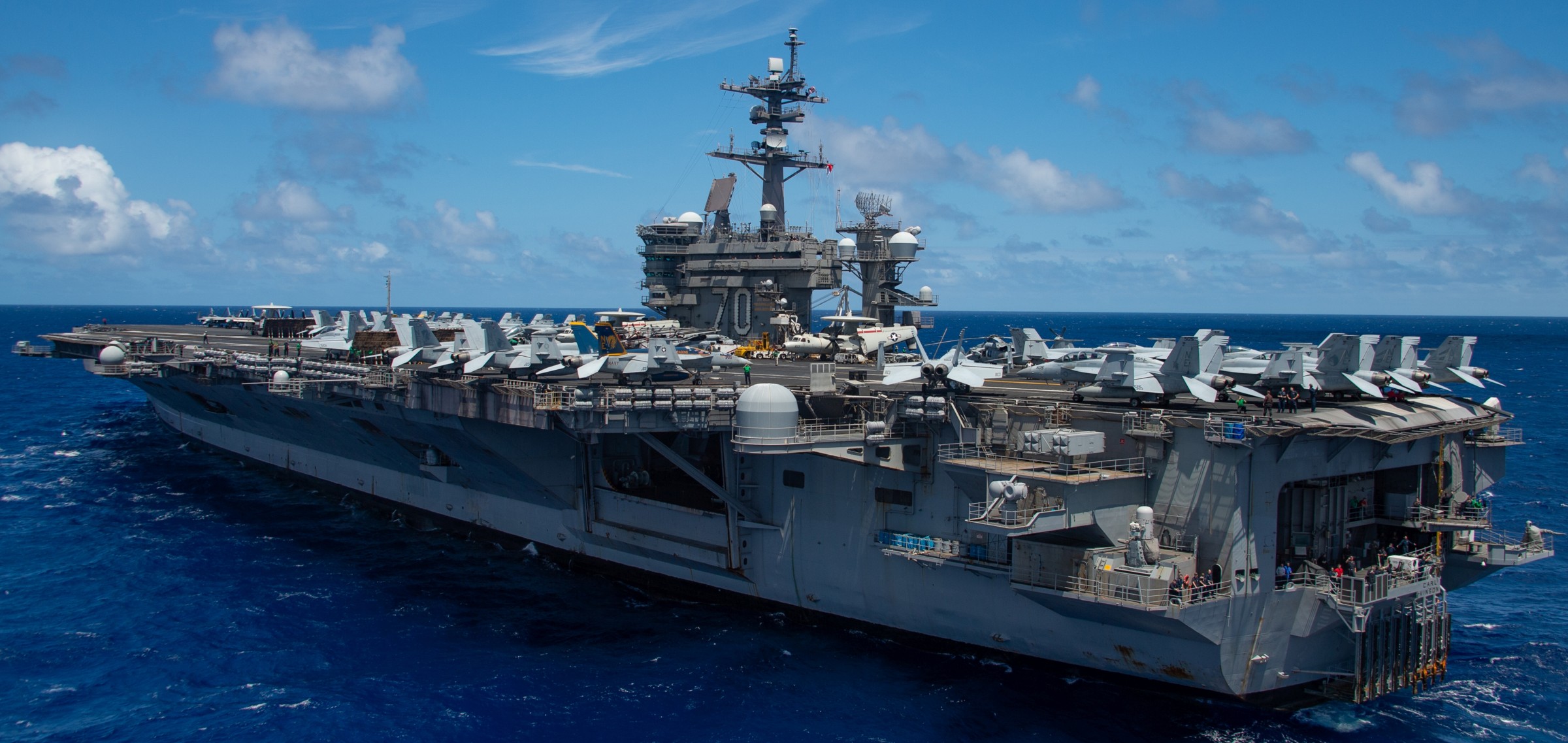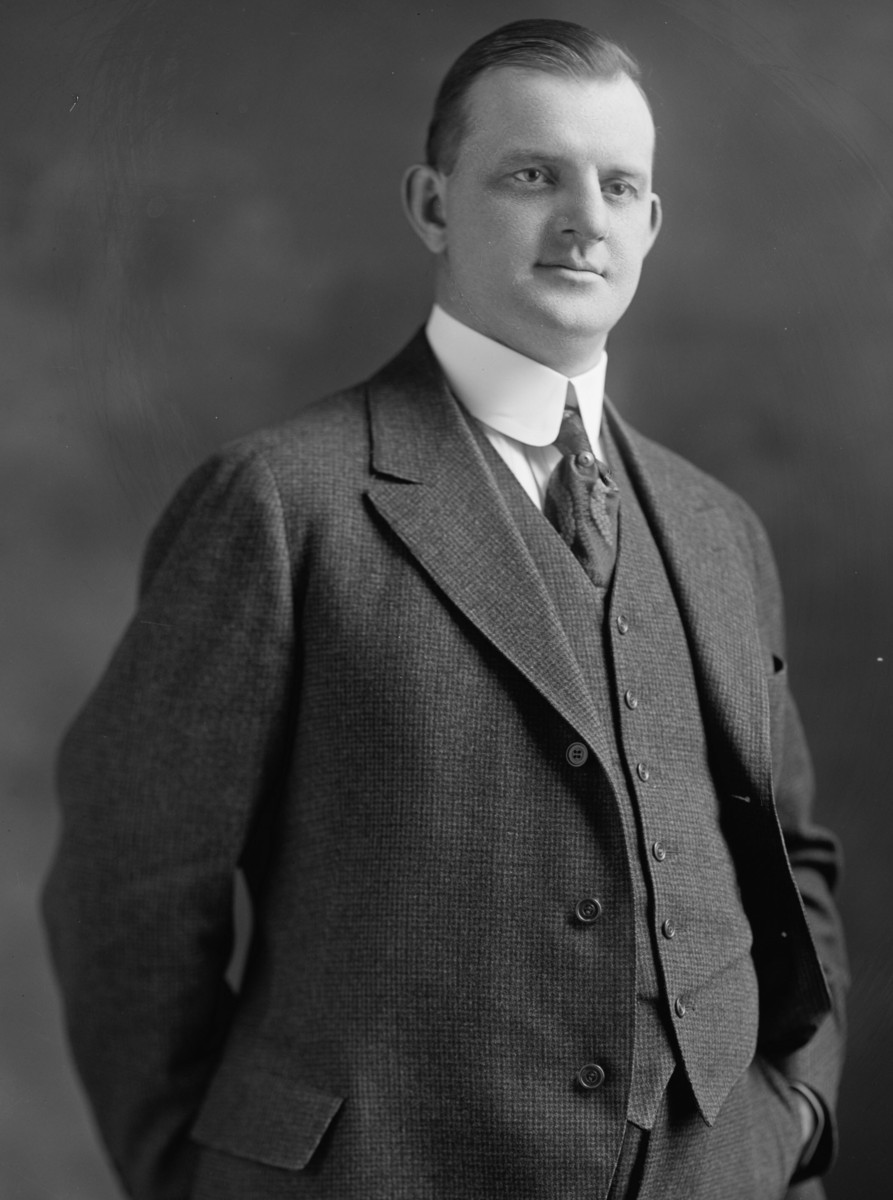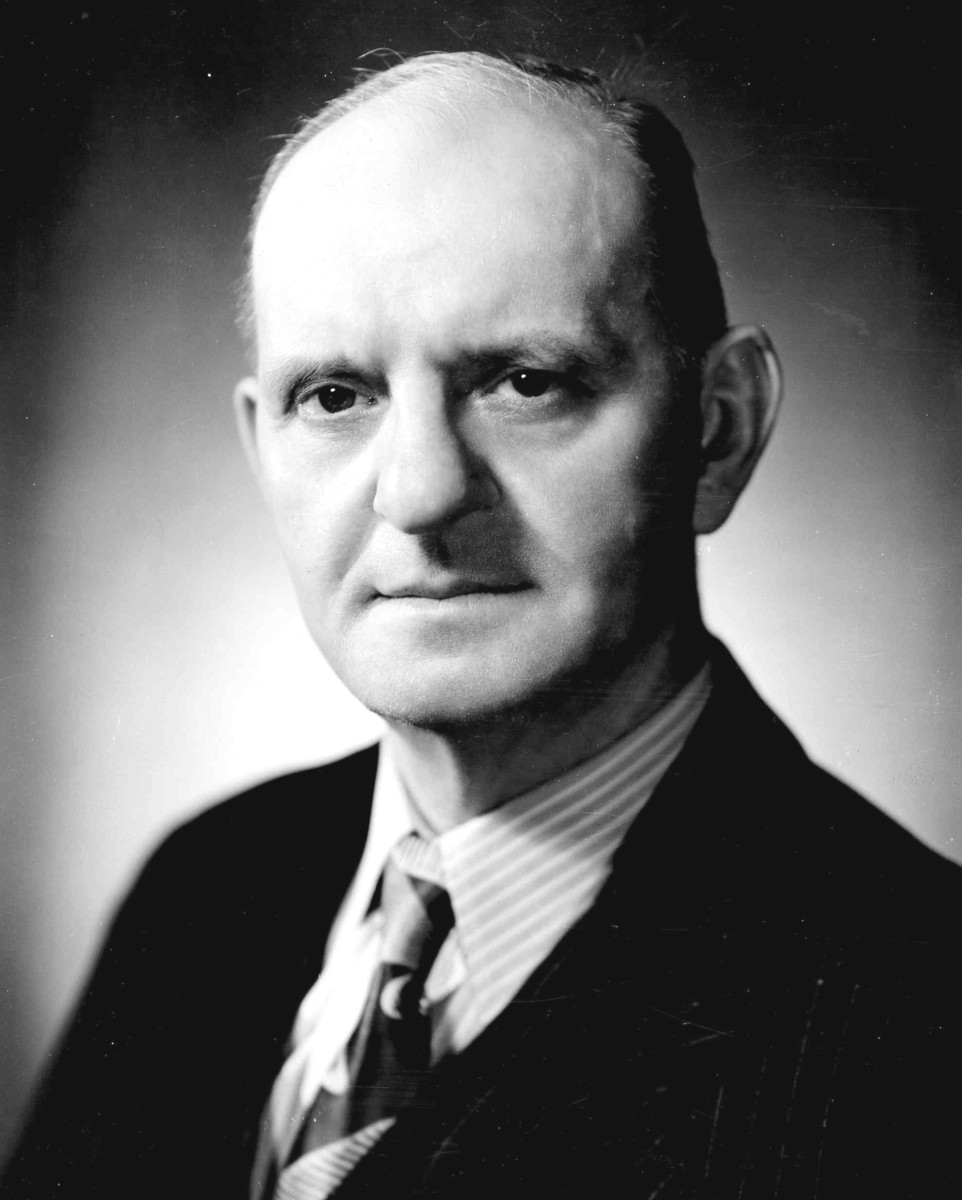 |
||
|
HOME
|
US Navy -
ships
|
US Navy - air
units
|
USMC - air
units
|
International
Navies
|
Weapon Systems
|
Special Reports |
||
|
US Navy - Aircraft Carrier CVN 70 - USS Carl Vinson |
||
|
||
| 08/25 | ||
|
Type, class:
Aircraft Carrier - CVN; Nimitz class Builder: Newport News Shipbuilding, Newport News, Virginia, USA STATUS: Awarded: April 5, 1974 Laid down: October 11, 1975 Launched: March 15, 1980 Commissioned: March 13, 1982 IN SERVICE Homeport: NAS North Island, San Diego, California Namesake: Congressman Carl Vinson (1883-1981) Ships Motto: VIS PER MARE (strenght from the sea) Technical Data: see: INFO > Nimitz class Aircraft Carrier - CVN |
||
|
Deployments / Carrier Air Wings embarked / major maintenance periods: April 1982 - June 1982 with Carrier Air Wing 15 (CVW-15) - shakedown cruise June 1982 with Reserve Carrier Air Wing 20 (CVWR-20) - western Atlantic August 1982 - December 1982 Post Shakedown Availability (PSA) - at Newport News Shipbuilding, Virginia March 1983 - October 1983 with Carrier Air Wing 15 (CVW-15) - from Norfolk to NAS Alameda - World cruise May 1984 - July 1984 with Carrier Air Wing 15 (CVW-15) - exercise RIMPAC 84 October 1984 - May 1985 with Carrier Air Wing 15 (CVW-15) - western Pacific, Indian Ocean May 1986 - June 1986 with Carrier Air Wing 15 (CVW-15) - exercise RIMPAC 86 August 1986 - February 1987 with Carrier Air Wing 15 (CVW-15) - western Pacific, Indian Ocean June 1988 - December 1988 with Carrier Air Wing 15 (CVW-15) - western Pacific, Indian Ocean September 1989 - November 1989 with Carrier Air Wing 15 (CVW-15) - Pacific Ocean February 1990 - July 1990 with Carrier Air Wing 15 (CVW-15) - western Pacific, Indian Ocean September 1990 - April 1993 Complex Overhaul (COH) - at Puget Sound Naval Shipyard, Bremerton, Washington February 1994 - August 1994 with Carrier Air Wing 14 (CVW-14) - western Pacific, Indian Ocean, Arabian Gulf May 1996 - November 1996 with Carrier Air Wing 14 (CVW-14) - western Pacific, Indian Ocean, Arabian Gulf May 1998 - June 1998 with Carrier Air Wing 11 (CVW-11) - exercise RIMPAC 98 November 1998 - May 1999 with Carrier Air Wing 11 (CVW-11) - western Pacific, Arabian Gulf October 1999 - September 2000 Drydocking Planned Incremental Availability (DPIA) - at Puget Sound Naval Shipyard July 2001 - January 2002 with Carrier Air Wing 11 (CVW-11) - western Pacific, Arabian Gulf March 2002 - September 2002 Planned Incremental Availability (PIA) - at Puget Sound Naval Shipyard January 2003 - September 2003 with Carrier Air Wing 9 (CVW-9) - Pacific Ocean January 2005 - July 2005 with Carrier Air Wing 9 (CVW-9) - Pacific Ocean, OEF / World Cruise from Bremerton, WA to Norfolk, VA November 2005 - July 2009 Refueling and Complex Overhaul (RCOH) - at NS Norfolk, Virginia and Newport News Shipbuilding, VA January 2010 - April 2010 with Carrier Air Wing 17 (CVW-17) - humanitarian ops. off Haiti & Norfolk to San Diego around Cape Horn November 2010 - June 2011 with Carrier Air Wing 17 (CVW-17) - western Pacific, Arabian Gulf November 2011 - May 2012 with Carrier Air Wing 17 (CVW-17) - western Pacific, 5th Fleet AOR August 2012 - February 2013 Planned Incremental Availability (PIA) - at NAS North Island, San Diego, California August 2014 - June 2015 with Carrier Air Wing 17 (CVW-17) - western Pacific, 5th Fleet AOR January 2017 - June 2017 with Carrier Air Wing 2 (CVW-2) - Pacific Ocean January 2018 - April 2018 with Carrier Air Wing 2 (CVW-2) - Pacific Ocean June 2018 - August 2018 with Carrier Air Wing 2 (CVW-2) - Pacific Ocean / RIMPAC February 2019 - August 2020 Drydocking Planned Incremental Availability (DPIA) - at Puget Sound Naval Shipyard, Bremerton August 2021 - February 2022 with Carrier Air Wing 2 (CVW-2) - Pacific Ocean May 2022 - December 2022: Planned Incremental Availability (PIA) at Naval Base San Diego, California October 2023 - February 2024 with Carrier Air Wing 2 (CVW-2) - Pacific Ocean June 2024 - August 2024 with Carrier Air Wing 2 (CVW-2) - Pacific Ocean - Exercise RIMPAC 24 November 2024 - August 2025 with Carrier Air Wing 2 (CVW-2) - Pacific Ocean, 5th Fleet AOO Carrier Air Wing 2 (CVW-2) squadrons 2025: Strike Fighter Squadron 2 / VFA-2 Bounty Hunters - F/A-18F Super Hornet Strike Fighter Squadron 97 / VFA-97 Warhawks - F-35C Lightning II Strike Fighter Squadron 113 / VFA-113 Stingers - F/A-18E Super Hornet Strike Fighter Squadron 192 / VFA-192 Golden Dragons - F/A-18E Super Hornet Carrier Airborne Early Warning Squadron 113 / VAW-113 Black Eagles - E-2D Hawkeye Electronic Attack Squadron 136 / VAQ-136 Gauntlets - EA-18G Growler Helicopter Sea Combat Squadron 4 / HSC-4 Black Knights - MH-60S Seahawk Helicopter Maritime Strike Squadron 78 / HSM-78 Blue Hawks - MH-60R Seahawk Fleet Logistics Multi-Mission Squadron 30 Det. 1 / VRM-30 Titans - CMV-22B Osprey |
||
| images | ||
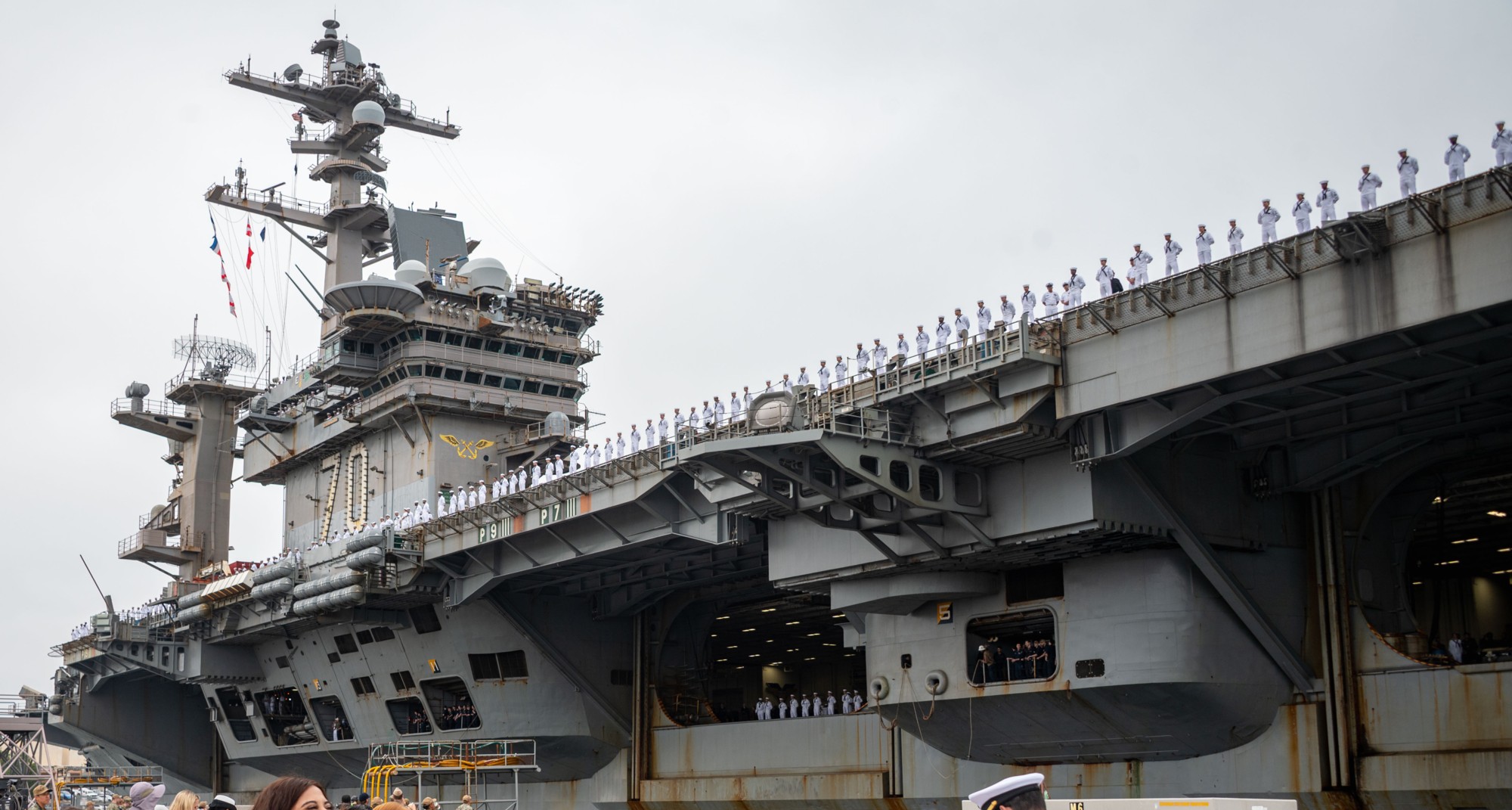 returning to NAS North Island, San Diego, California - August 13, 2025 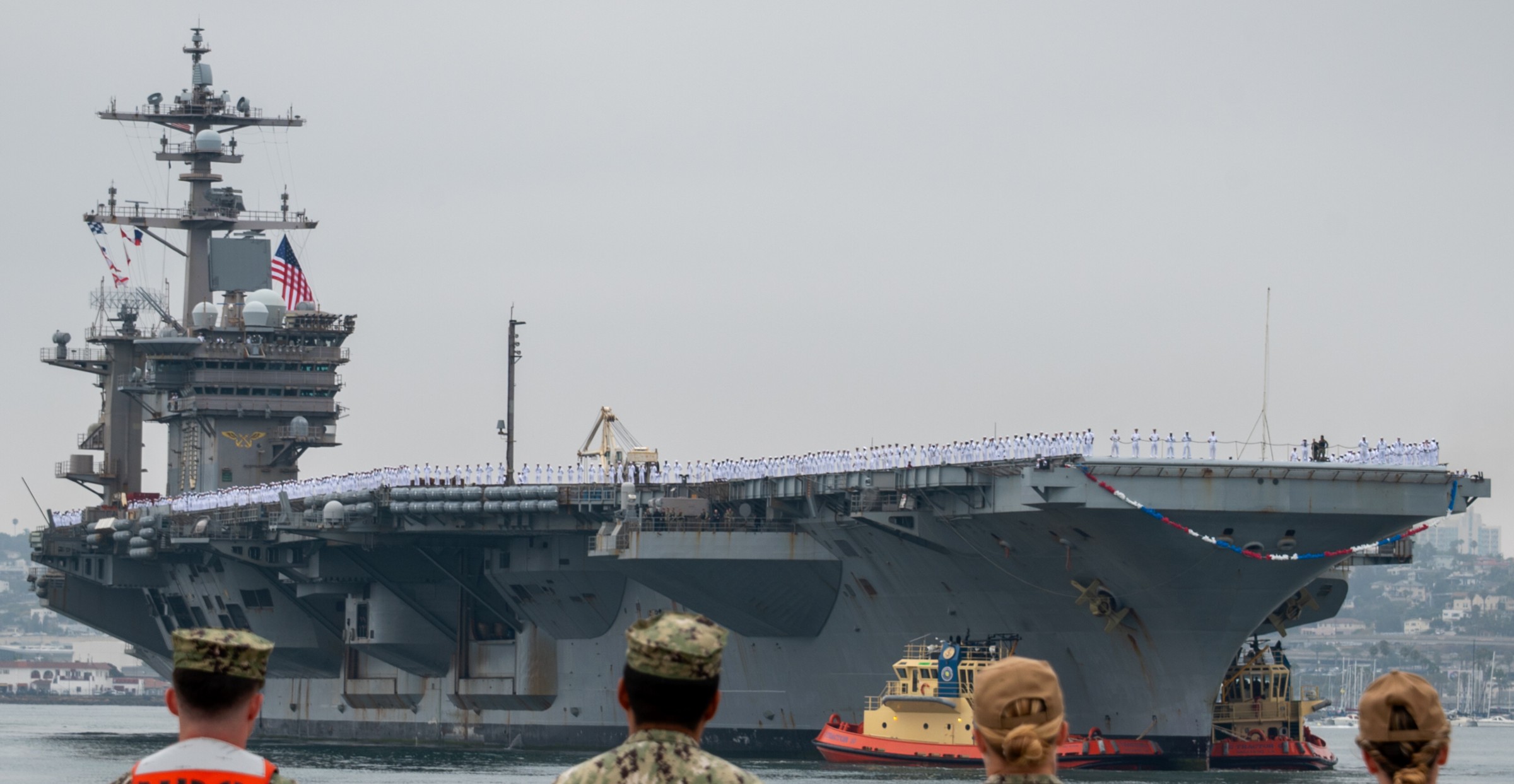 returning to NAS North Island, San Diego, California - August 13, 2025 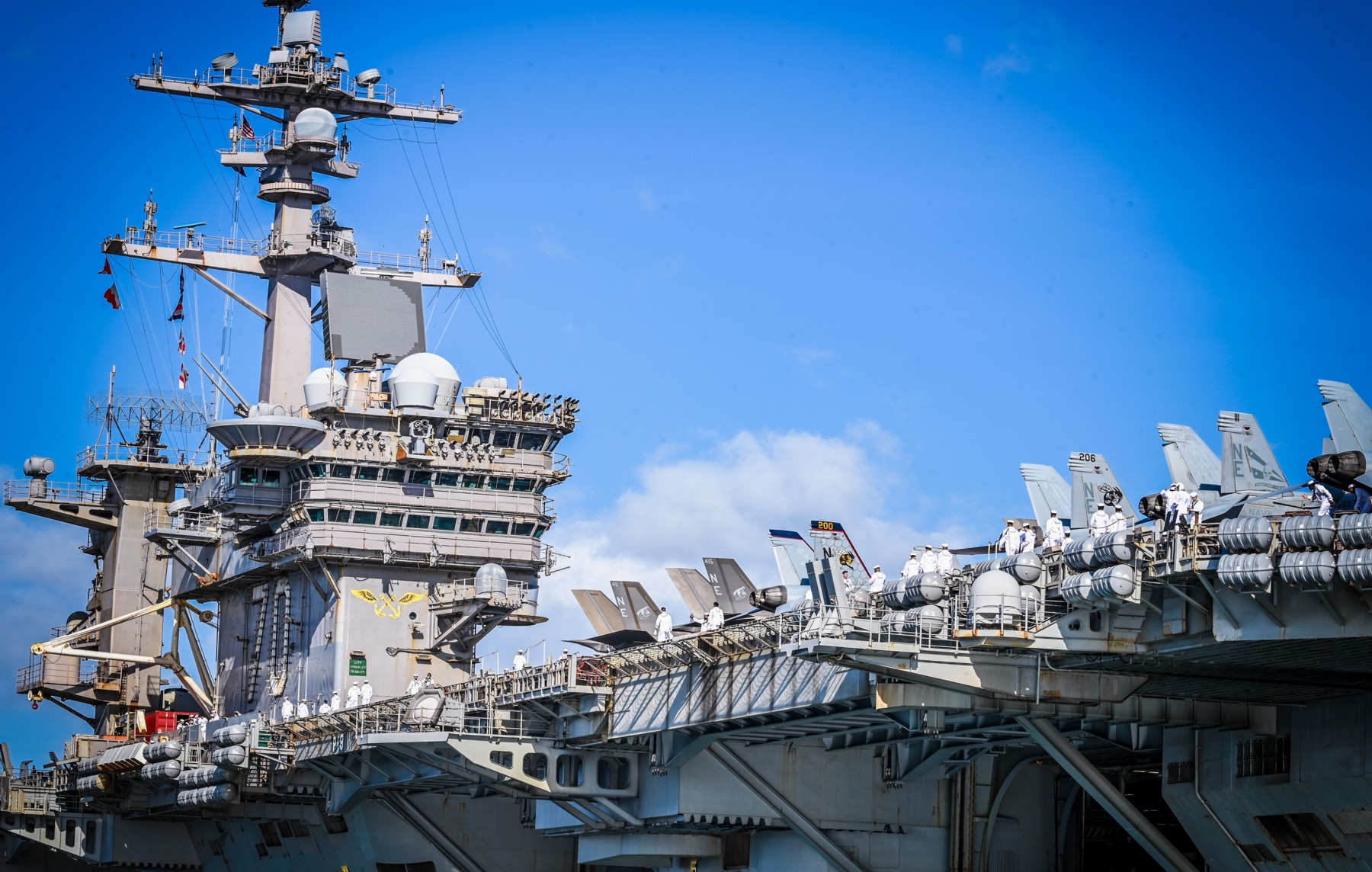 with CVW-2 embarked - Joint Base Pearl Harbor-Hickam, Hawaii - July 30, 2025 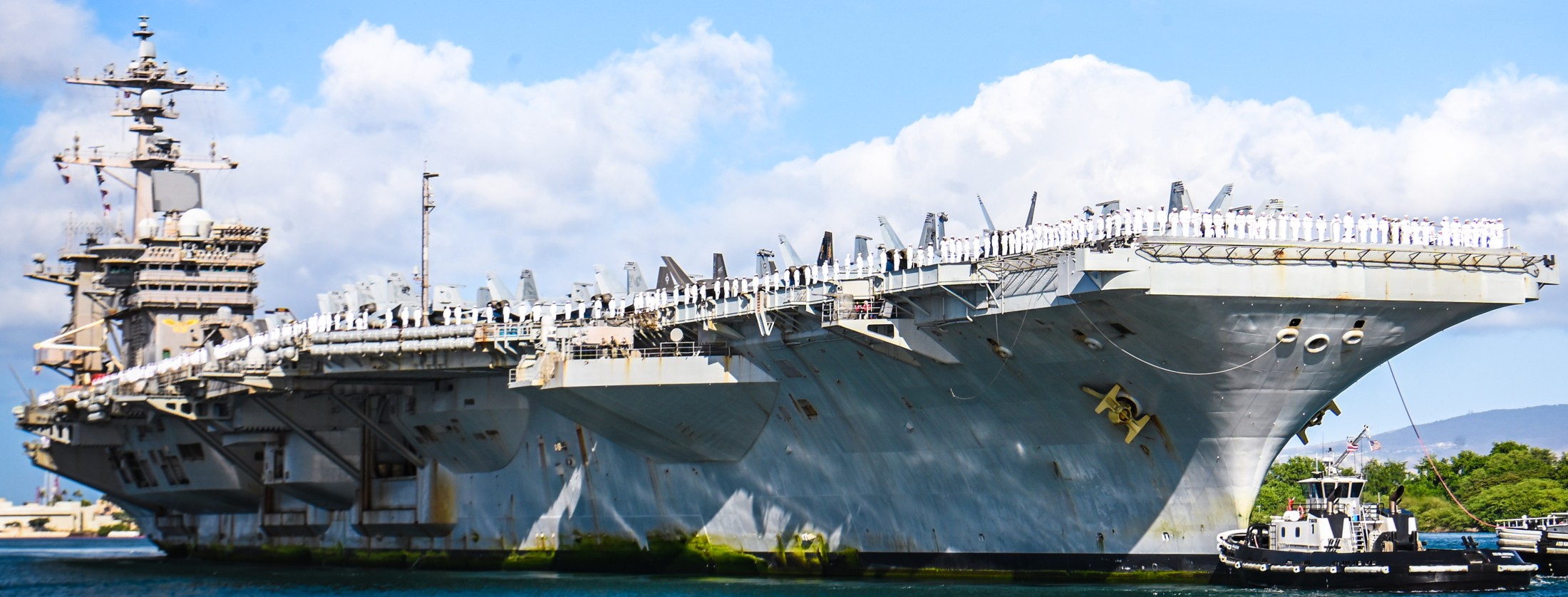 with CVW-2 embarked - Joint Base Pearl Harbor-Hickam, Hawaii - July 30, 2025 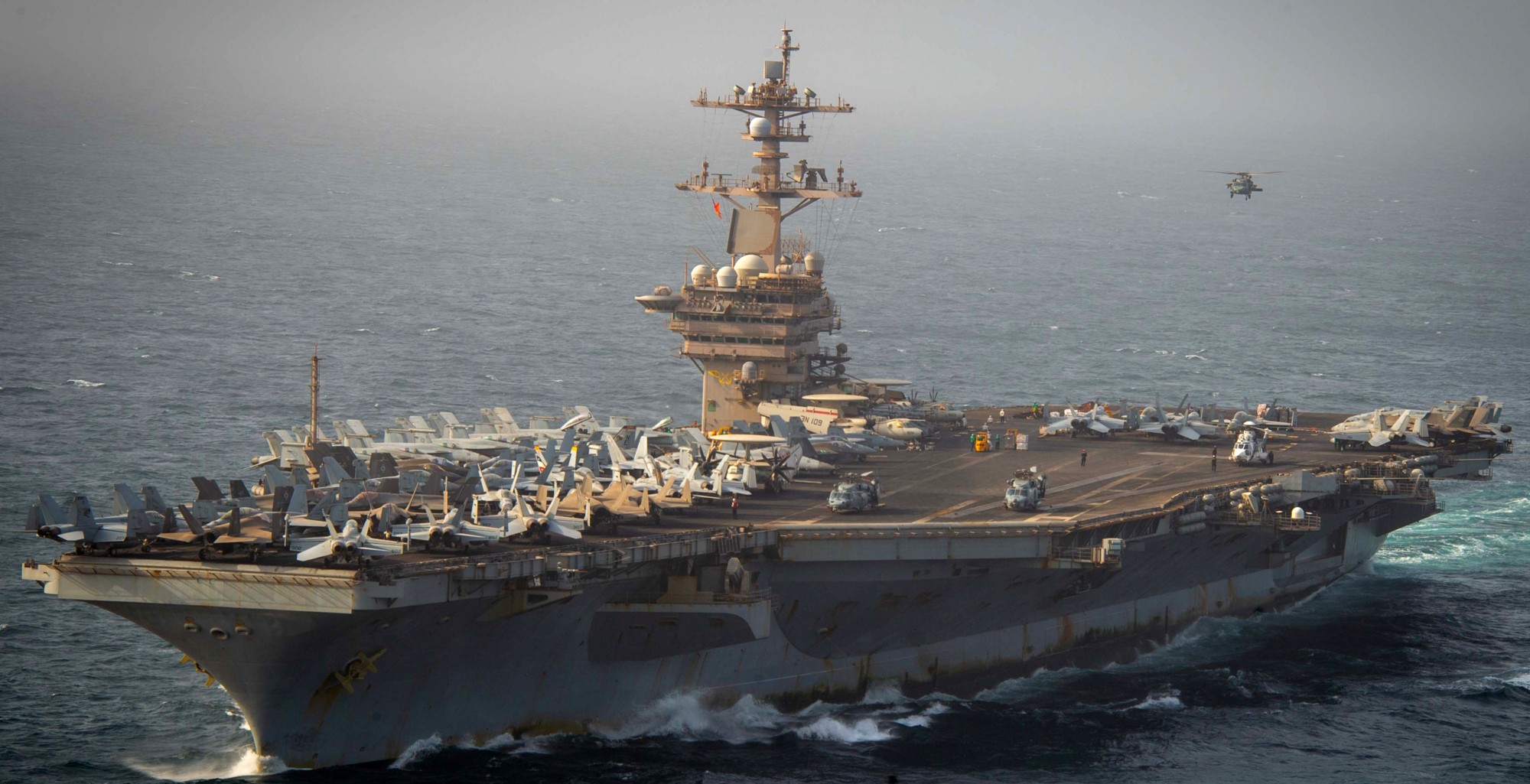 with CVW-2 embarked - US CENTCOM AOR - July 2025 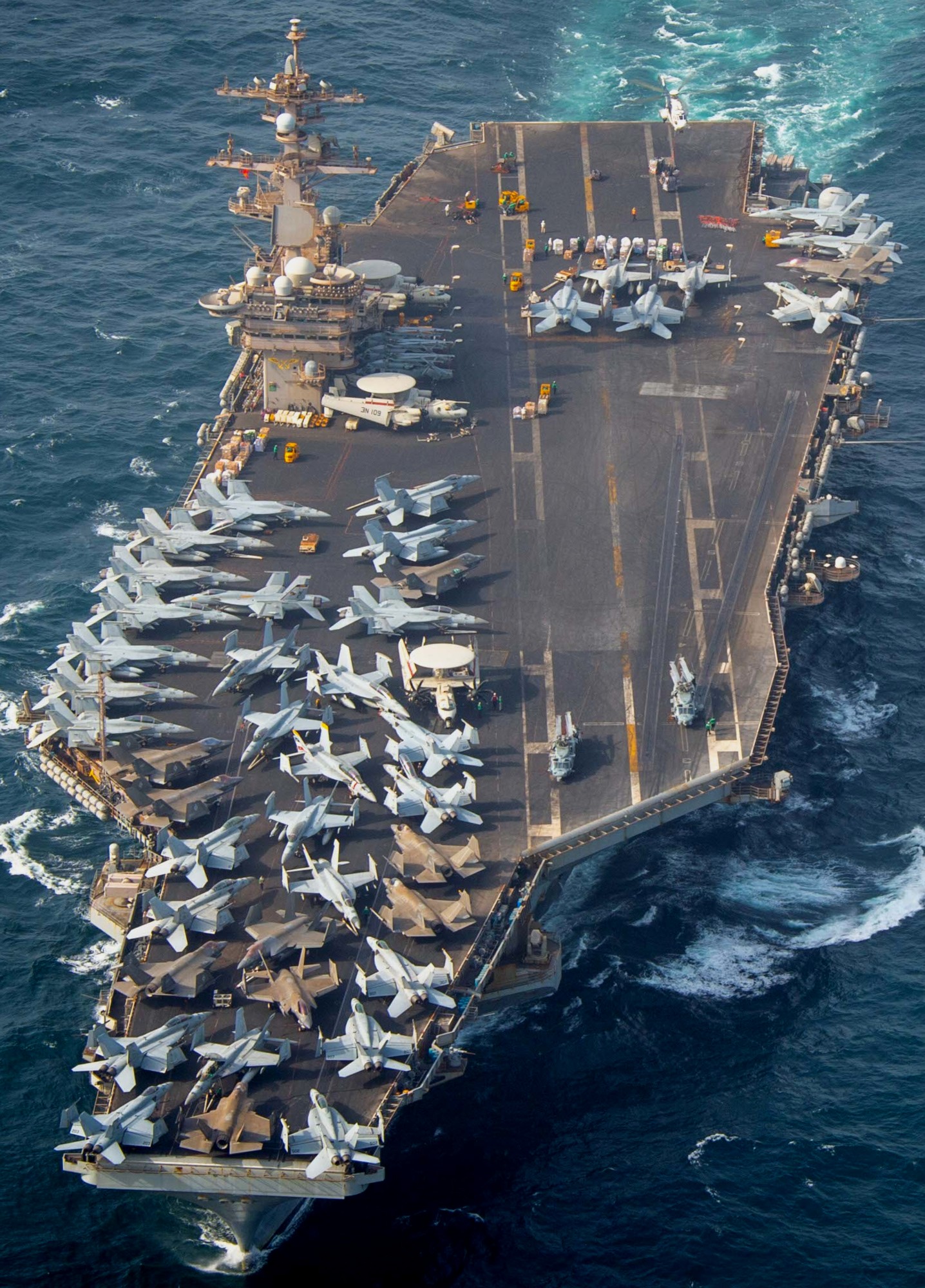 with CVW-2 embarked - US CENTCOM AOR - July 2025 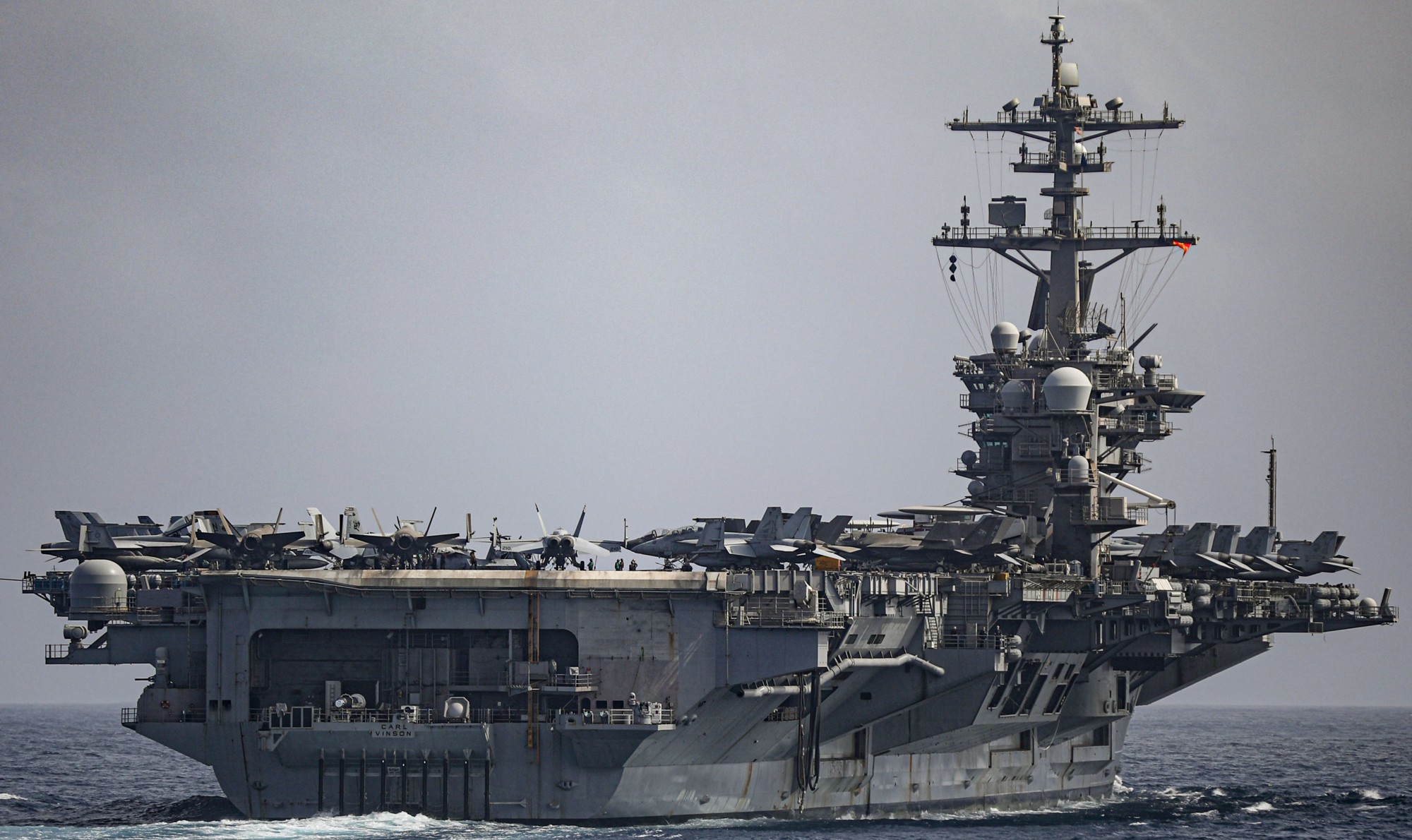 with CVW-2 embarked - 5th Fleet AOR - June 2025 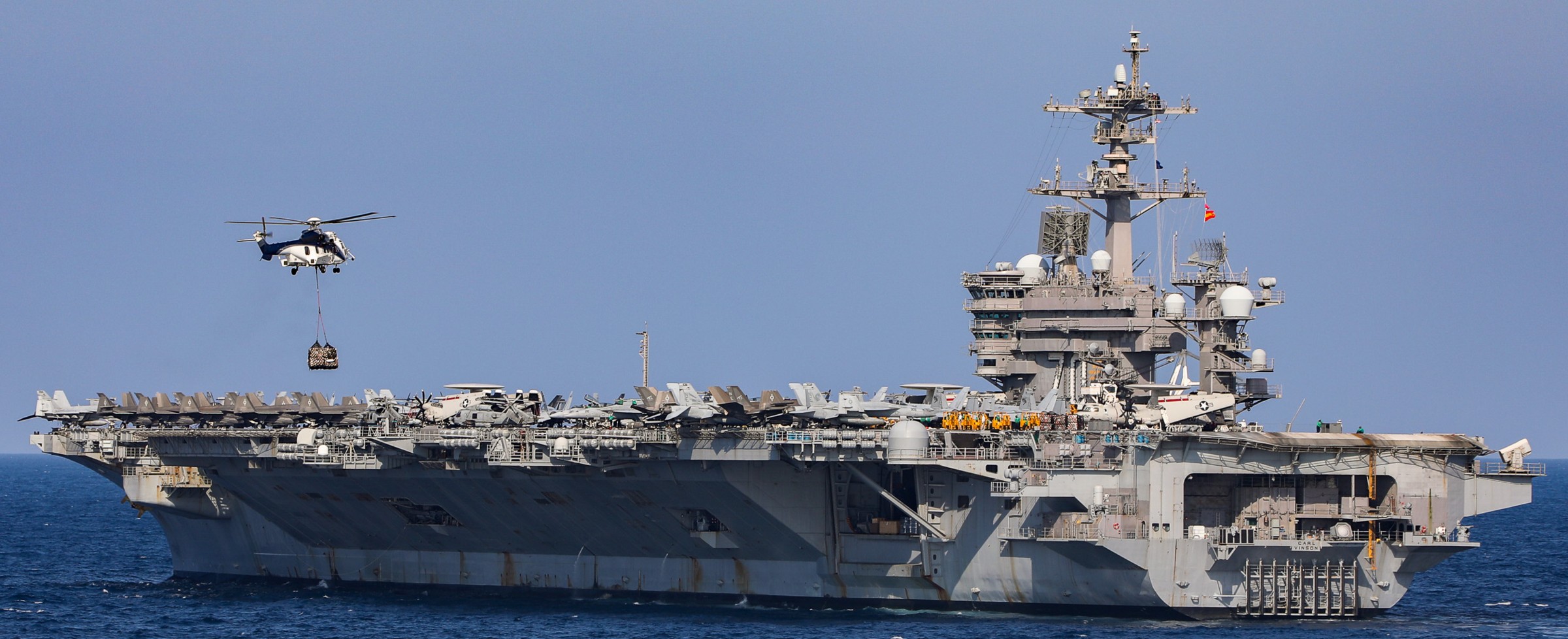 with CVW-2 embarked - 5th Fleet AOR - April 2025  with CVW-2 embarked - Exercise Freedom Shield 25 - off Korea - March 2025  with CVW-2 embarked - Busan, Republic of Korea - March 2025 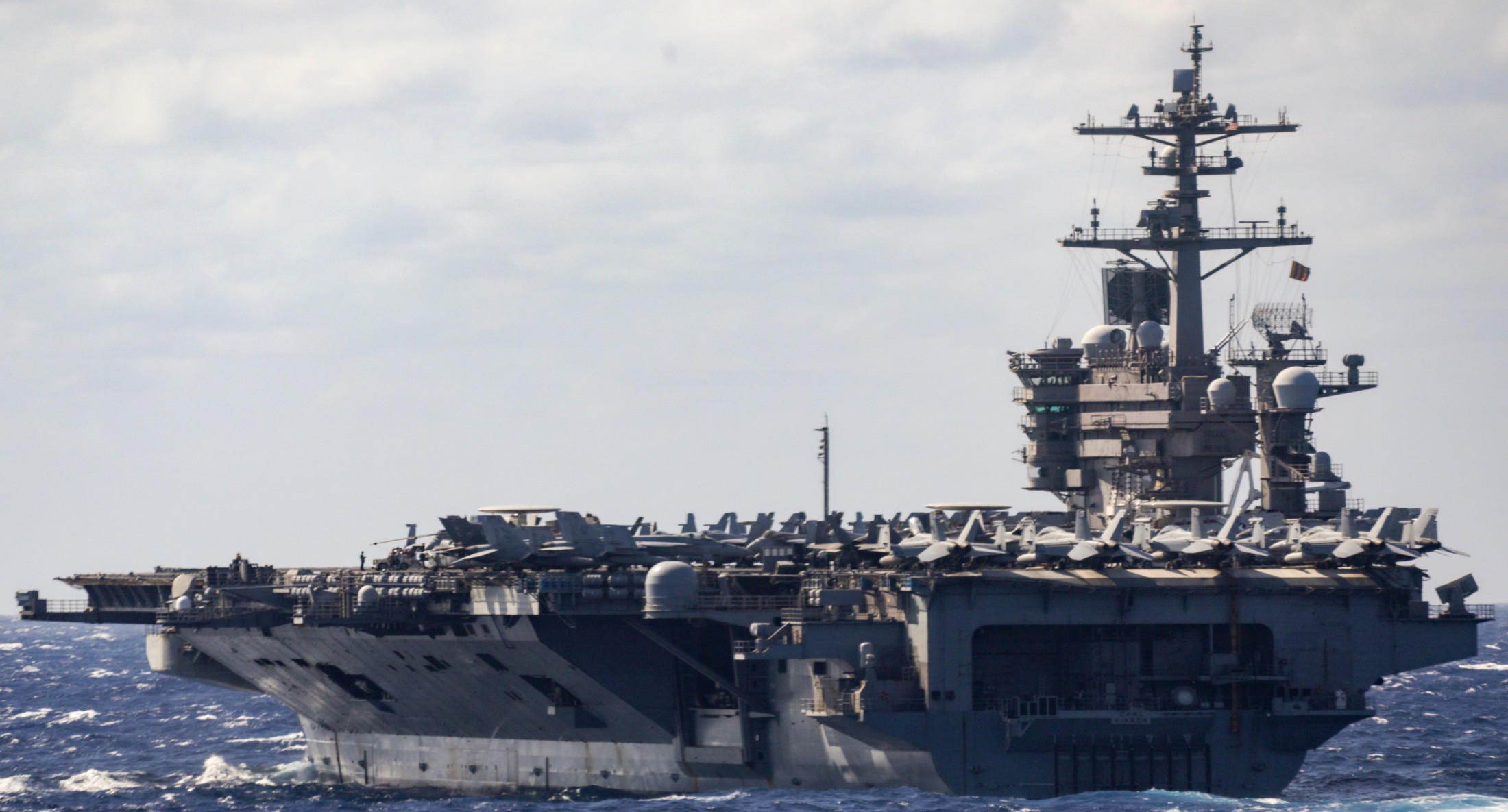 with CVW-2 embarked - South China Sea - January 2025  with CVW-2 embarked - Port Klang, Malaysia - December 2024 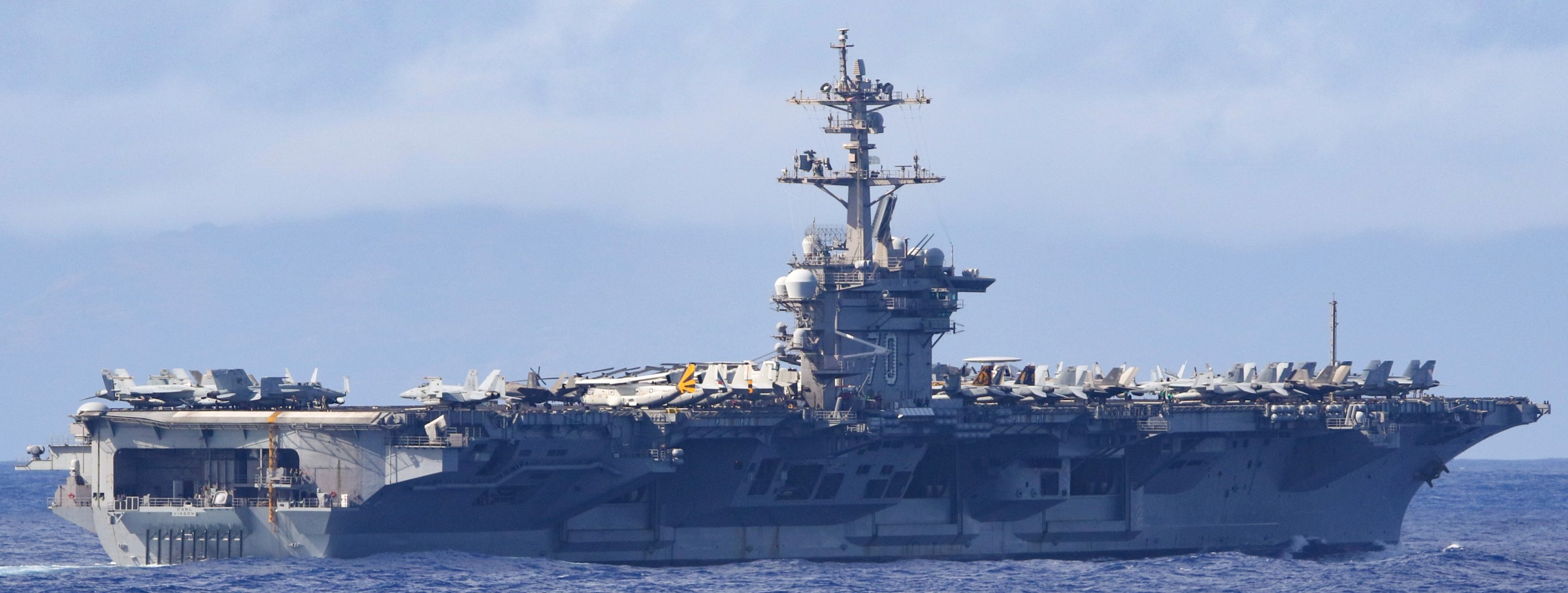 with CVW-2 embarked - Surigao Strait - December 2024 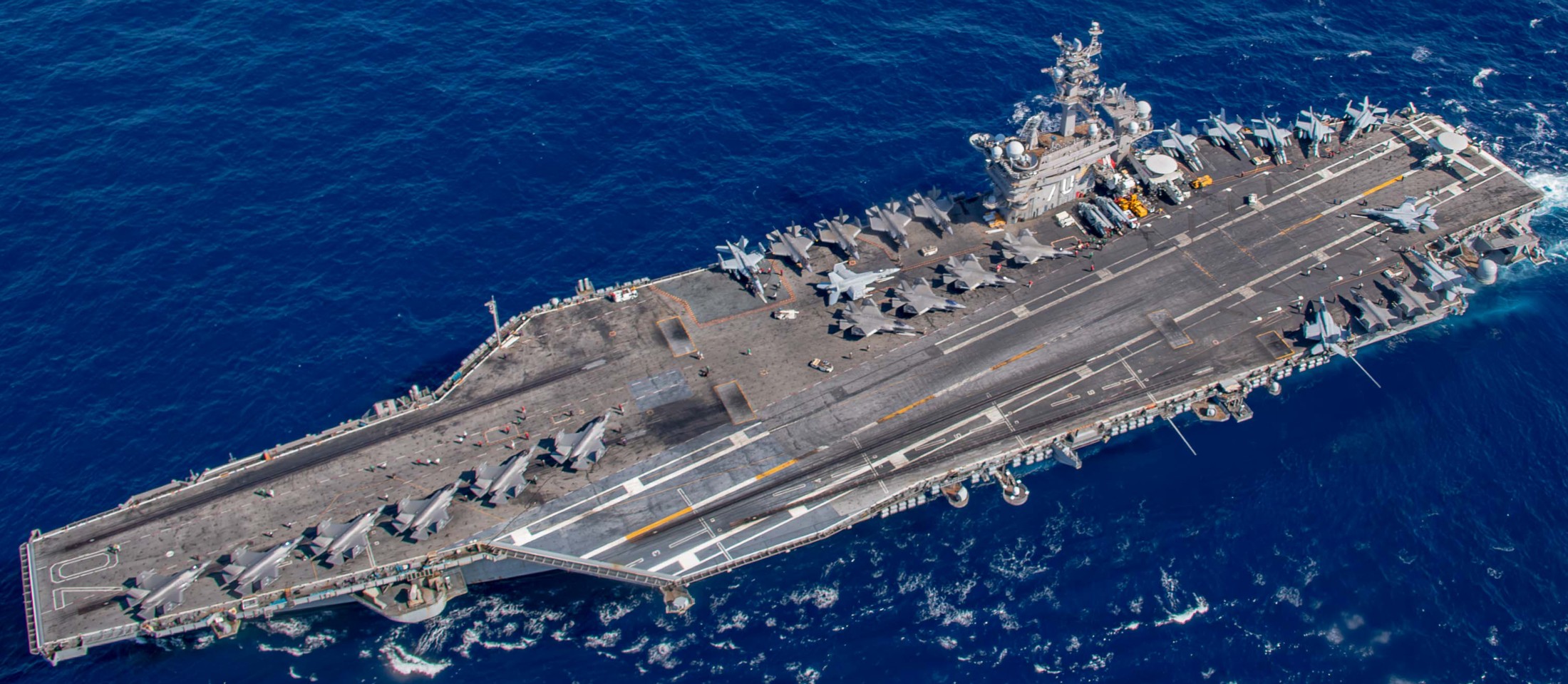 with CVW-2 embarked - Philippine Sea - December 2024 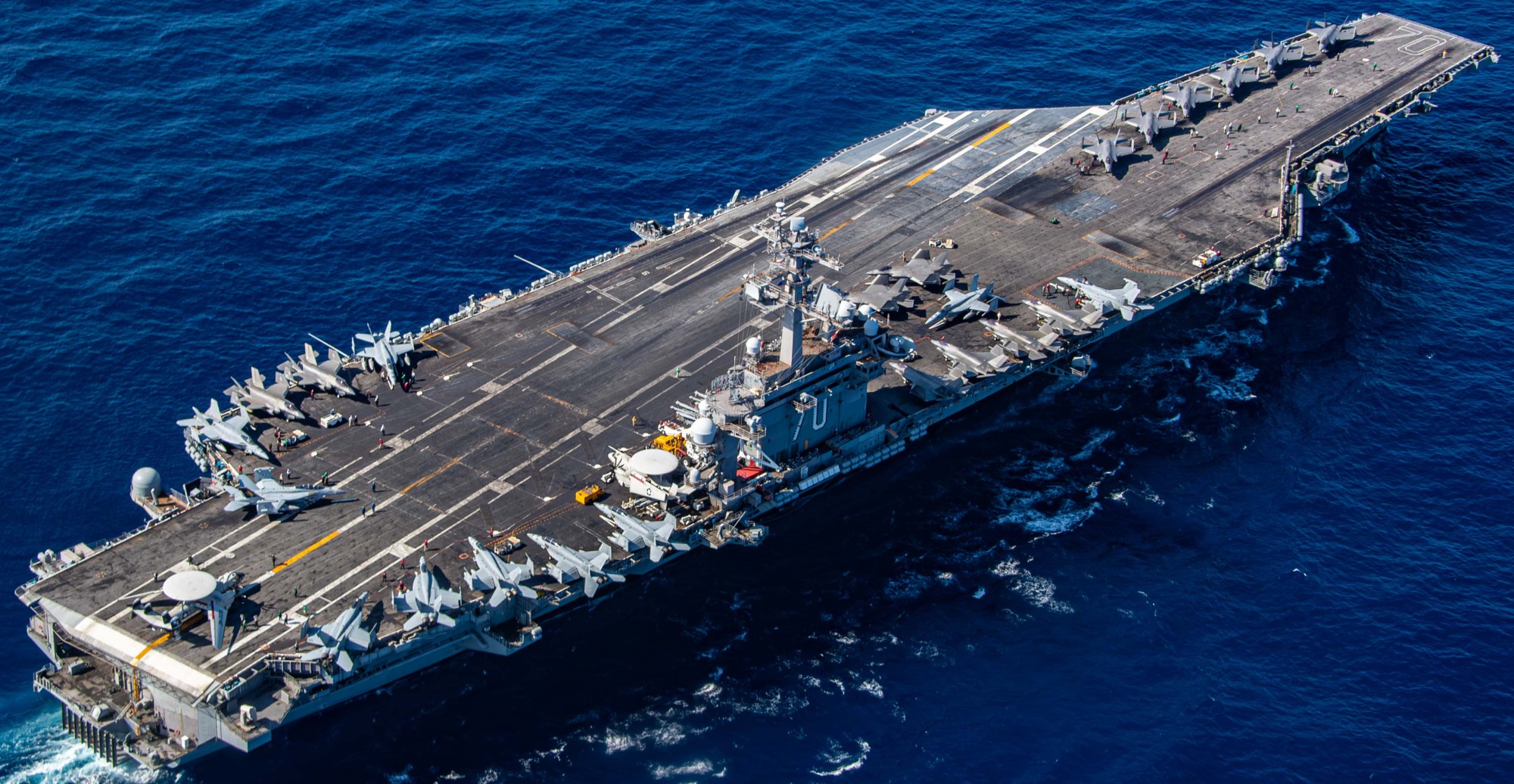 with CVW-2 embarked - Philippine Sea - December 2024  with CVW-2 embarked - Philippine Sea - December 2024  returning to NAS North Island, San Diego, California - August 15, 2024  with CVW-2 embarked - Pacific Ocean - August 2024 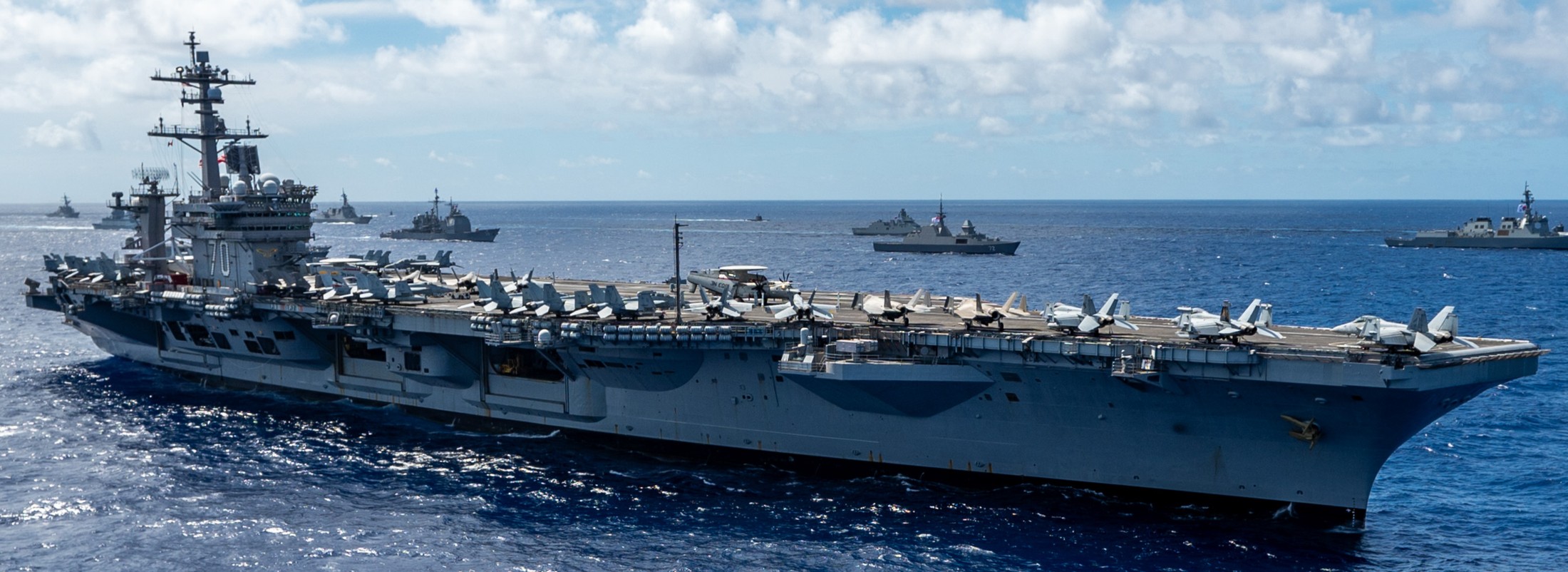 with CVW-2 embarked - during Exercise RIMPAC - Pacific Ocean - July 2024  with CVW-2 embarked - during Exercise RIMPAC - Pacific Ocean - July 2024 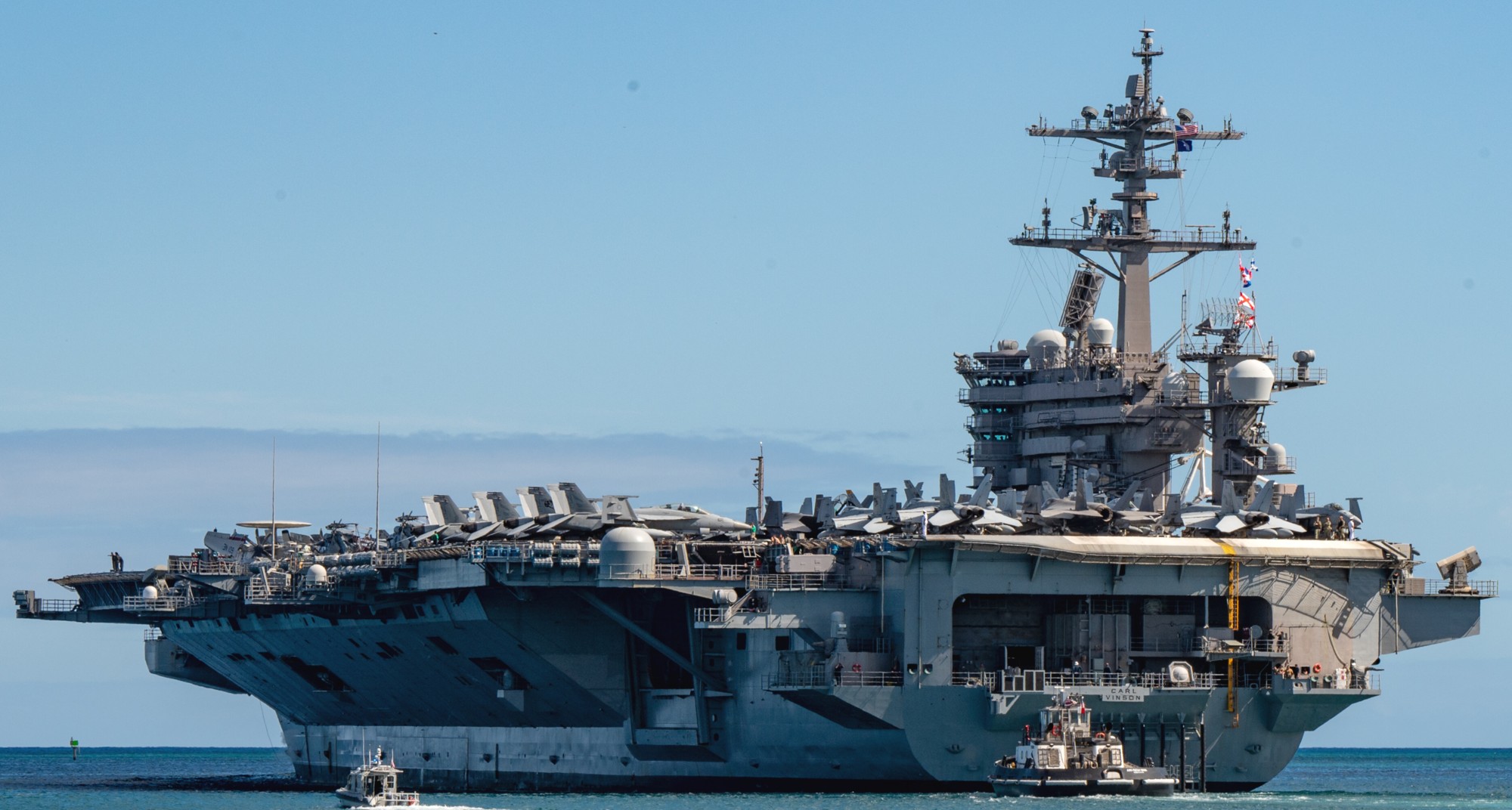 with CVW-2 embarked - departing Joint Base Pearl Harbor-Hickam, Hawaii for Exercise RIMPAC - July 8, 2024 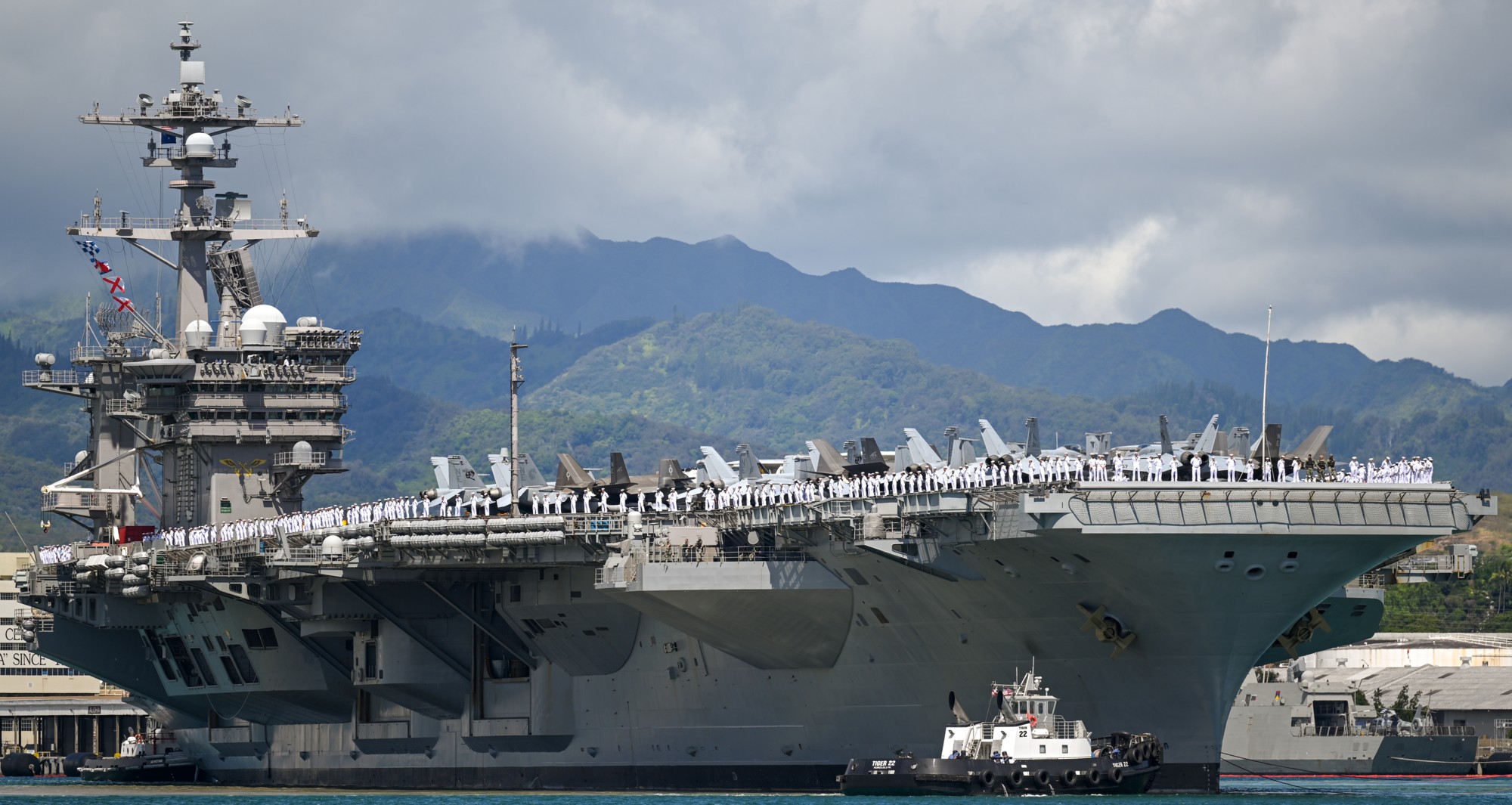 with CVW-2 embarked - departing Joint Base Pearl Harbor-Hickam, Hawaii for Exercise RIMPAC - July 8, 2024  with CVW-2 embarked - Joint Base Pearl Harbor-Hickam, Hawaii - July 3, 2024 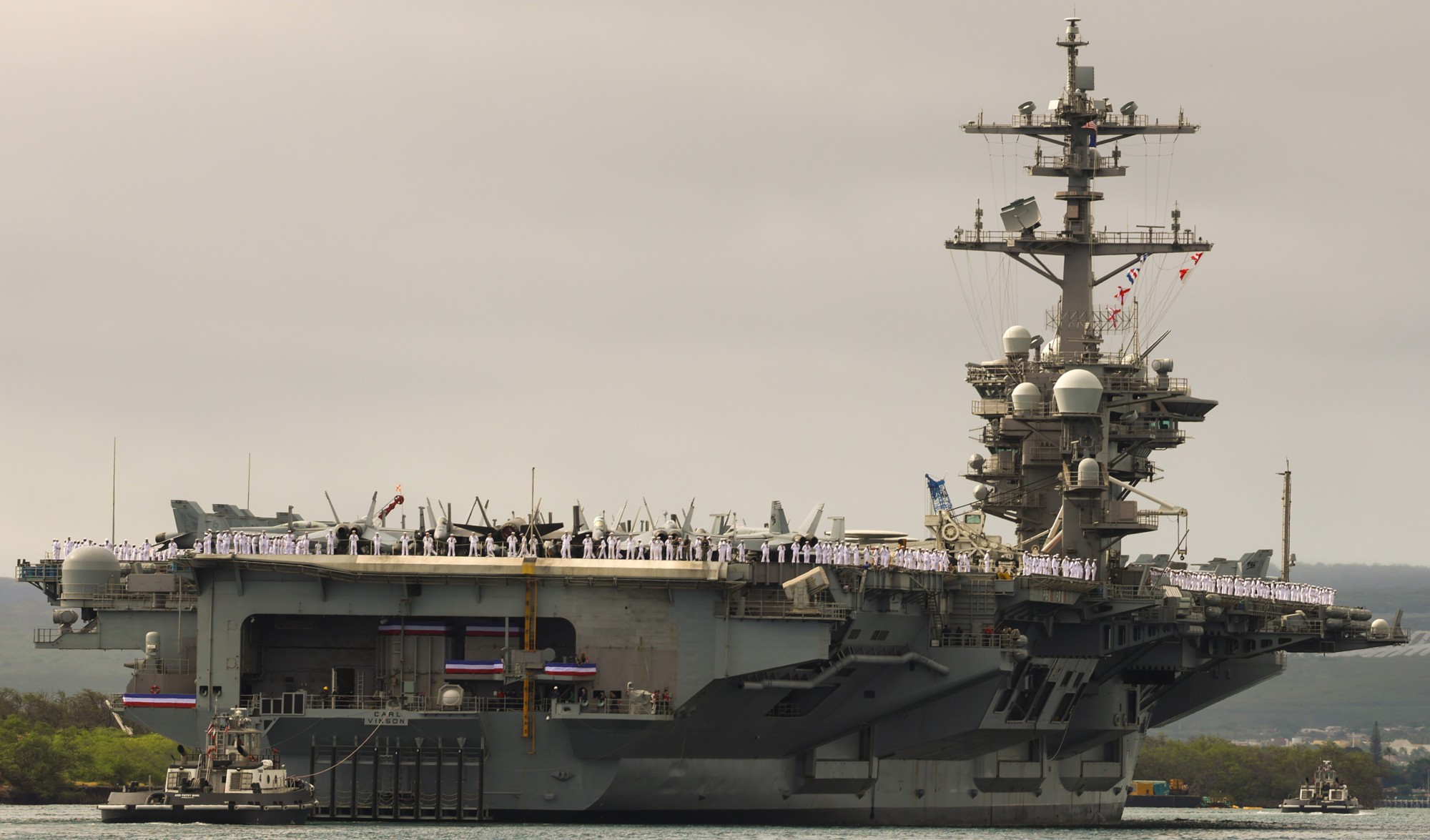 with CVW-2 embarked - arriving at Joint Base Pearl Harbor-Hickam, Hawaii for Exercise RIMPAC - June 25, 2024 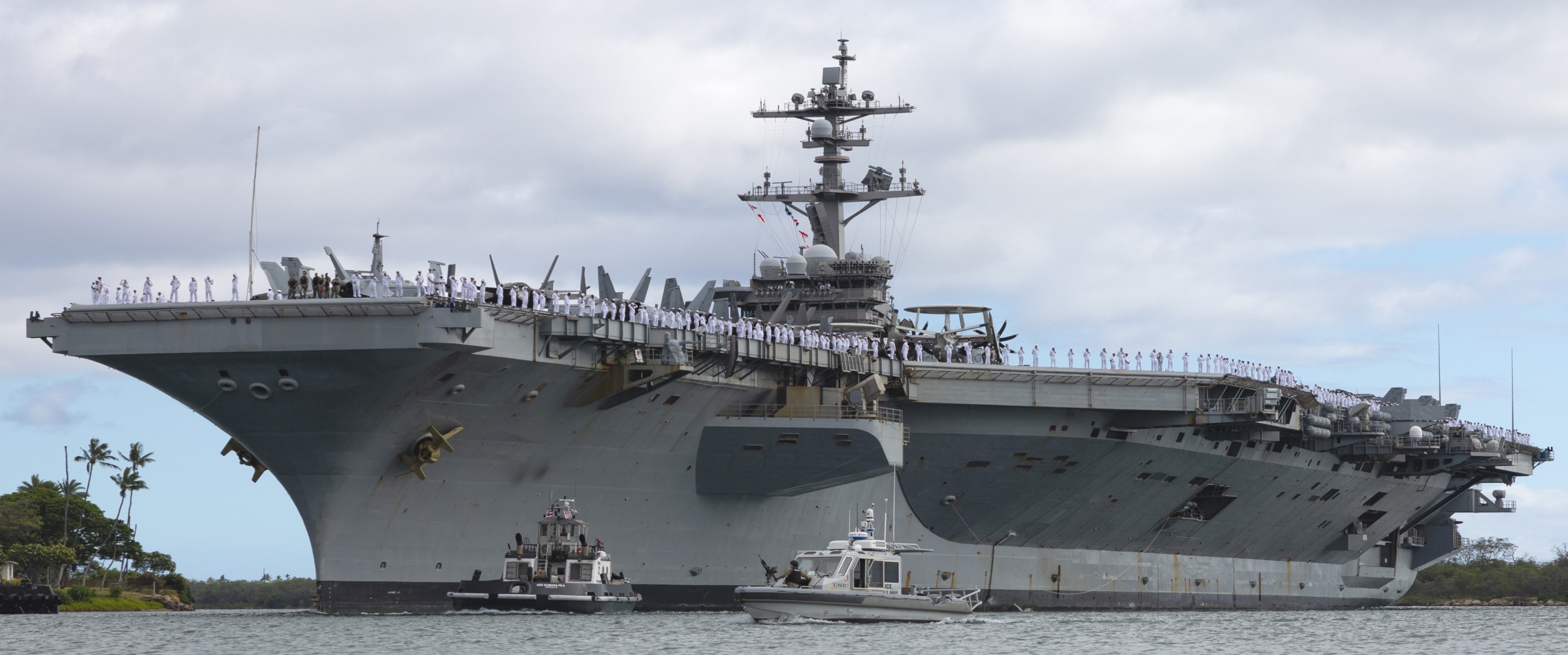 with CVW-2 embarked - arriving at Joint Base Pearl Harbor-Hickam, Hawaii for Exercise RIMPAC - June 25, 2024 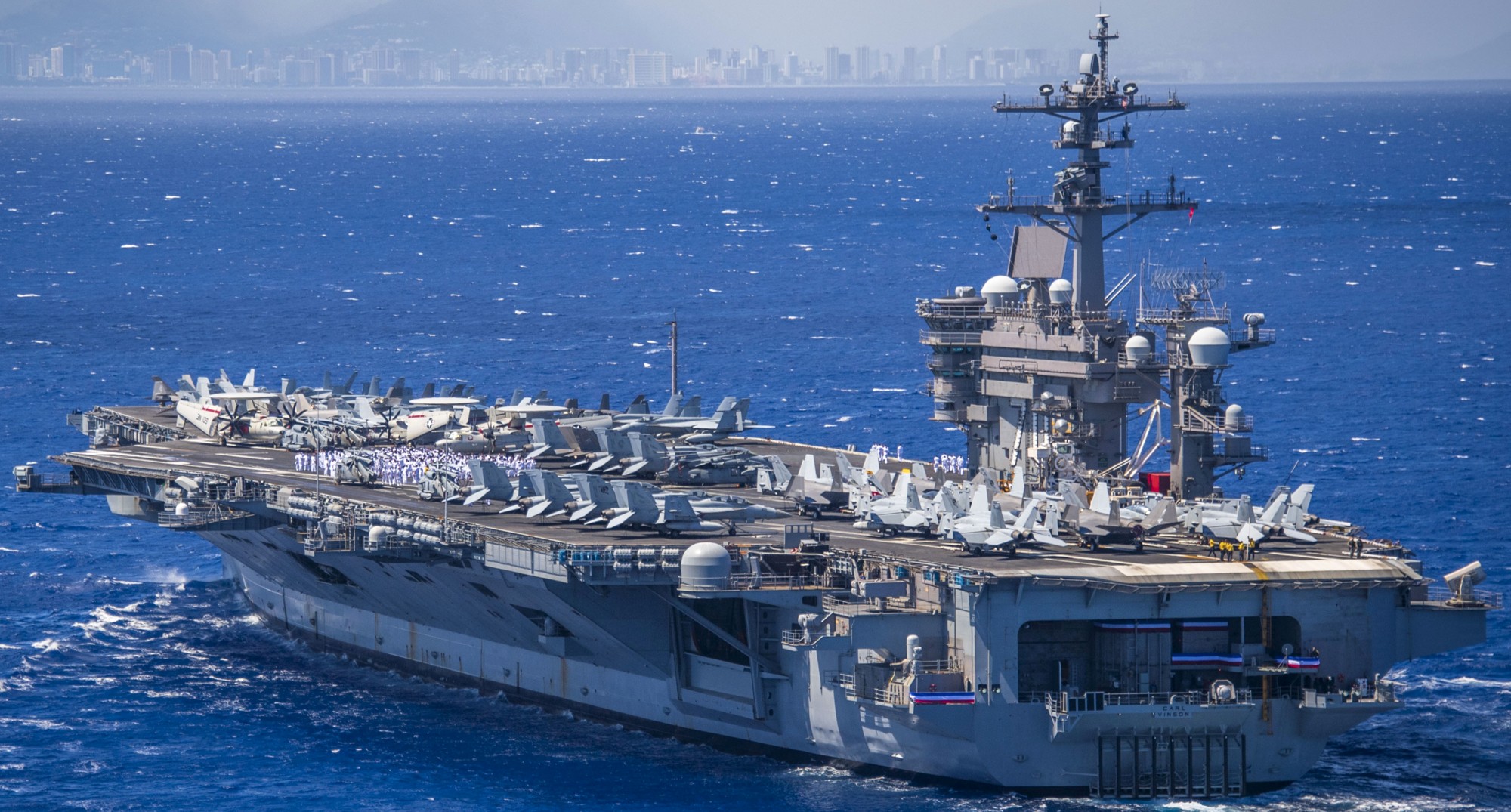 with CVW-2 embarked - arriving at Joint Base Pearl Harbor-Hickam, Hawaii for Exercise RIMPAC - June 25, 2024  with CVW-2 embarked - arriving at Joint Base Pearl Harbor-Hickam, Hawaii for Exercise RIMPAC - June 25, 2024 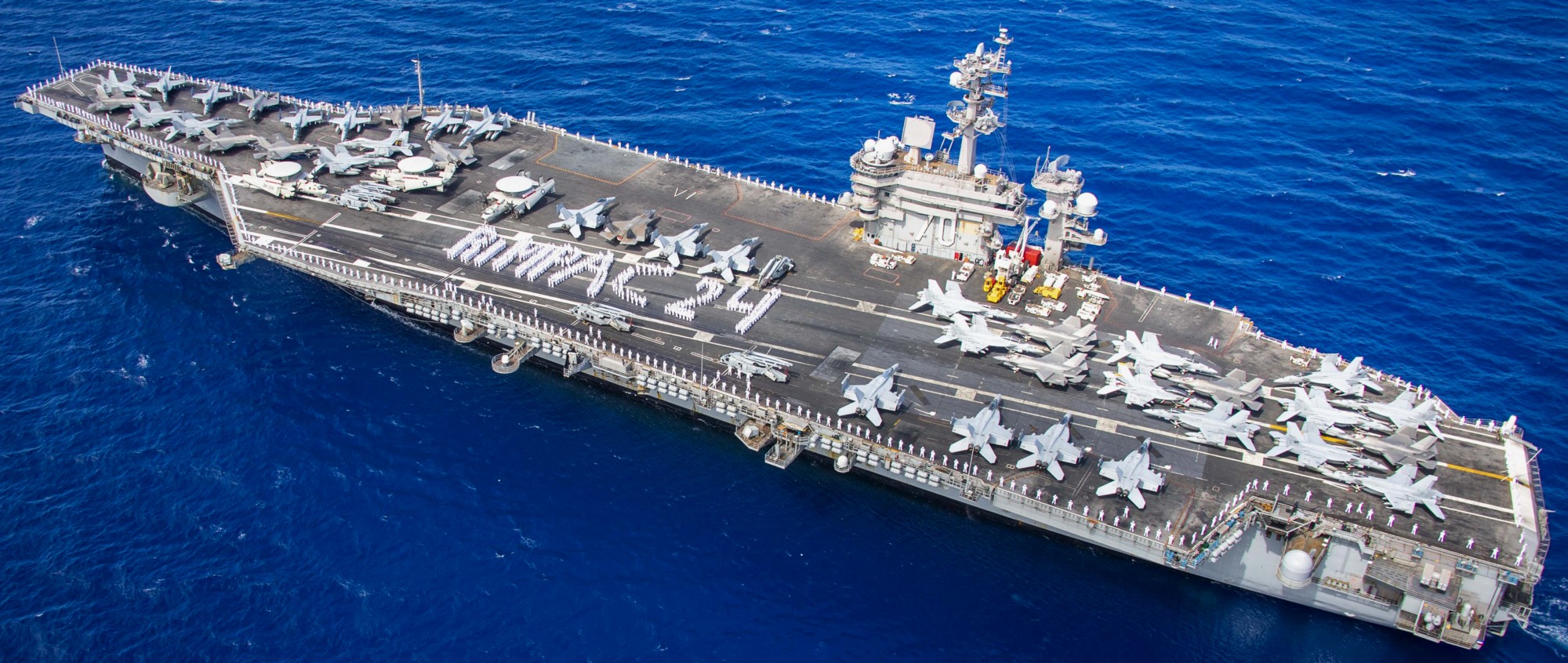 with CVW-2 embarked - arriving at Joint Base Pearl Harbor-Hickam, Hawaii for Exercise RIMPAC - June 25, 2024  with CVW-2 embarked - on her way to Hawaii for Exercise RIMPAC - Pacific Ocean - June 2024  arriving at the port of Los Angeles for Los Angeles Fleet Week - May 21, 2024 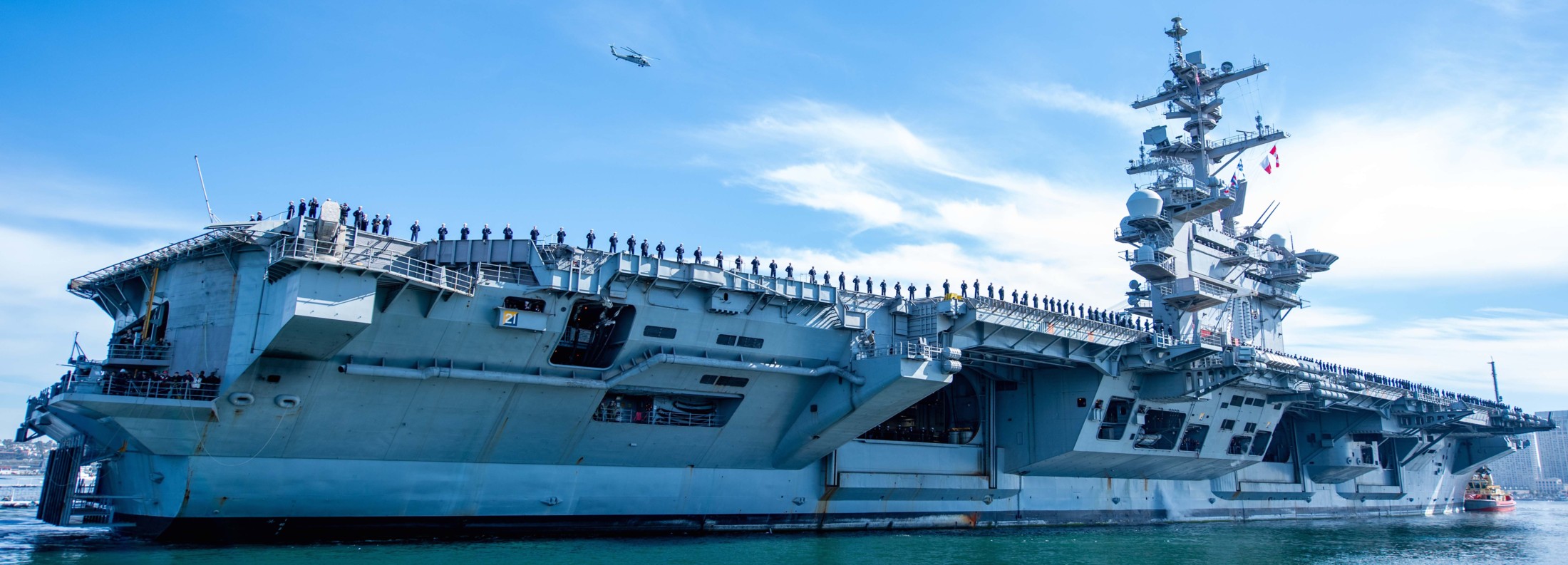 returning to NAS North Island, San Diego, California - February 23, 2024 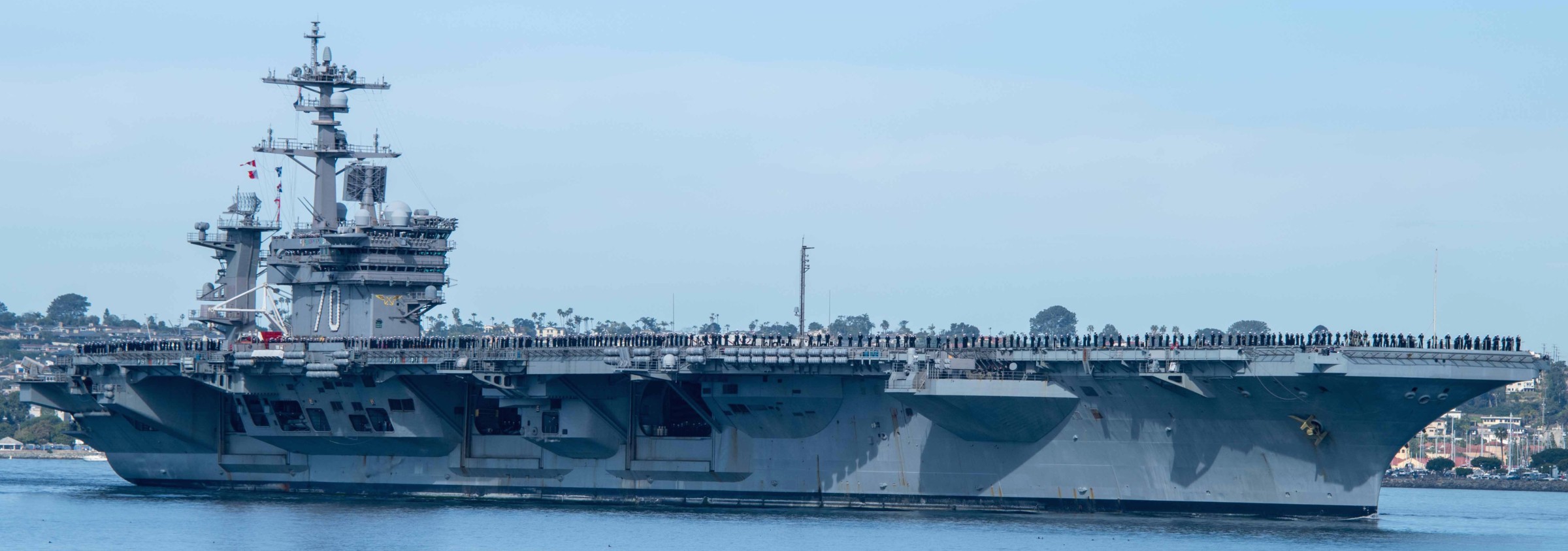 returning to NAS North Island, San Diego, California - February 23, 2024 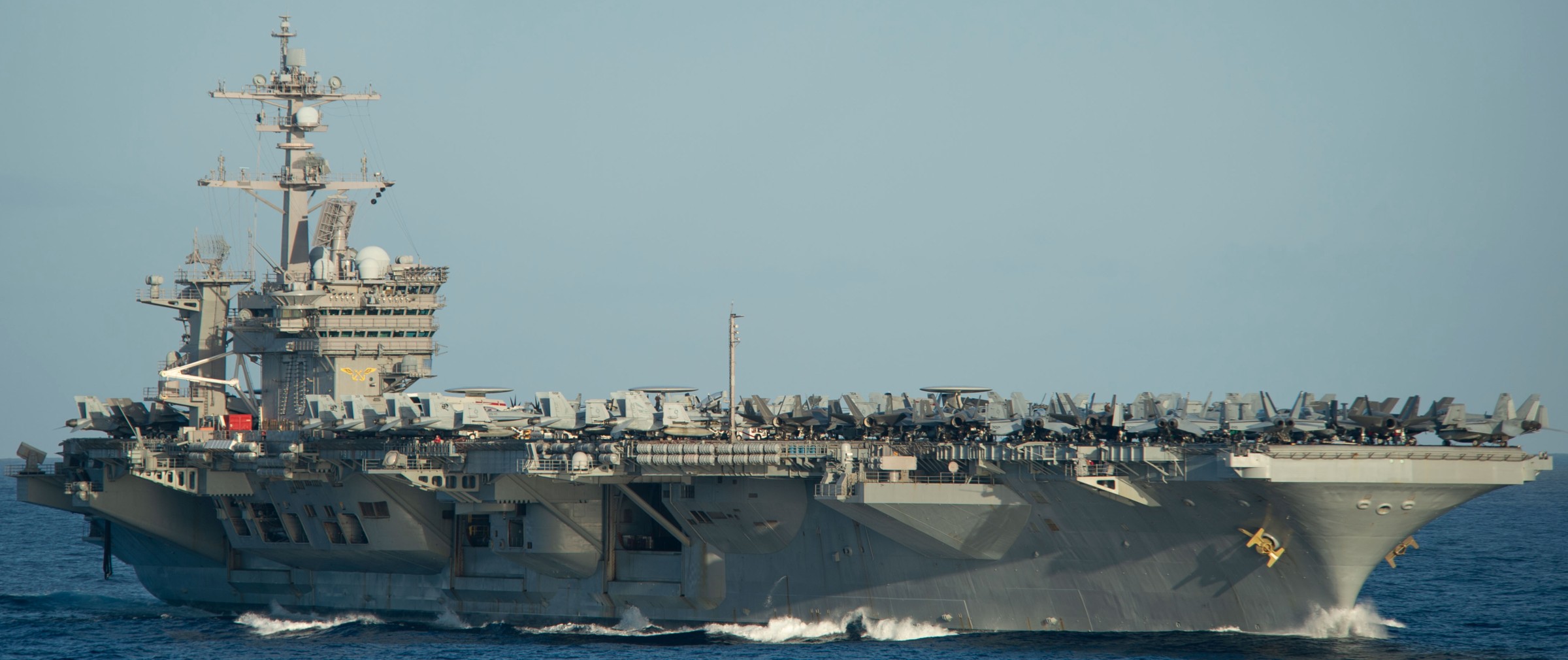 with CVW-2 embarked - Philippine Sea - February 2024 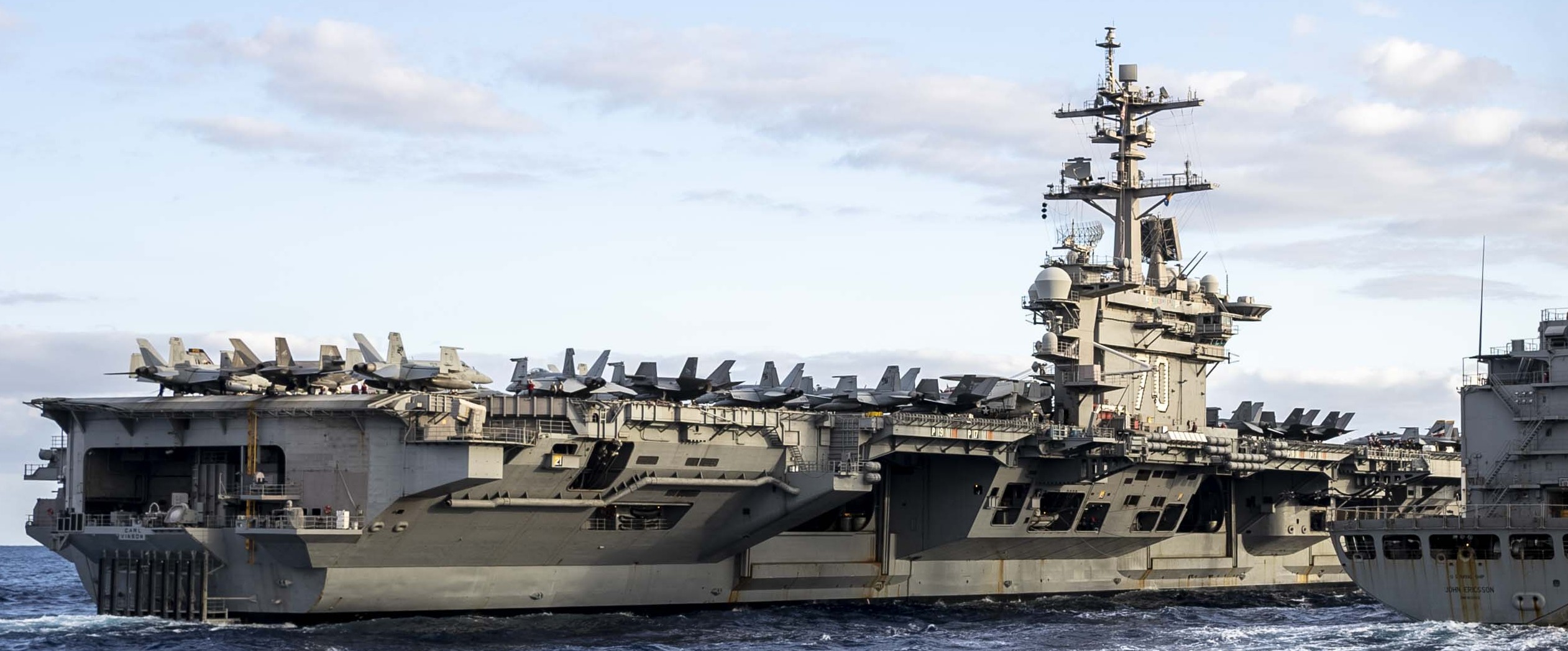 with CVW-2 embarked - trilateral exercise (USA, Japan, Republic of Korea) - January 2024  with CVW-2 embarked - trilateral exercise (USA, Japan, Republic of Korea) - January 2024 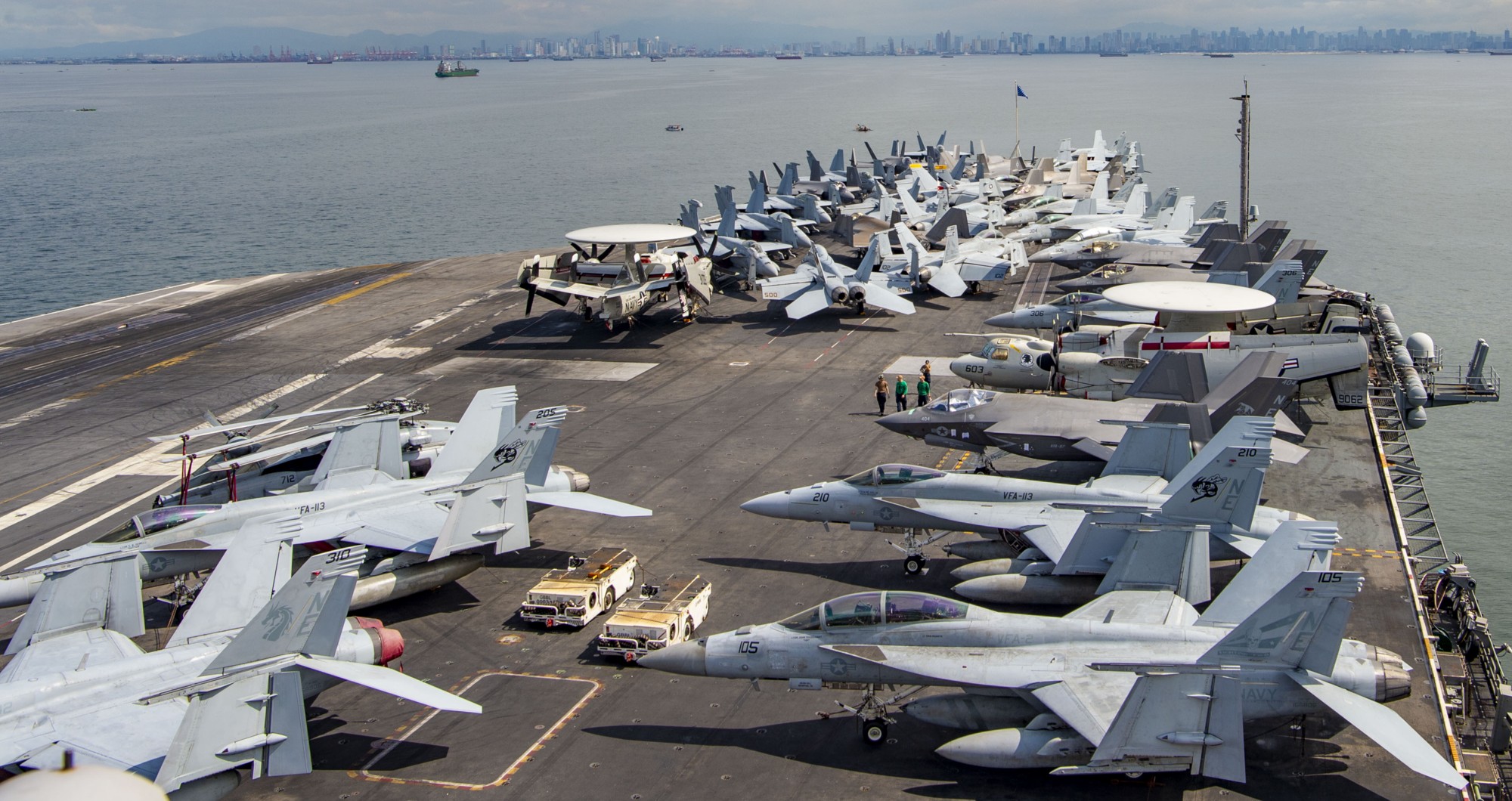 with CVW-2 embarked - Manila Bay, Philippines - January 2024 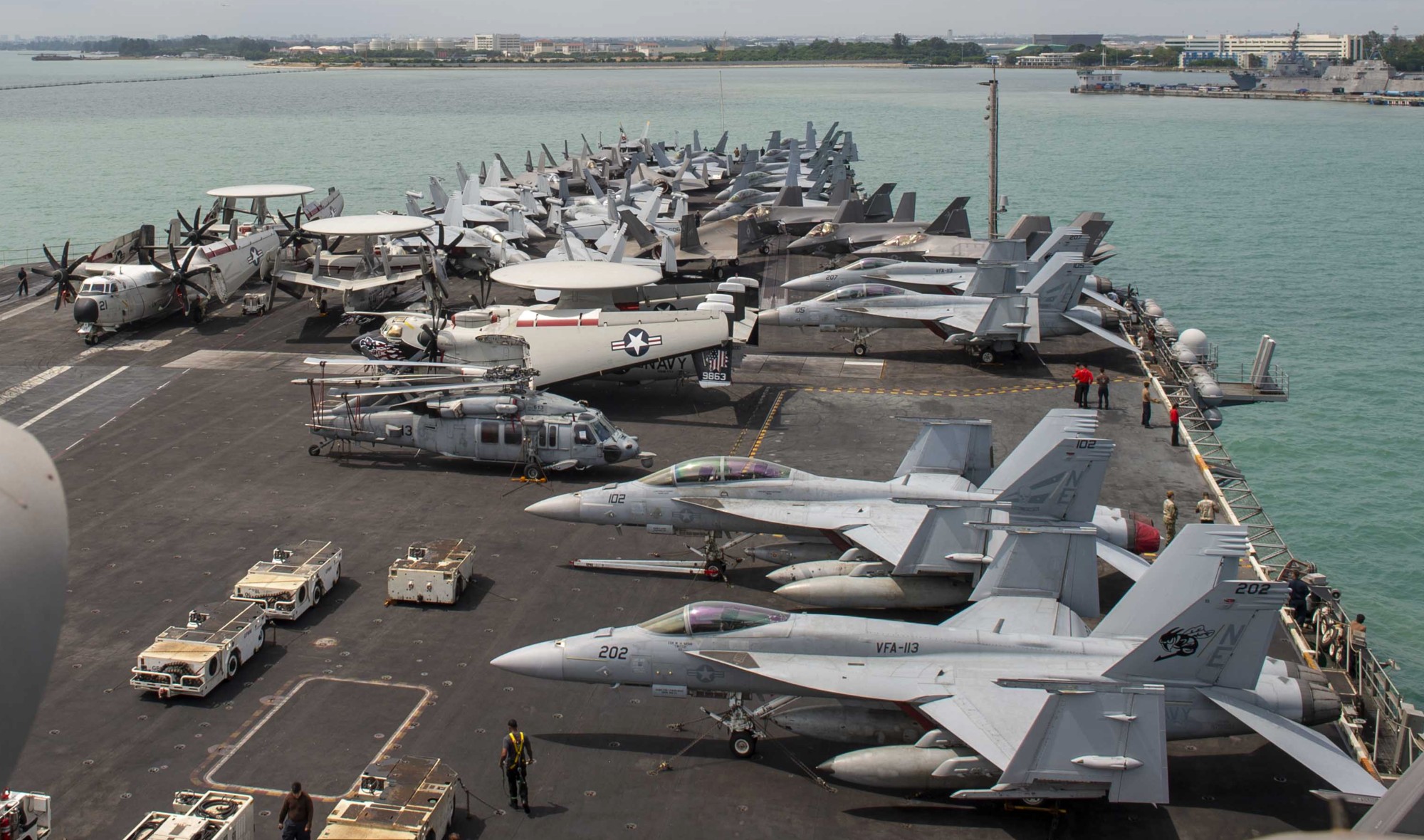 with CVW-2 embarked - Changi, Singapore - December 2023 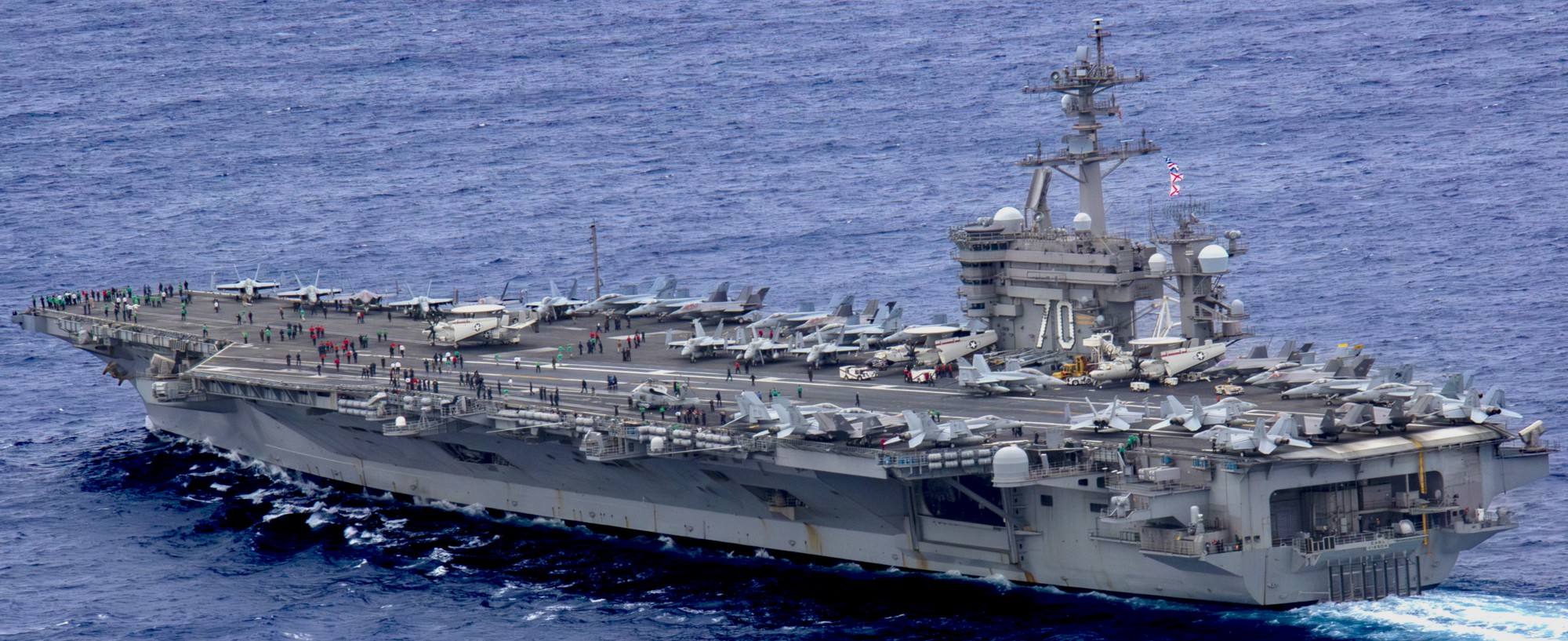 with CVW-2 embarked - ANNUALEX - Pacific Ocean - November 2023 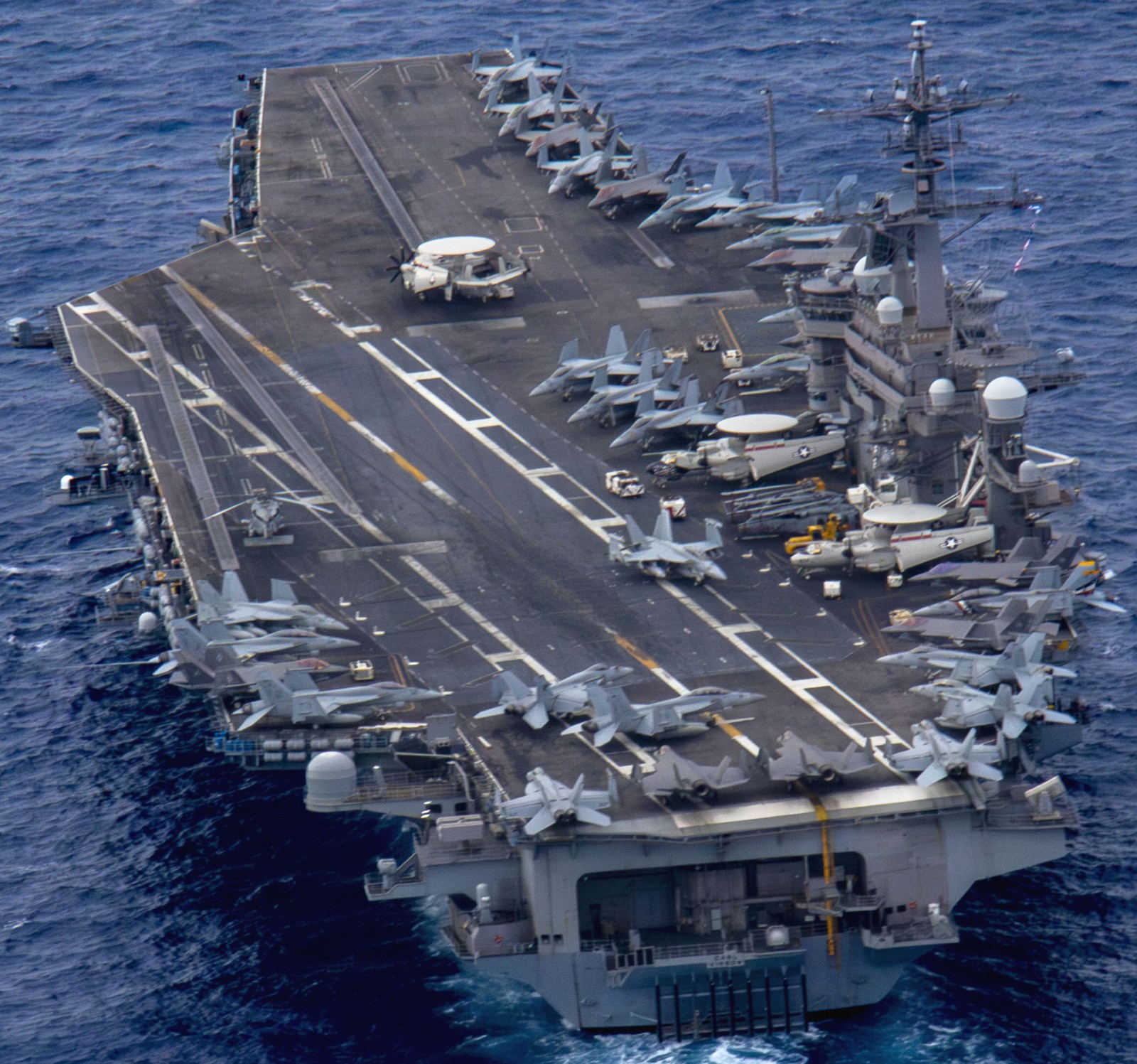 with CVW-2 embarked - ANNUALEX - Pacific Ocean - November 2023 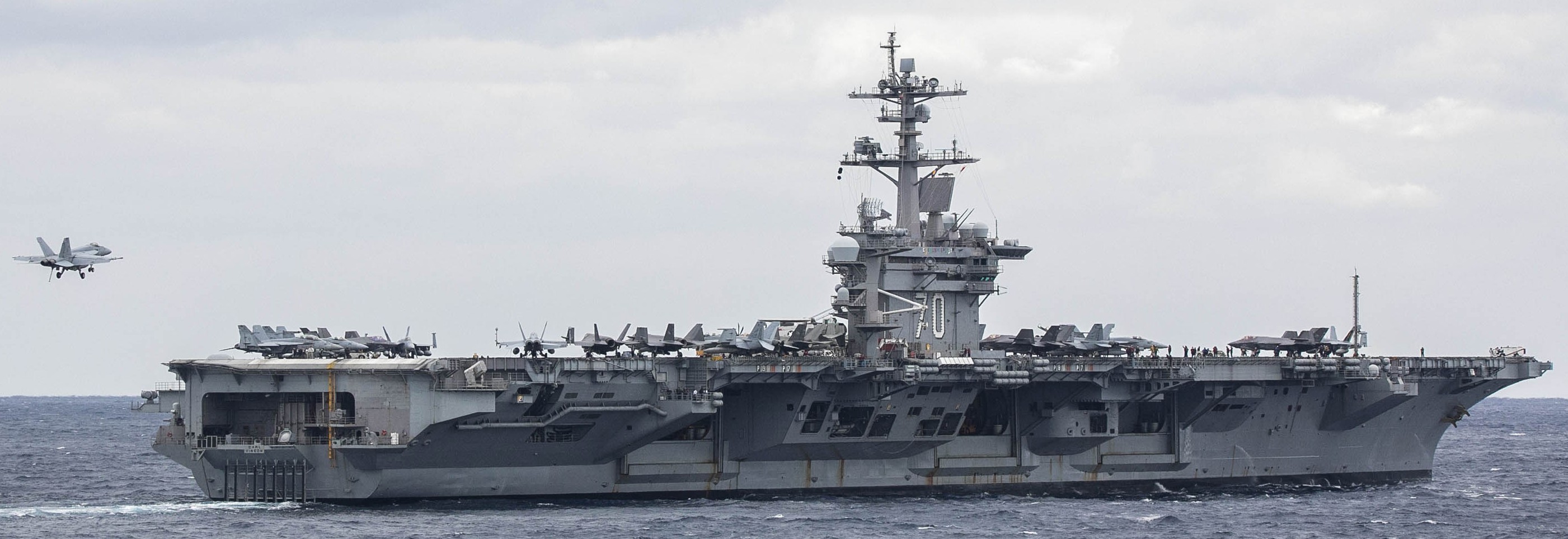 with CVW-2 embarked - Philippine Sea - November 2023 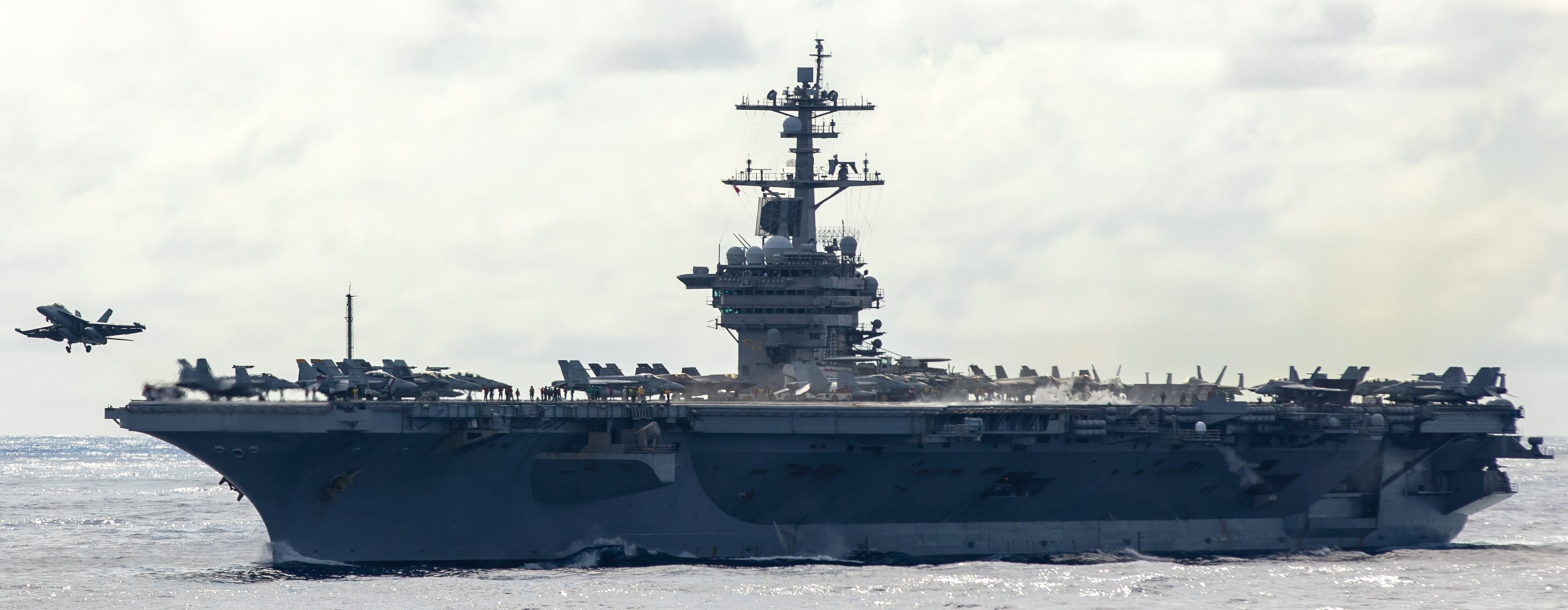 with CVW-2 embarked - Philippine Sea - November 2023 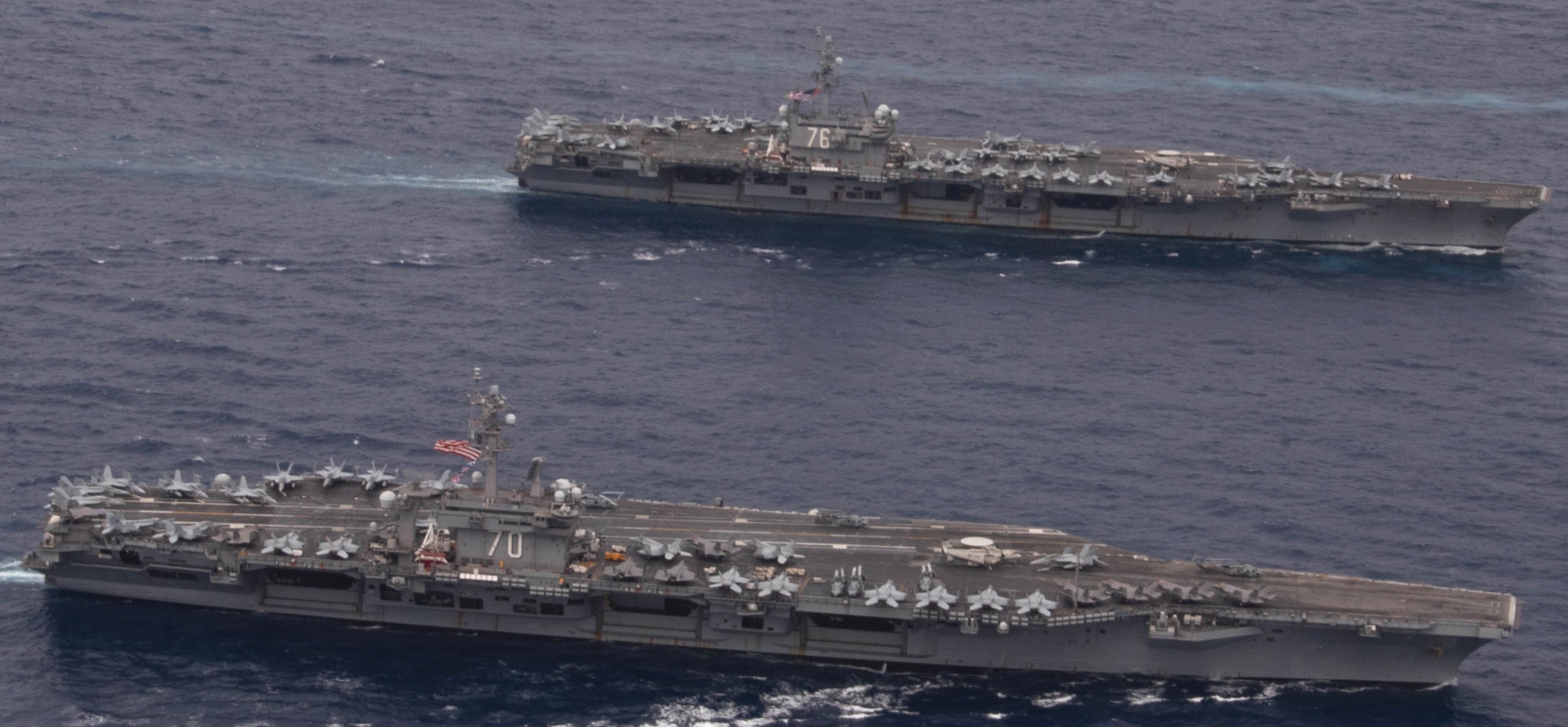 with USS Ronald Reagan (CVN 76) - Philippine Sea - November 2023  departing San Diego for a family & friends cruise - April 2023 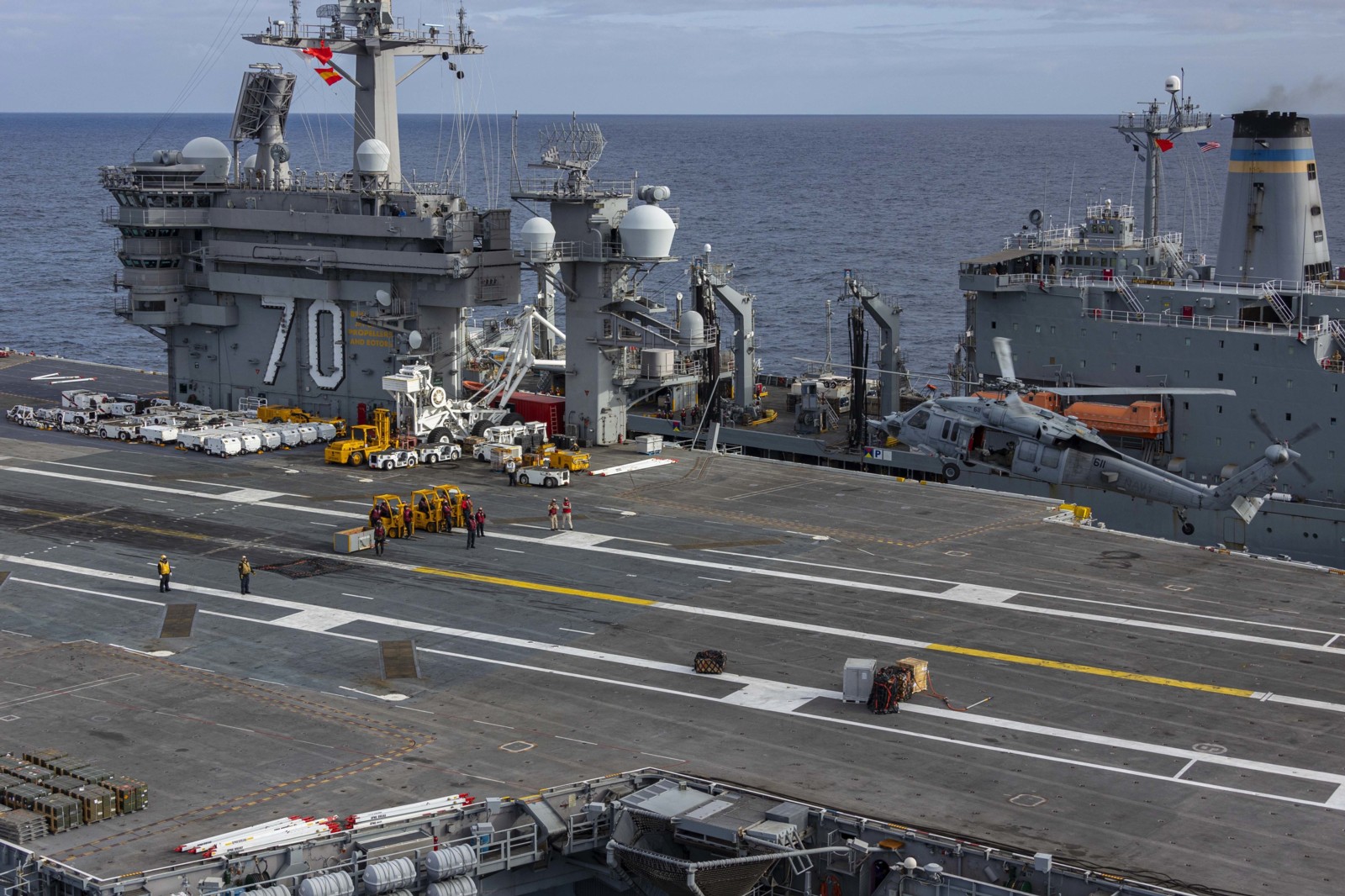 ammunition onload - Pacific Ocean - January 2023 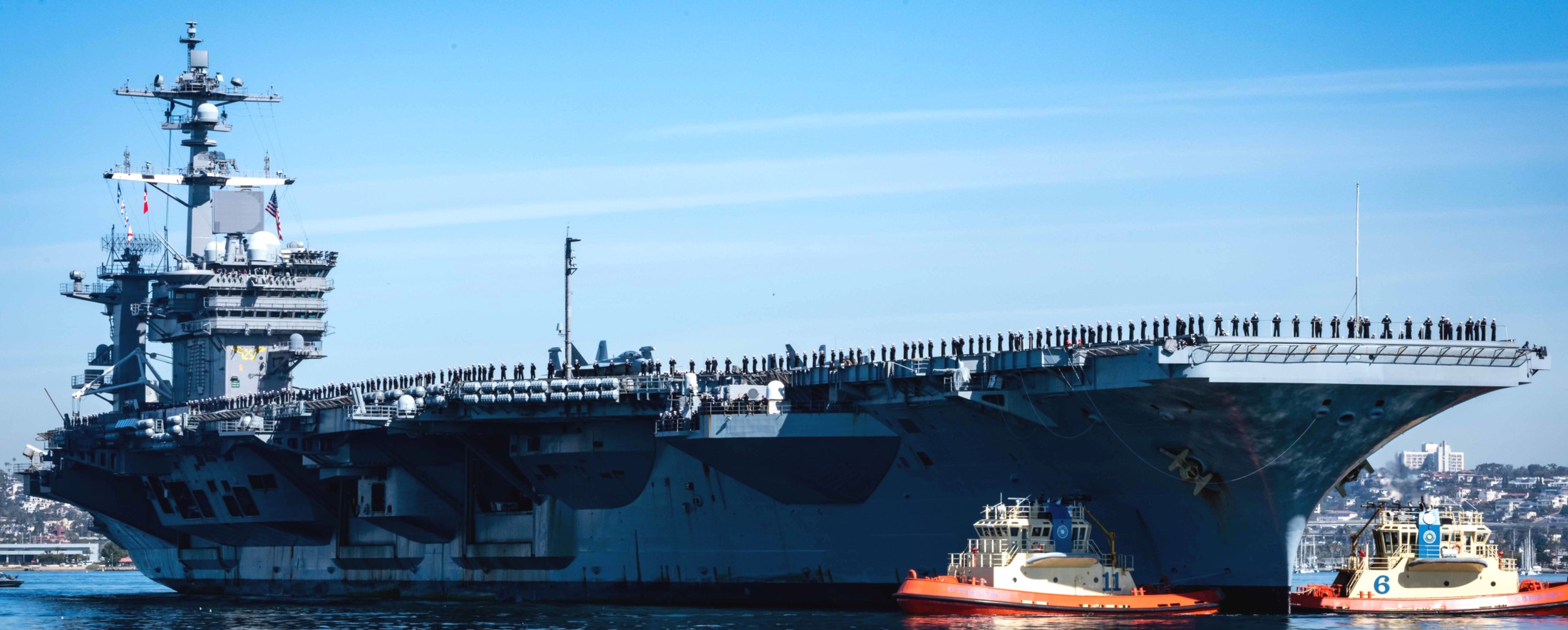 returning to NAS North Island, San Diego, California - February 2022 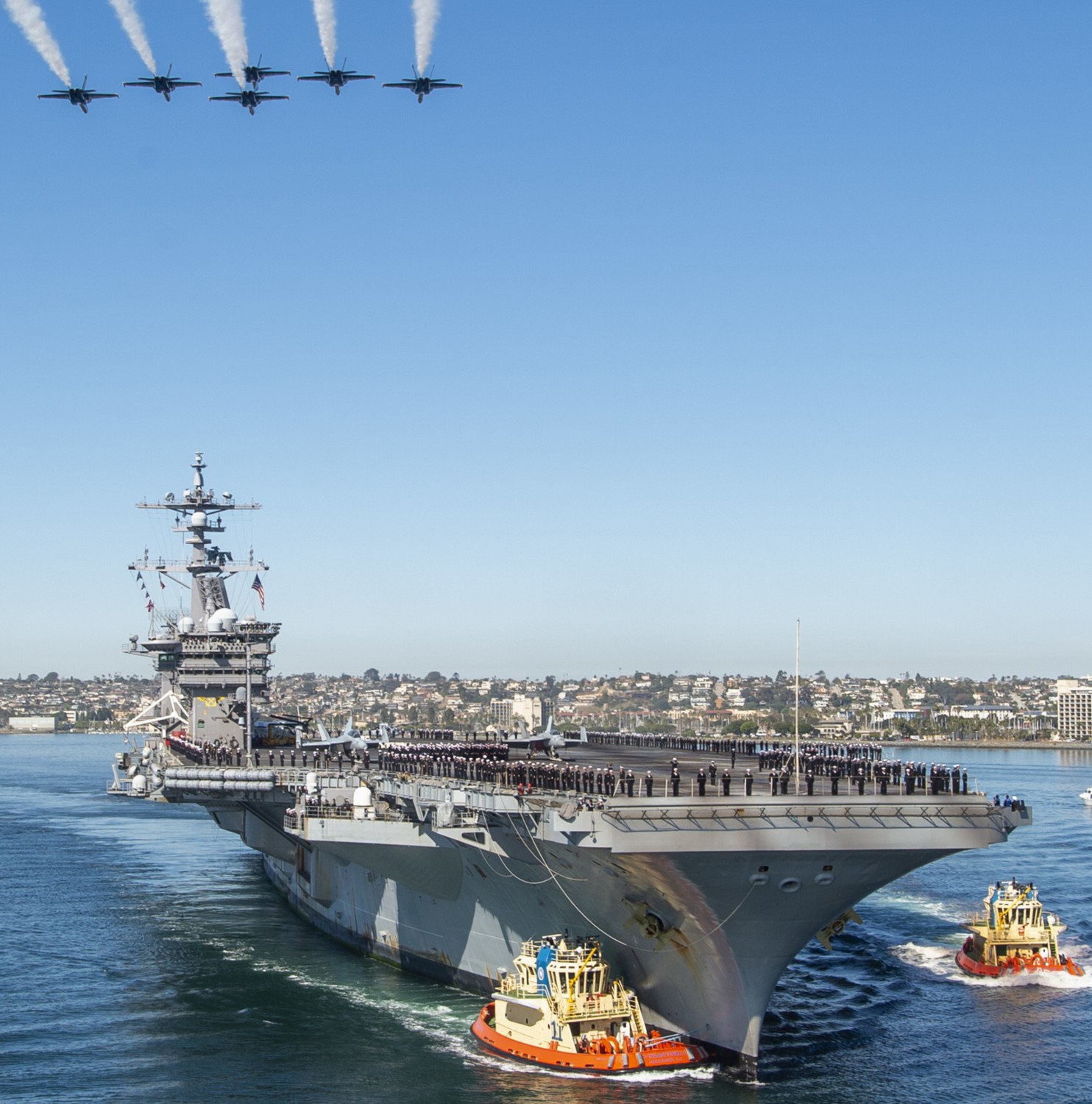 returning to NAS North Island, San Diego, California - February 2022 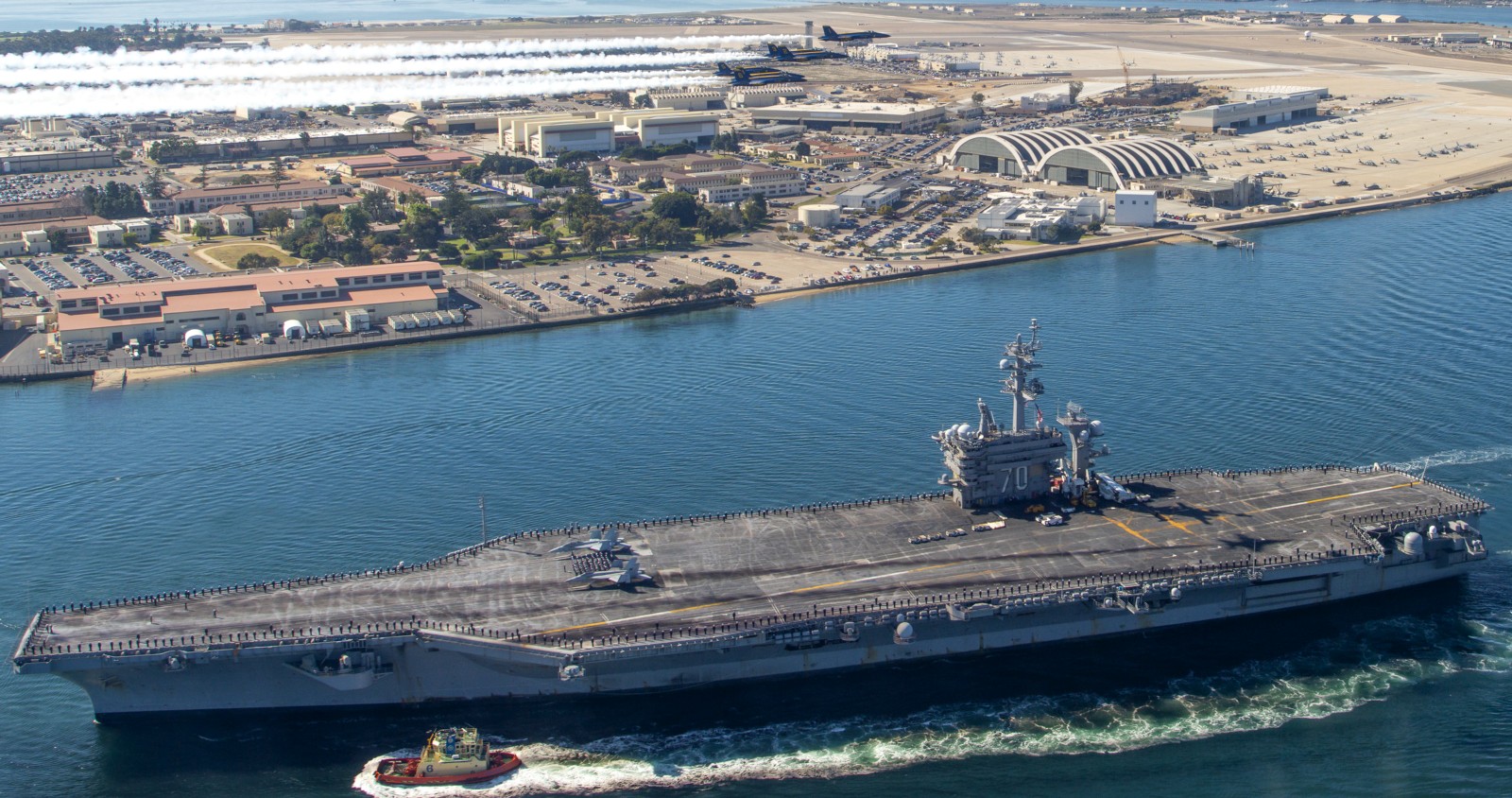 returning to NAS North Island, San Diego, California - February 2022  returning to NAS North Island, San Diego, California - February 2022 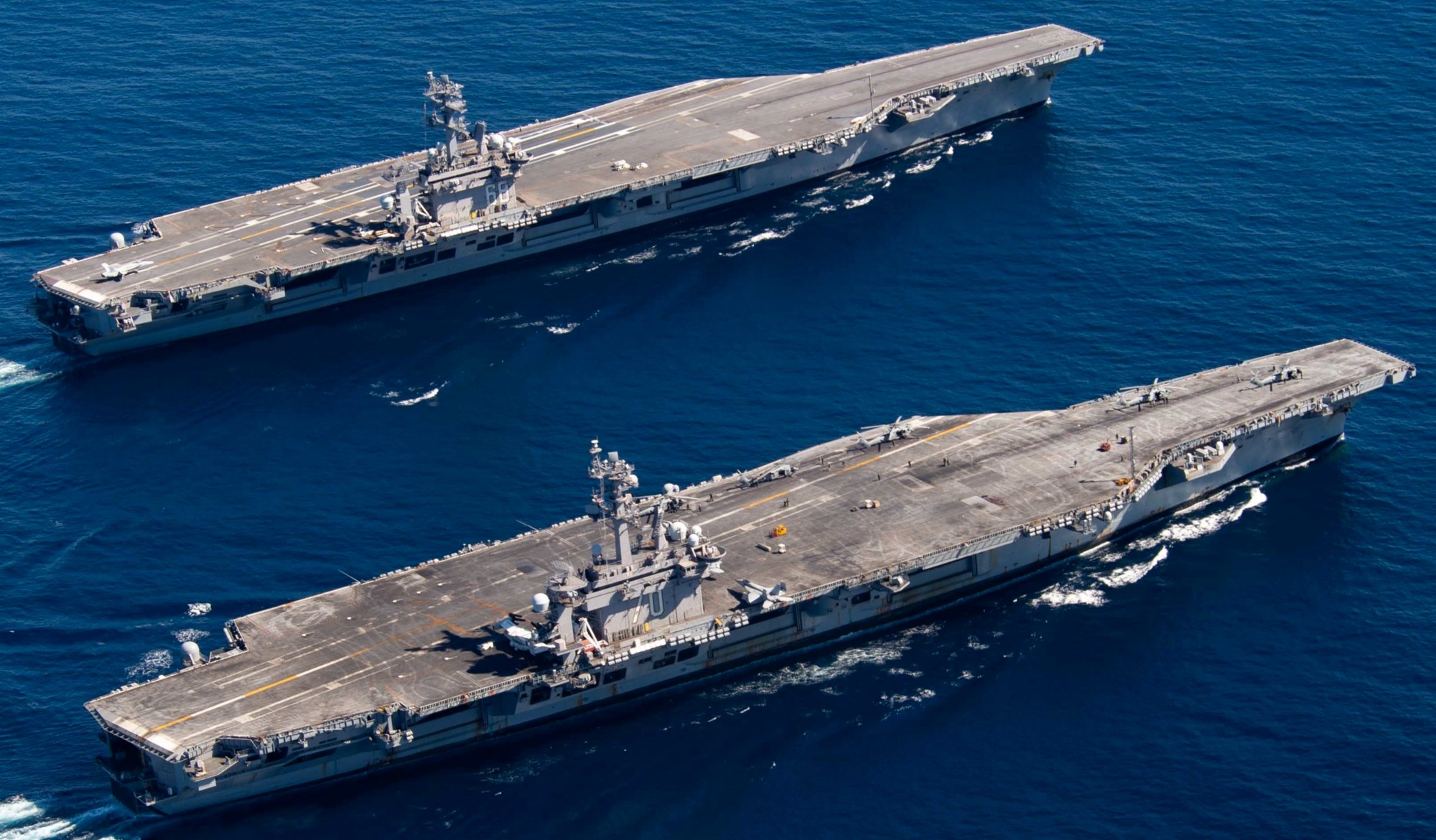 with USS Nimitz (CVN 68) - Pacific Ocean - February 2022  with CVW-2 embarked - Joint Base Pearl Harbor-Hickam, Hawaii - February 2022 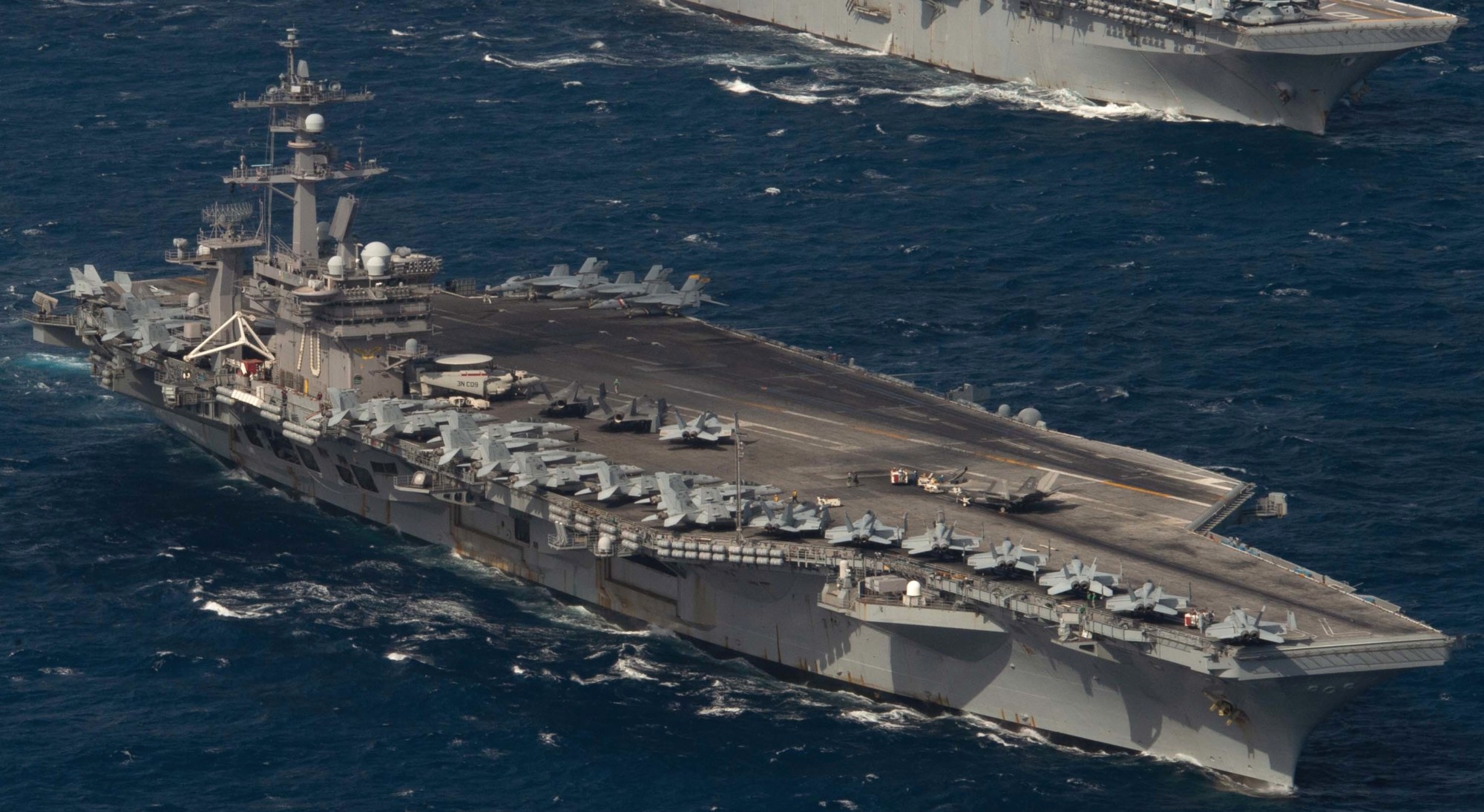 with CVW-2 embarked - Philippine Sea - January 2022 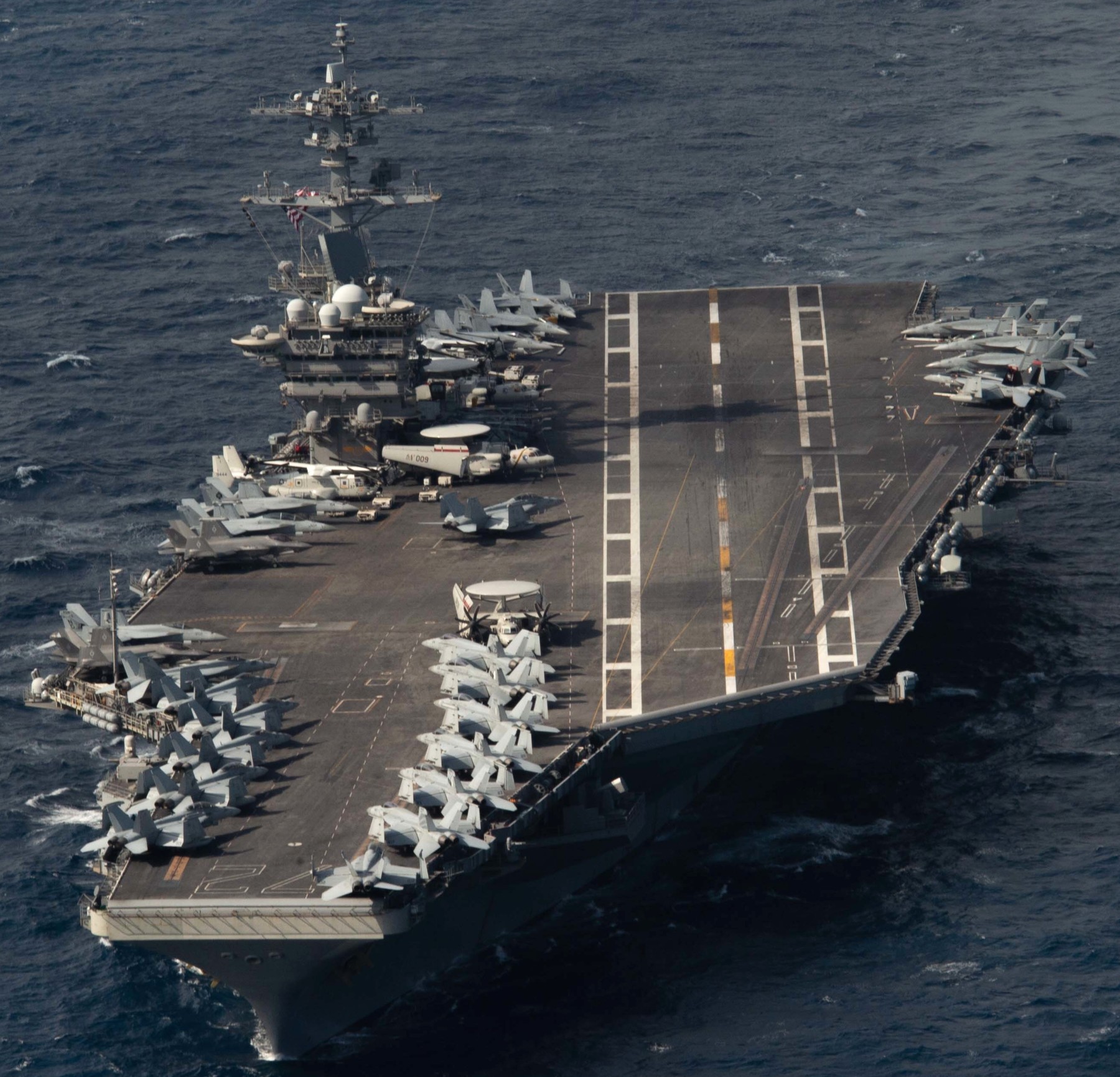 with CVW-2 embarked - Philippine Sea - January 2022 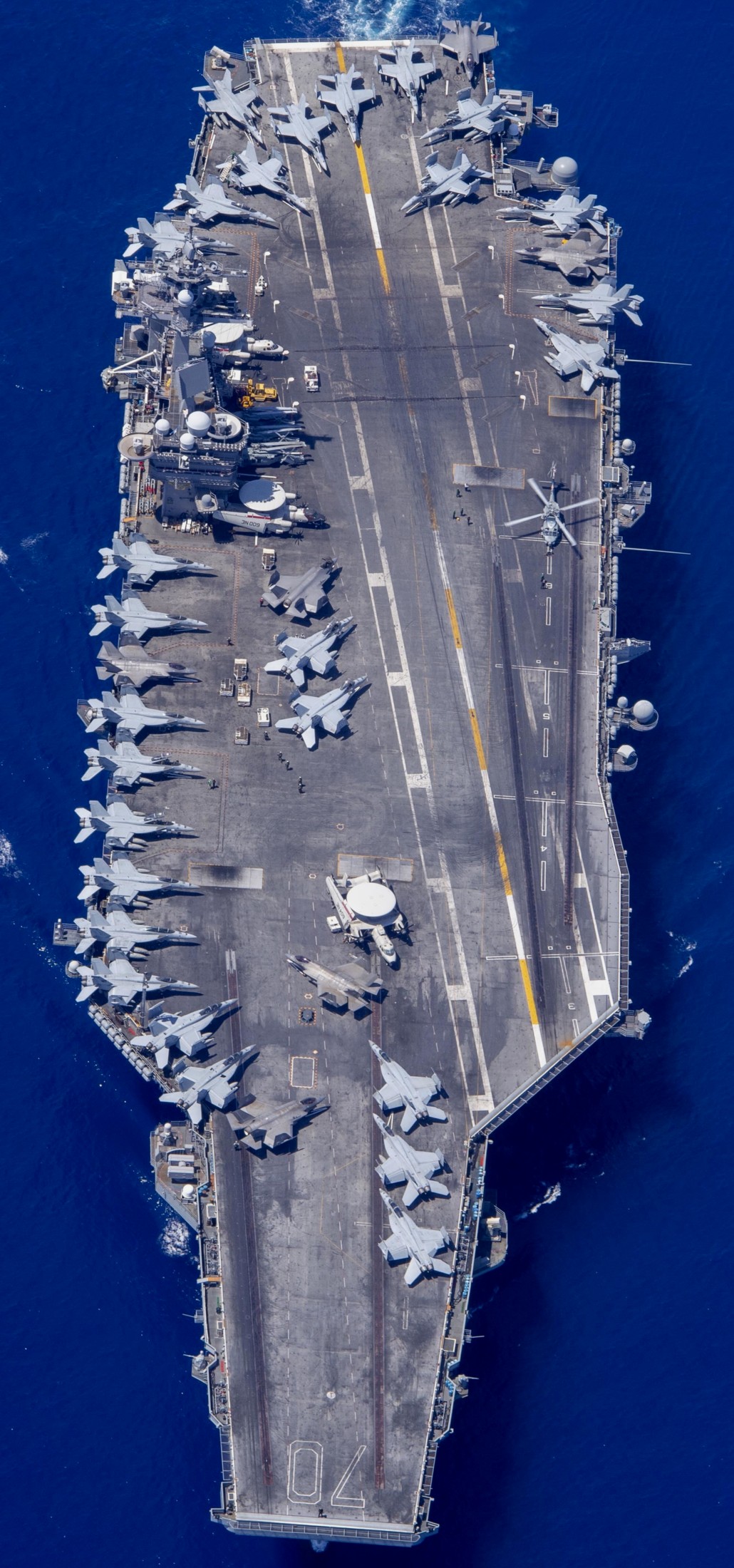
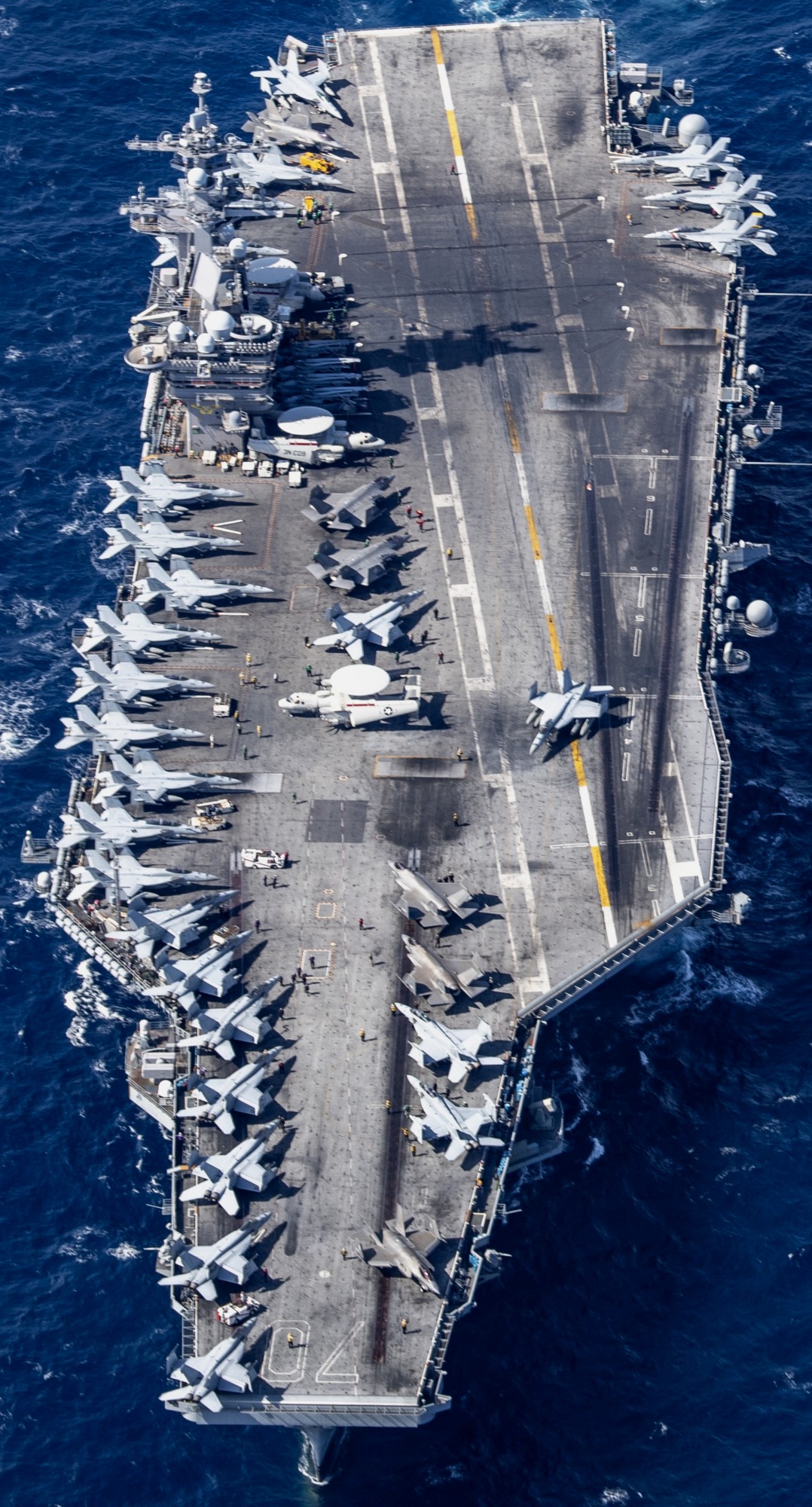 with CVW-2 embarked - Indian Ocean - December 2021  with CVW-2 embarked - Indian Ocean - December 2021  with CVW-2 embarked - Philippine Sea - November 2021  with CVW-2 embarked - Philippine Sea - November 2021  with CVW-2 embarked - Apra Harbor, Guam - November 2021 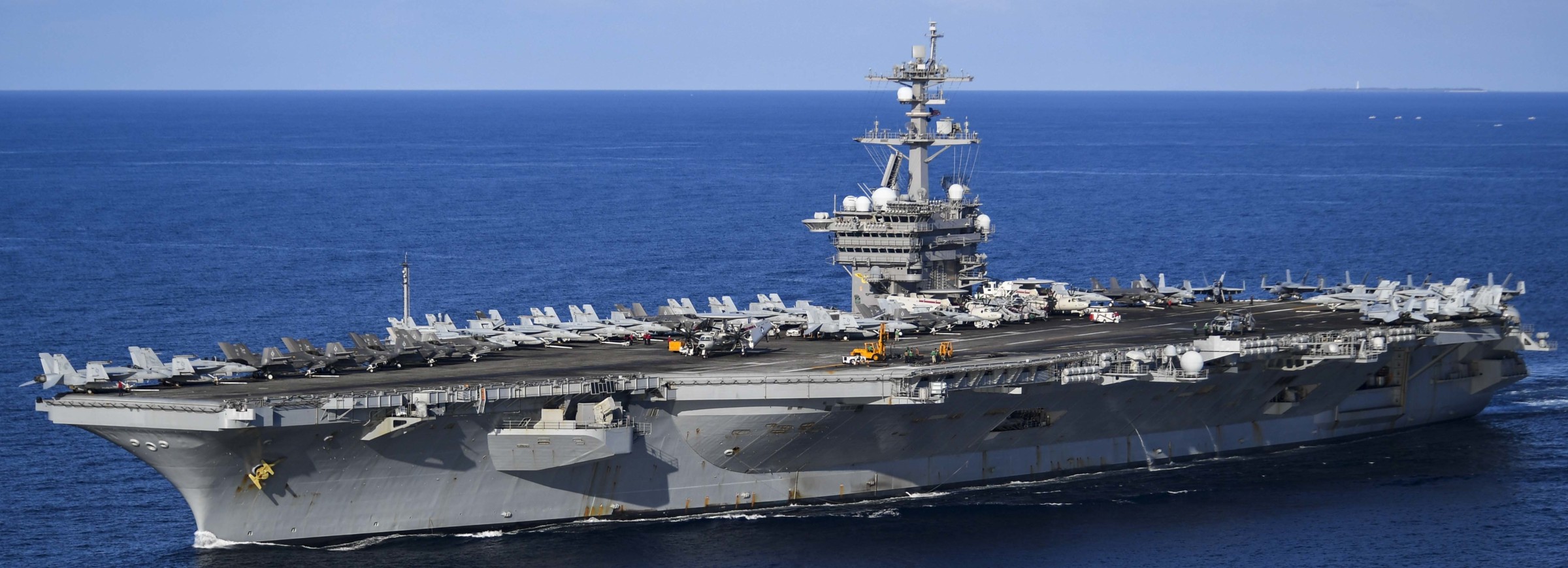 with CVW-2 embarked - South China Sea - November 2021 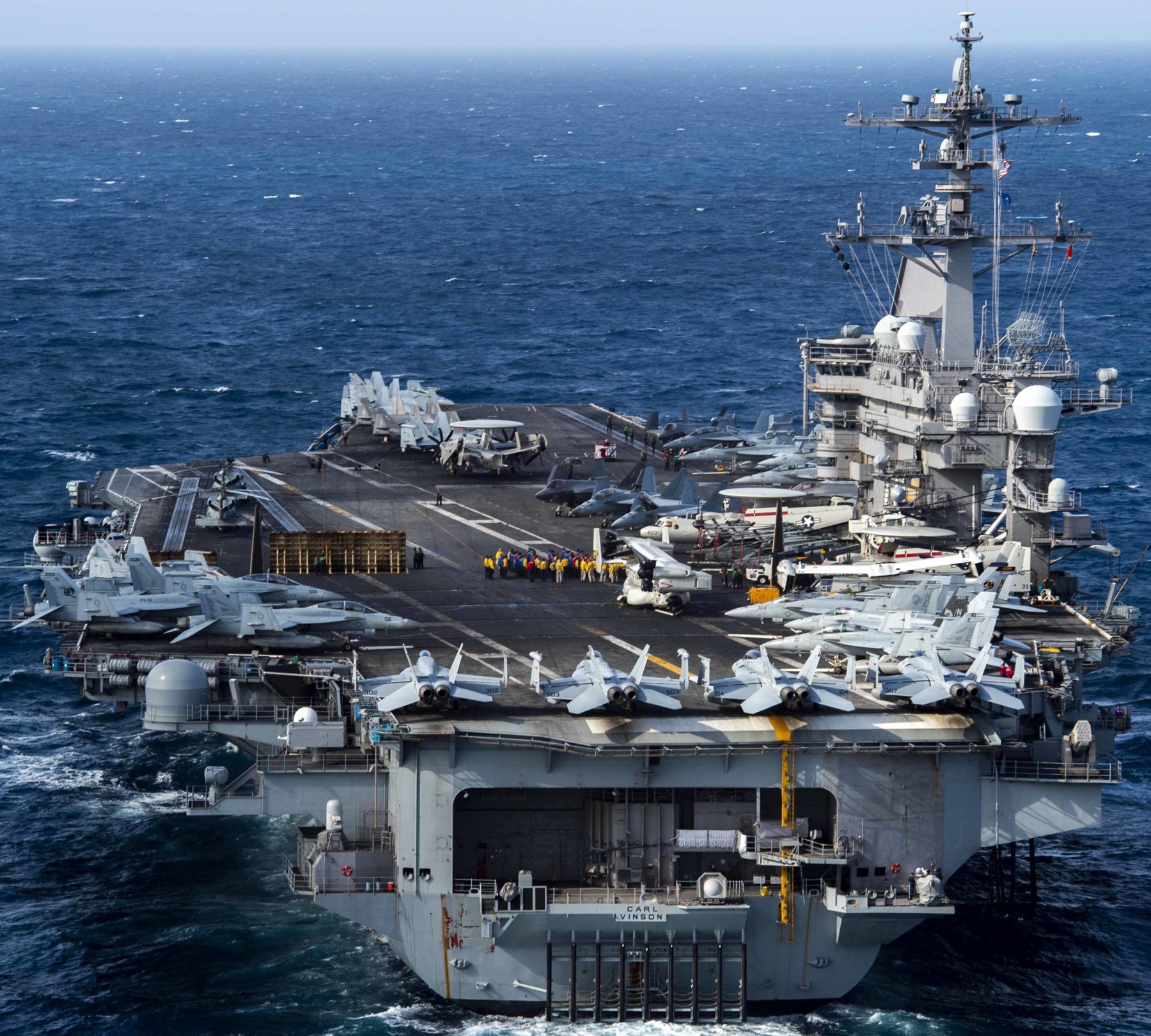 with CVW-2 embarked - exercise MALABAR - Bay of Bengal - October 2021  with CVW-2 embarked - exercise MALABAR - Bay of Bengal - October 2021  with CVW-2 embarked - exercise MALABAR - Bay of Bengal - October 2021 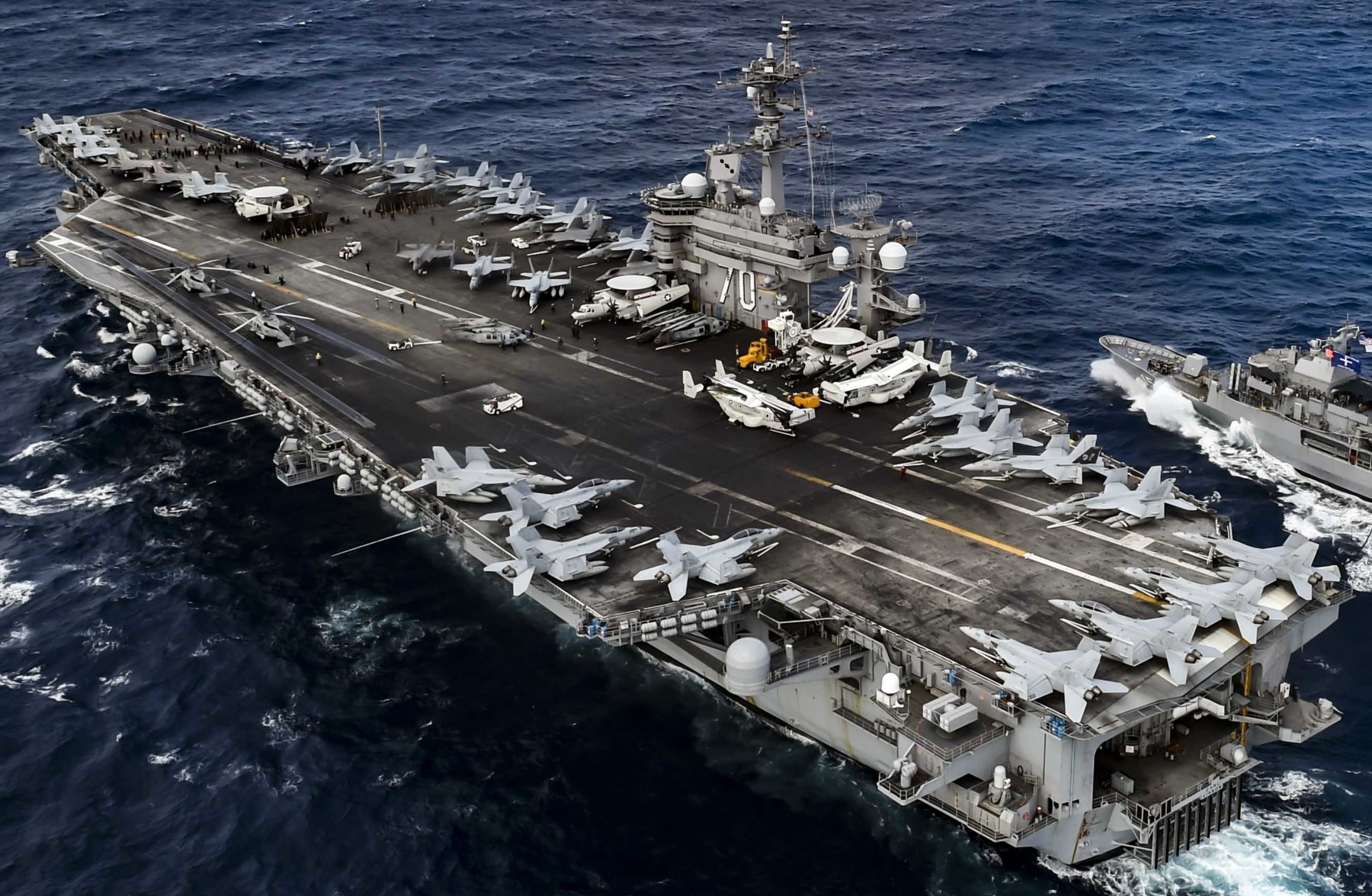 with CVW-2 embarked - exercise MALABAR - Bay of Bengal - October 2021  with CVW-2 embarked - exercise MALABAR - Bay of Bengal - October 2021 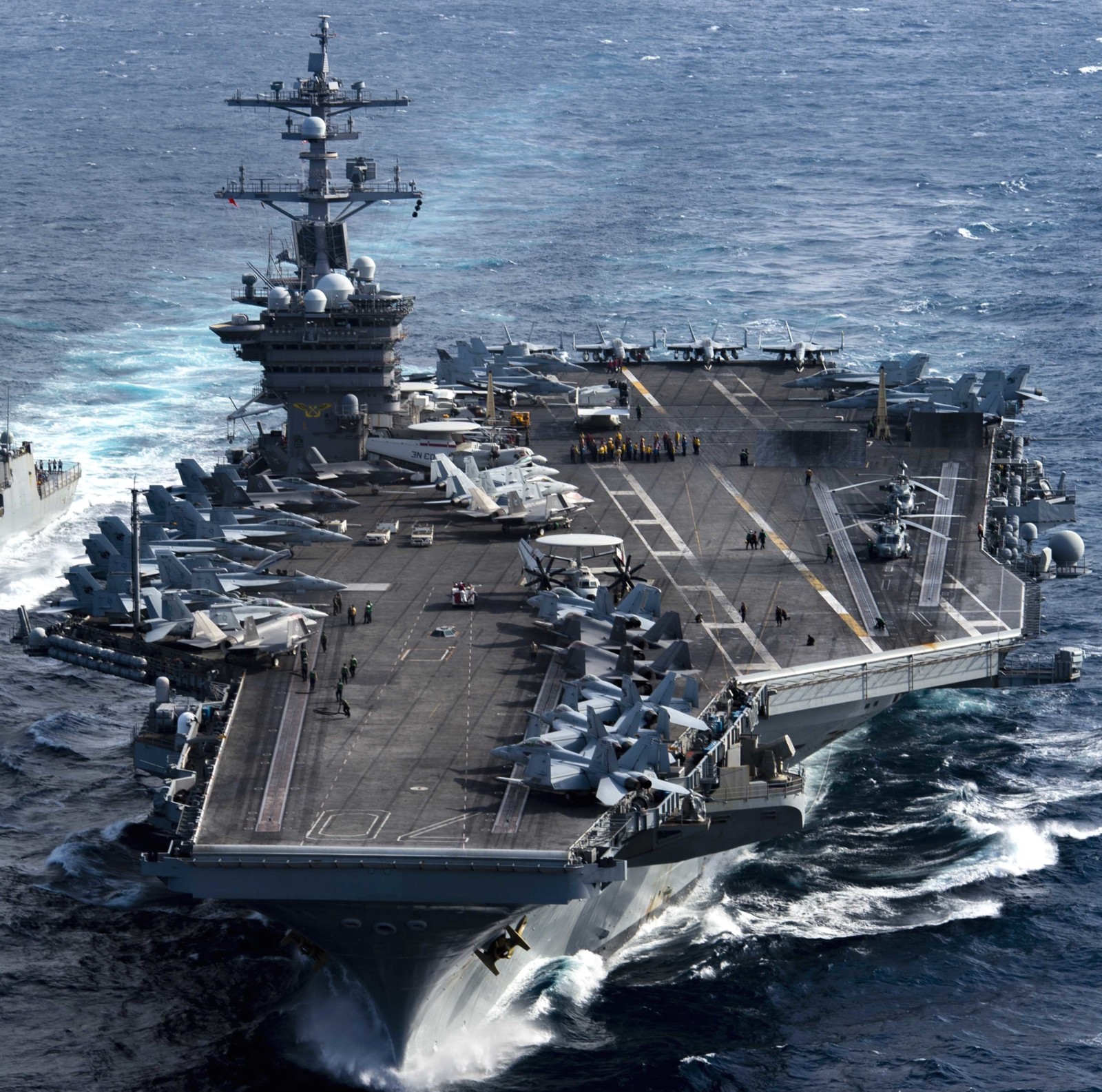 with CVW-2 embarked - exercise MALABAR - Bay of Bengal - October 2021 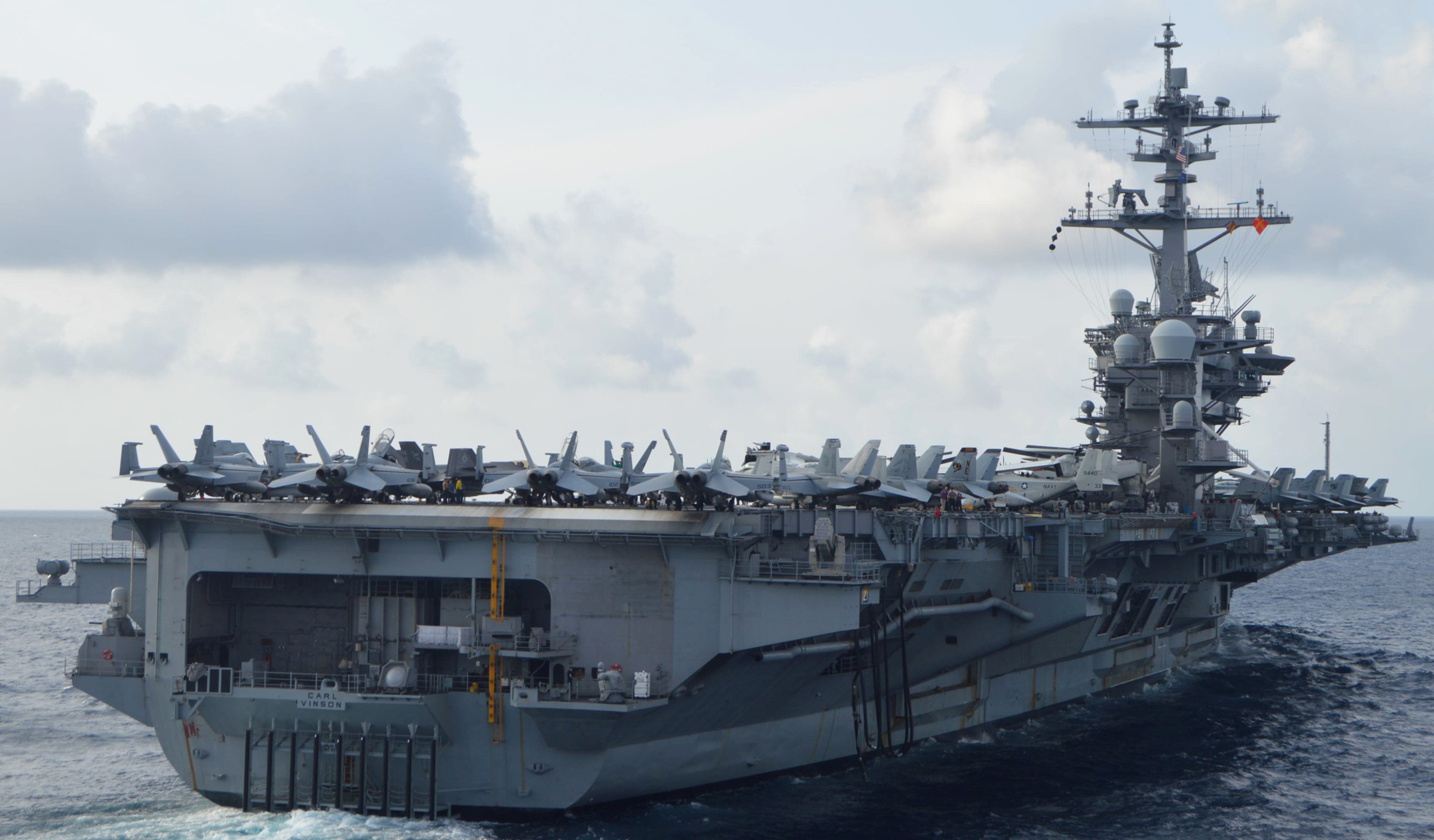 with CVW-2 embarked - exercise MALABAR - Bay of Bengal - October 2021 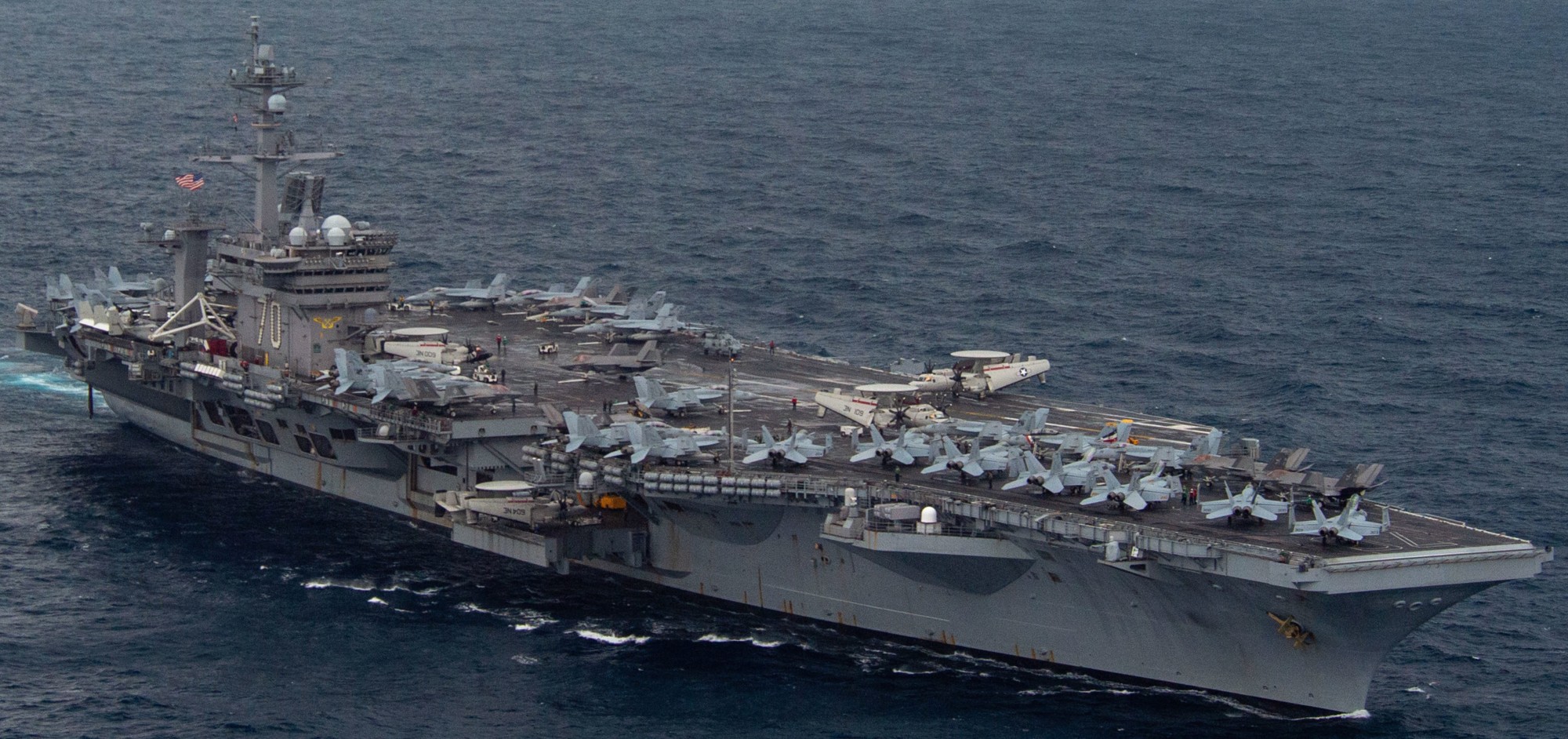 with CVW-2 embarked - exercise MALABAR - Bay of Bengal - October 2021 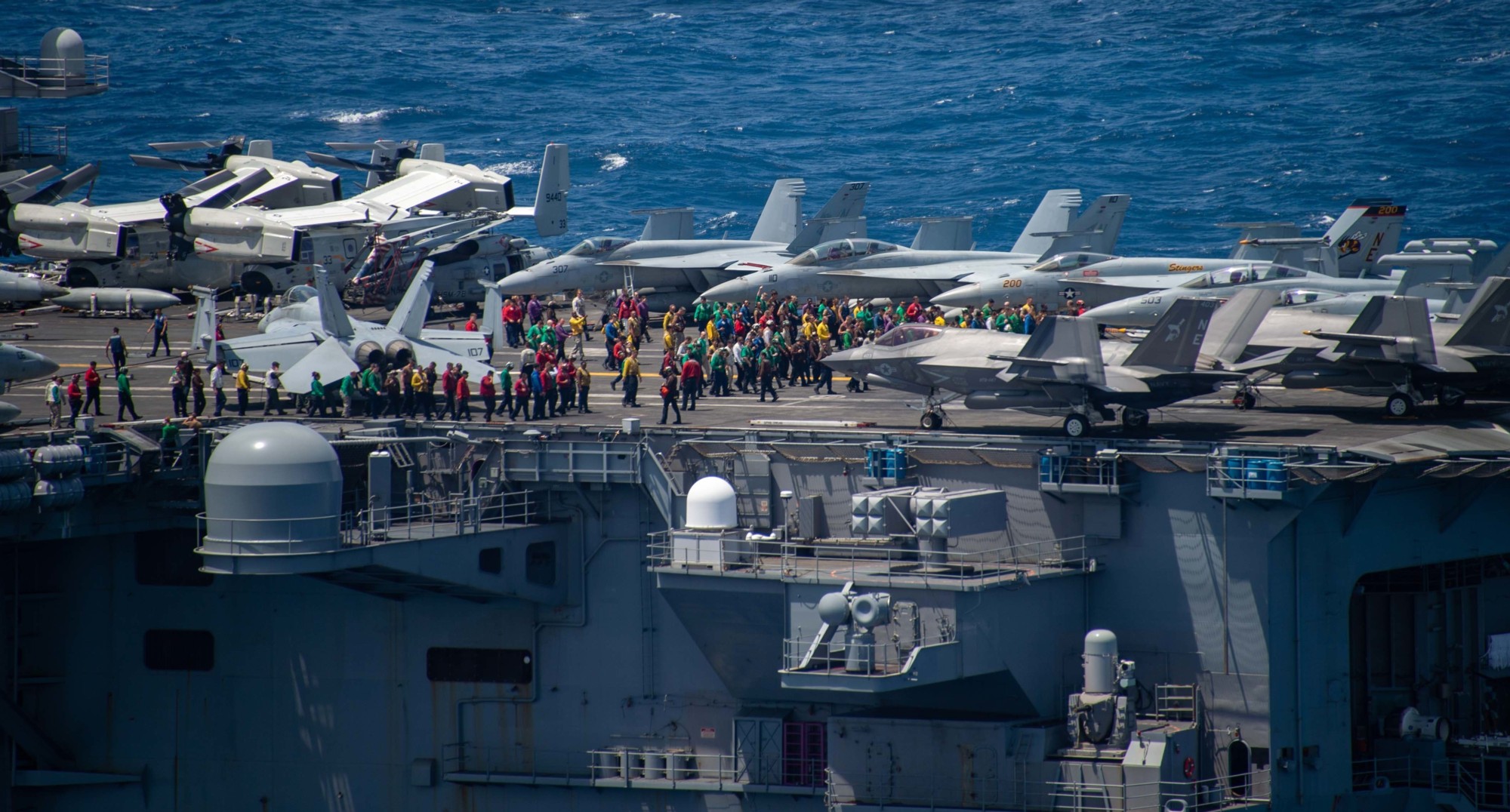 with CVW-2 embarked - Indian Ocean - October 2021  with CVW-2 embarked - Philippine Sea - October 2021 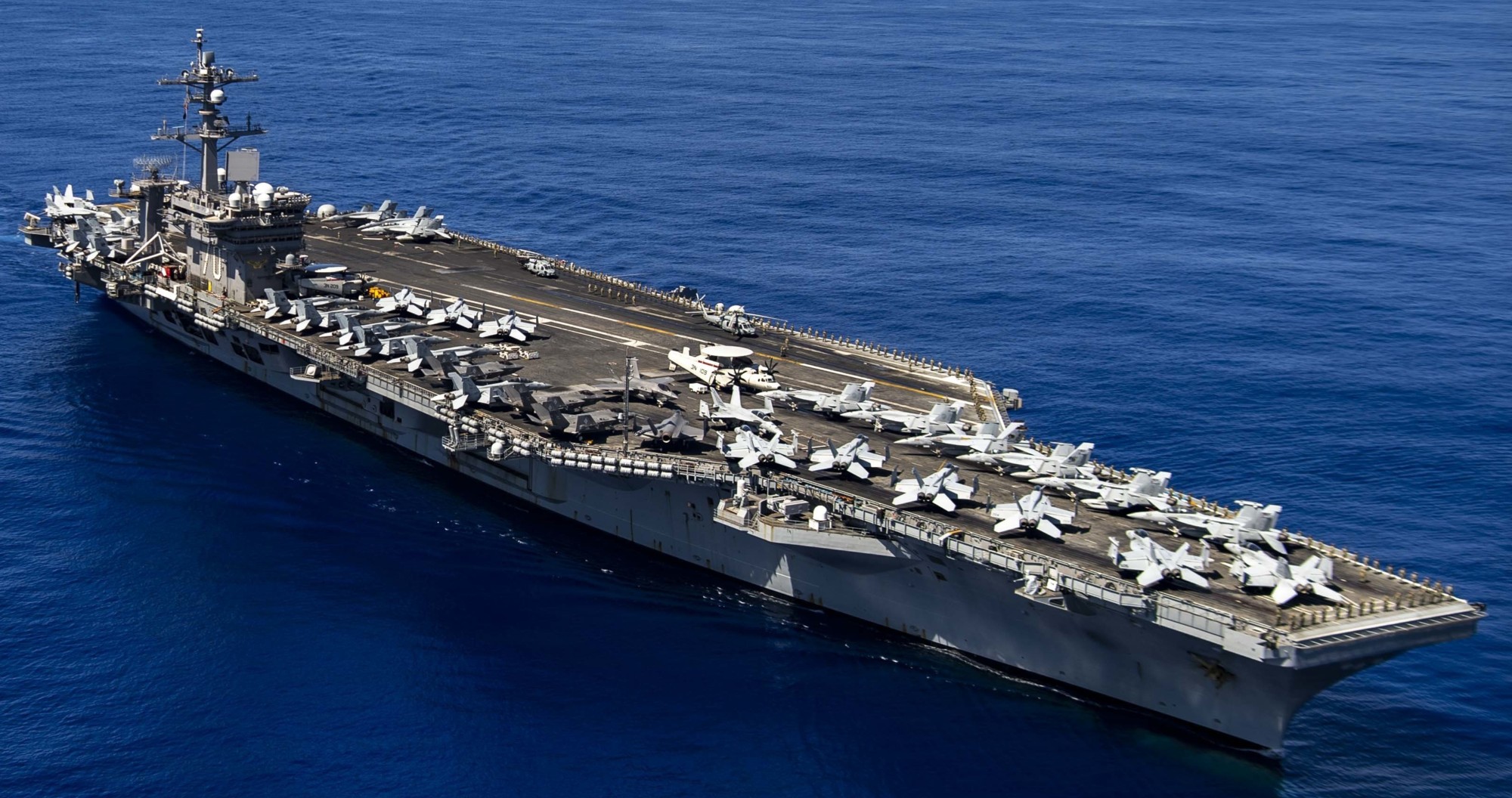 with CVW-2 embarked - Philippine Sea - September 2021 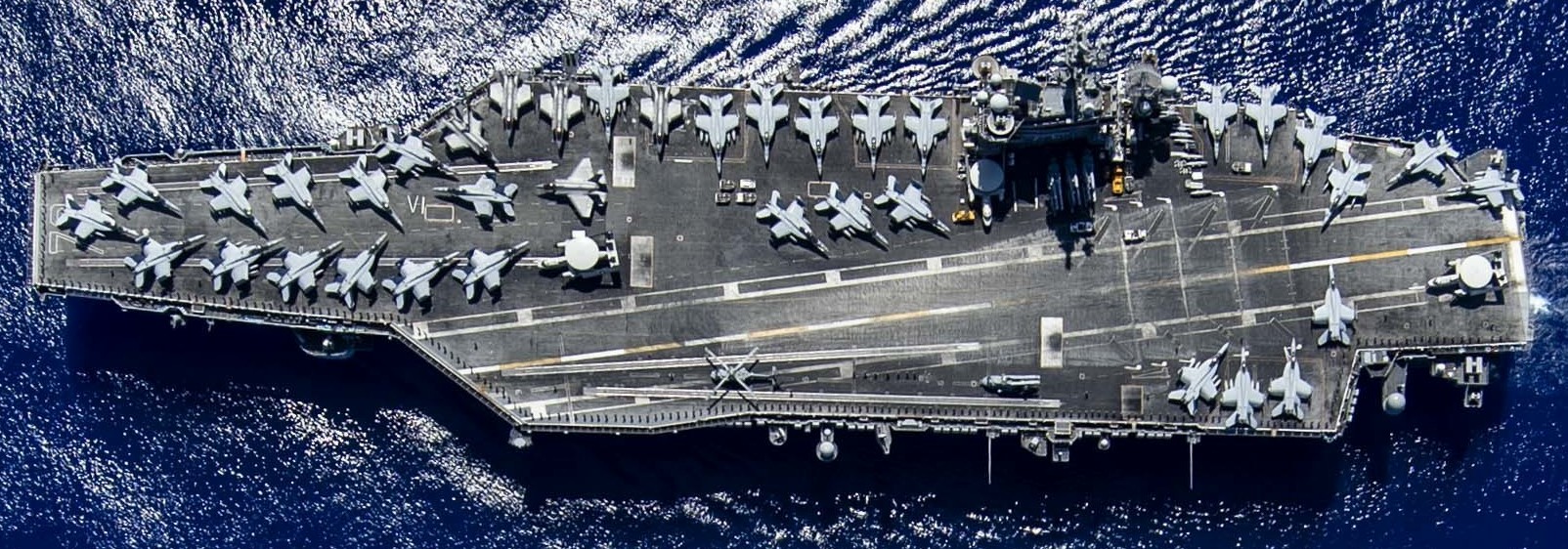 with CVW-2 embarked - Philippine Sea - September 2021  with CVW-2 embarked - Philippine Sea - September 2021  with CVW-2 embarked - Bohol Sea - September 2021 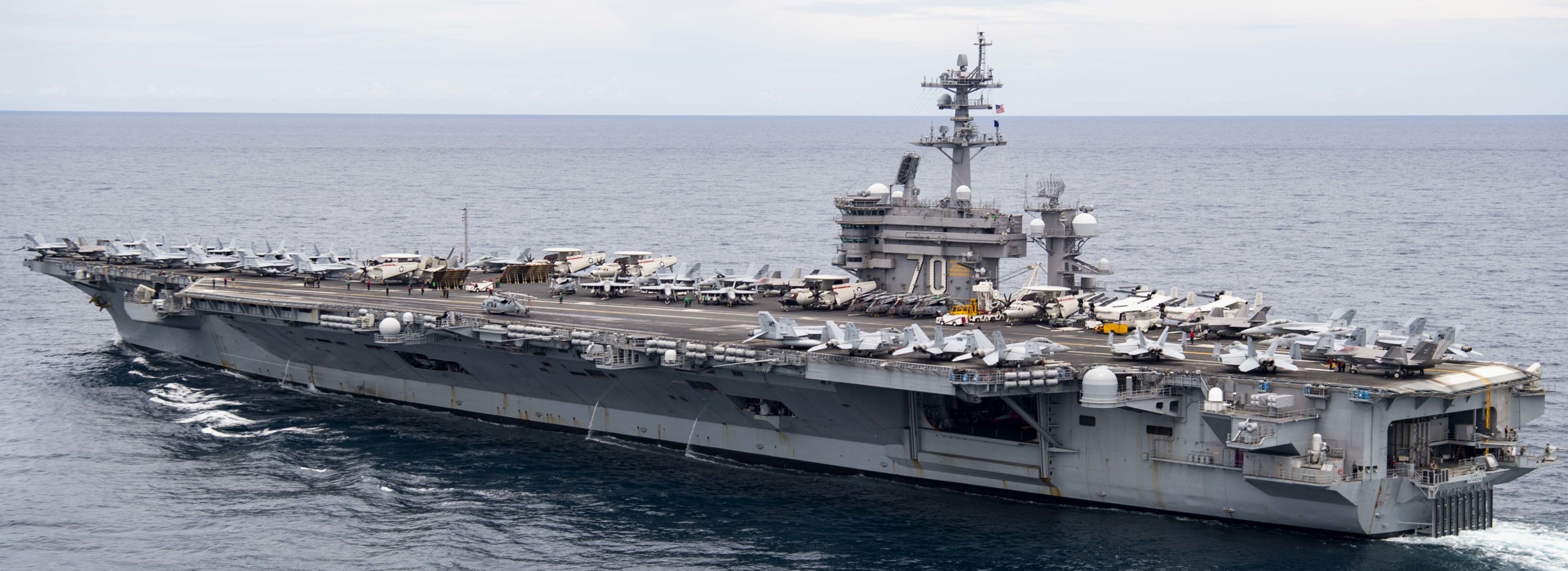 with CVW-2 embarked - South China Sea - September 2021 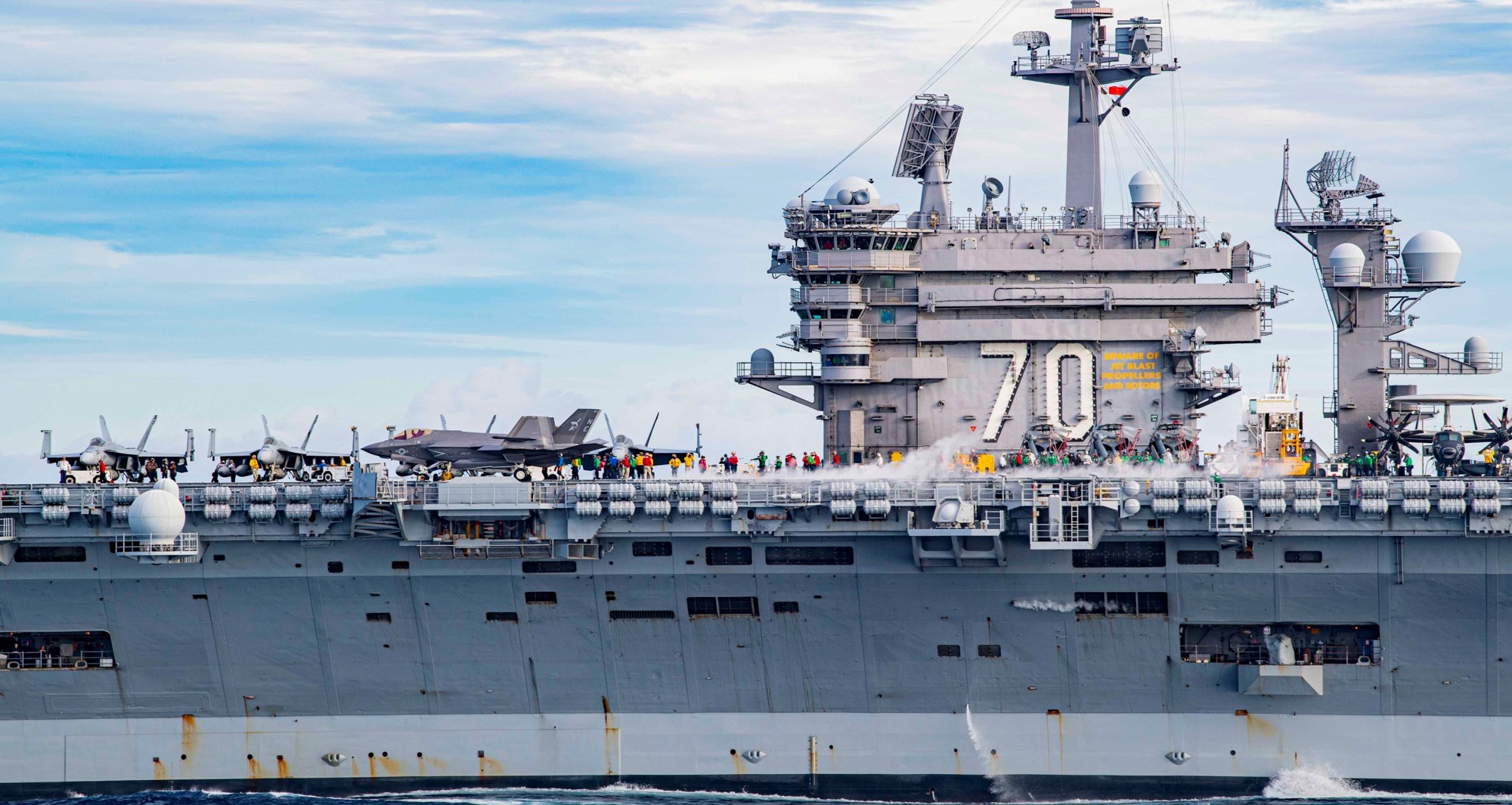 with CVW-2 embarked - South China Sea - September 2021  with CVW-2 embarked - South China Sea - September 2021 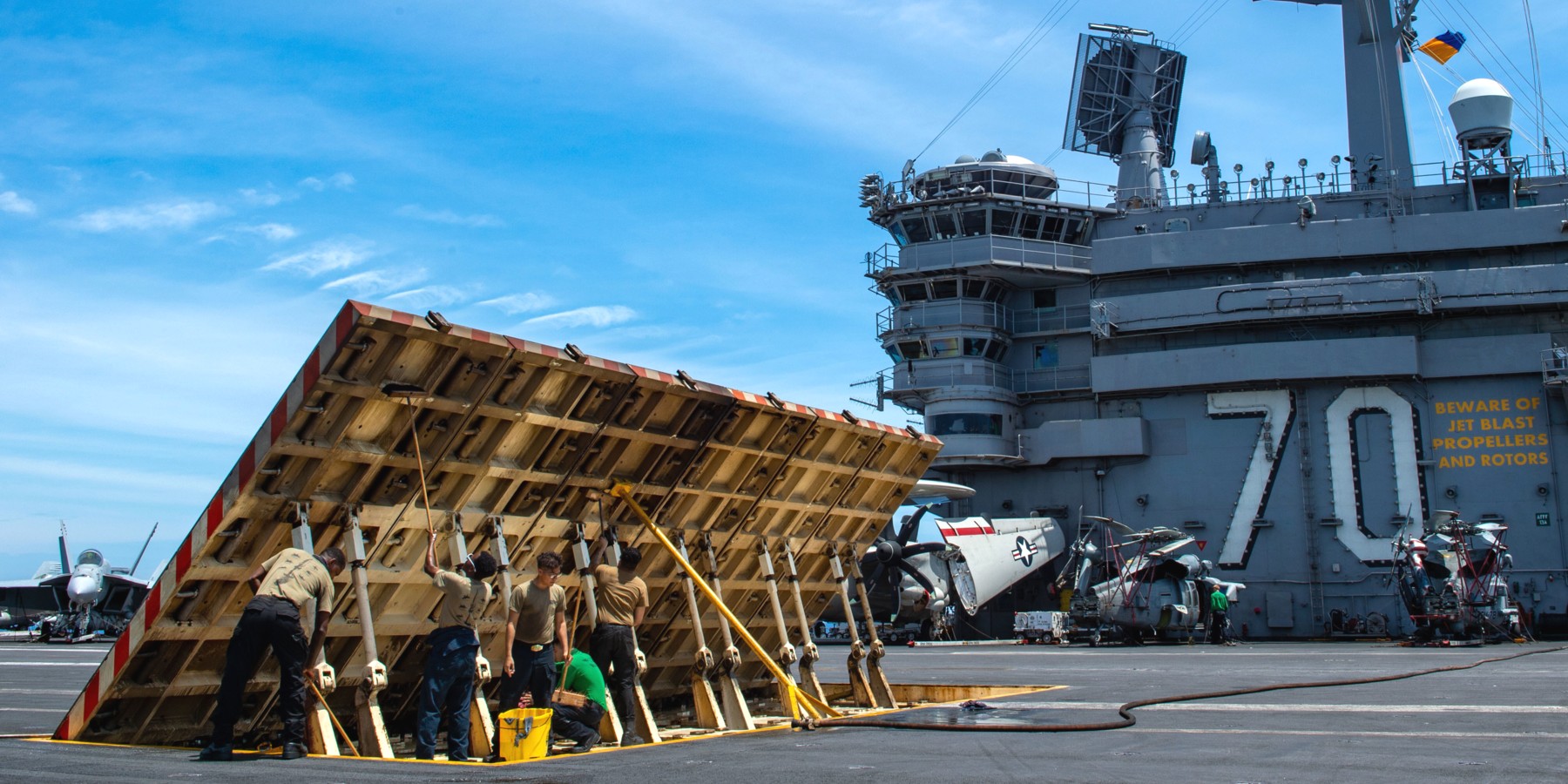 with CVW-2 embarked - South China Sea - September 2021 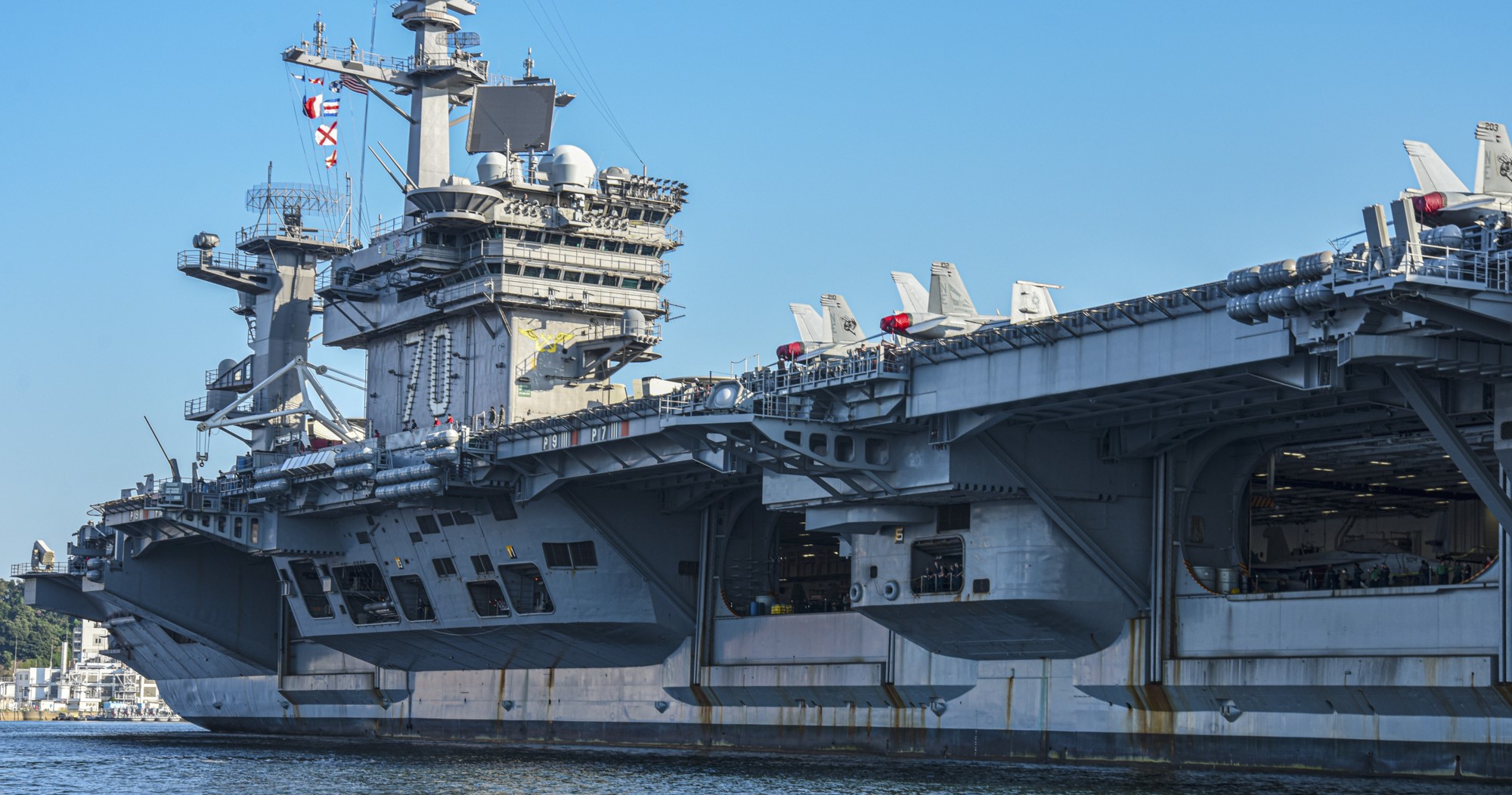 with CVW-2 embarked - Fleet Activities Yokosuka, Japan - August 2021 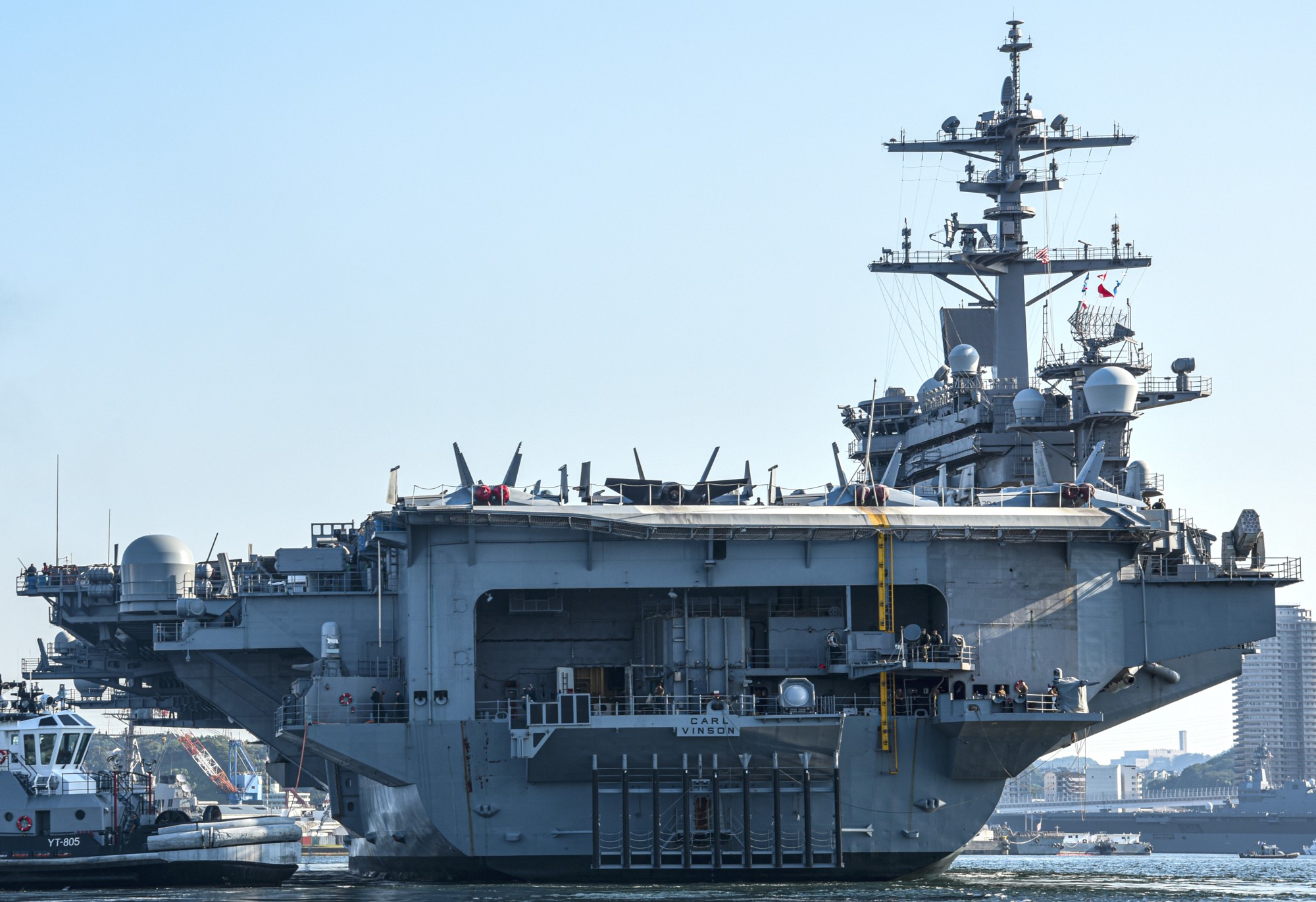 with CVW-2 embarked - Fleet Activities Yokosuka, Japan - August 2021 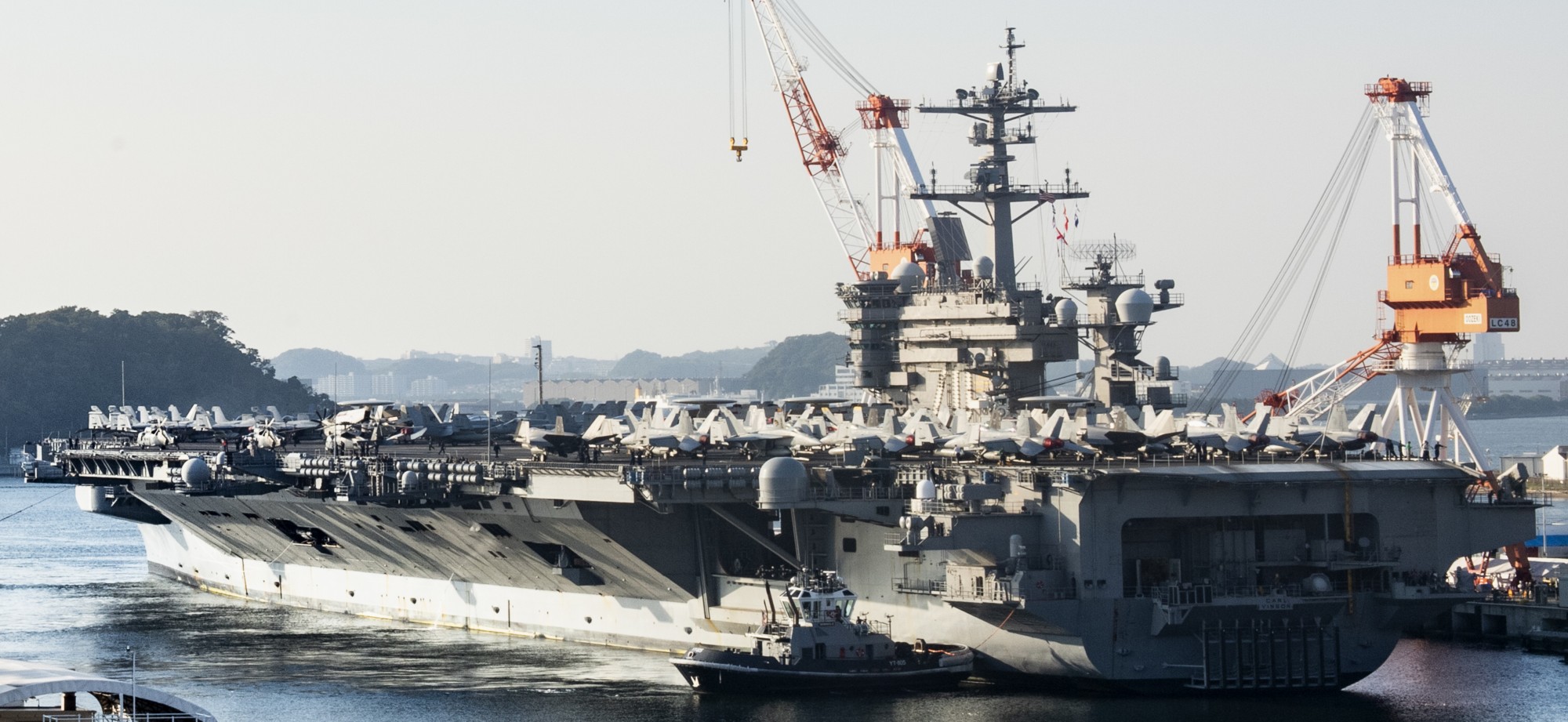 with CVW-2 embarked - Fleet Activities Yokosuka, Japan - August 2021 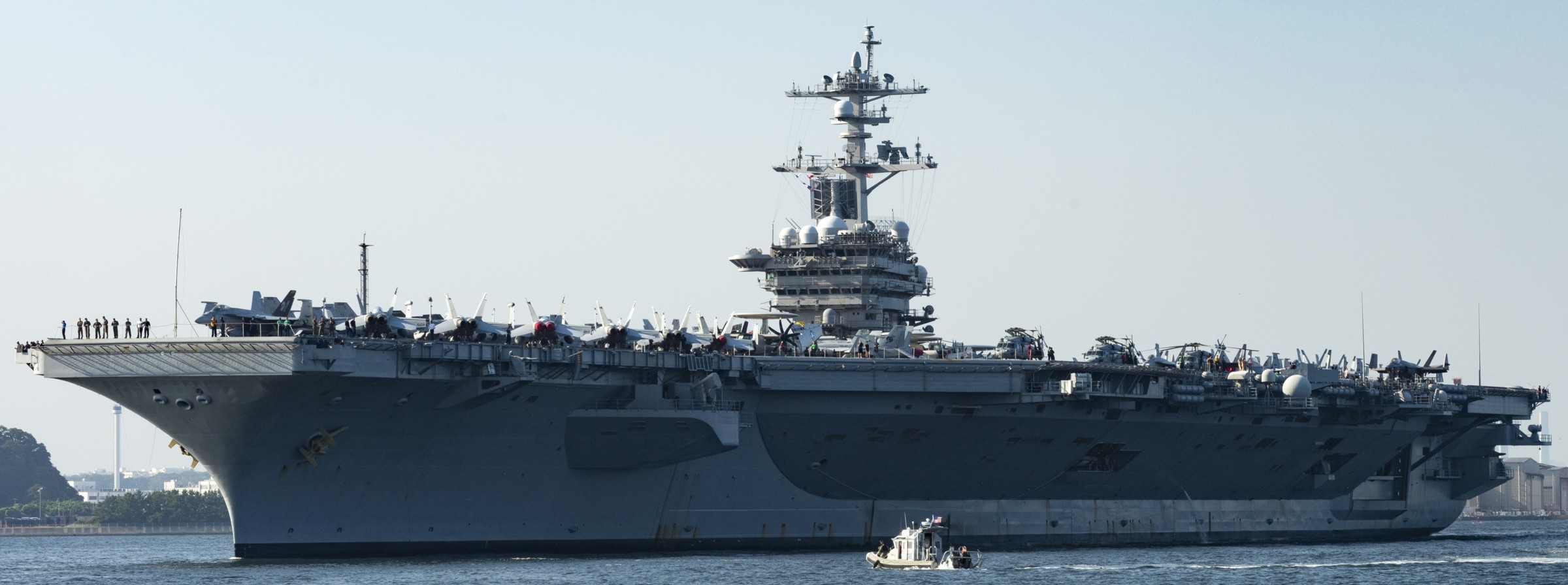 with CVW-2 embarked - Fleet Activities Yokosuka, Japan - August 2021 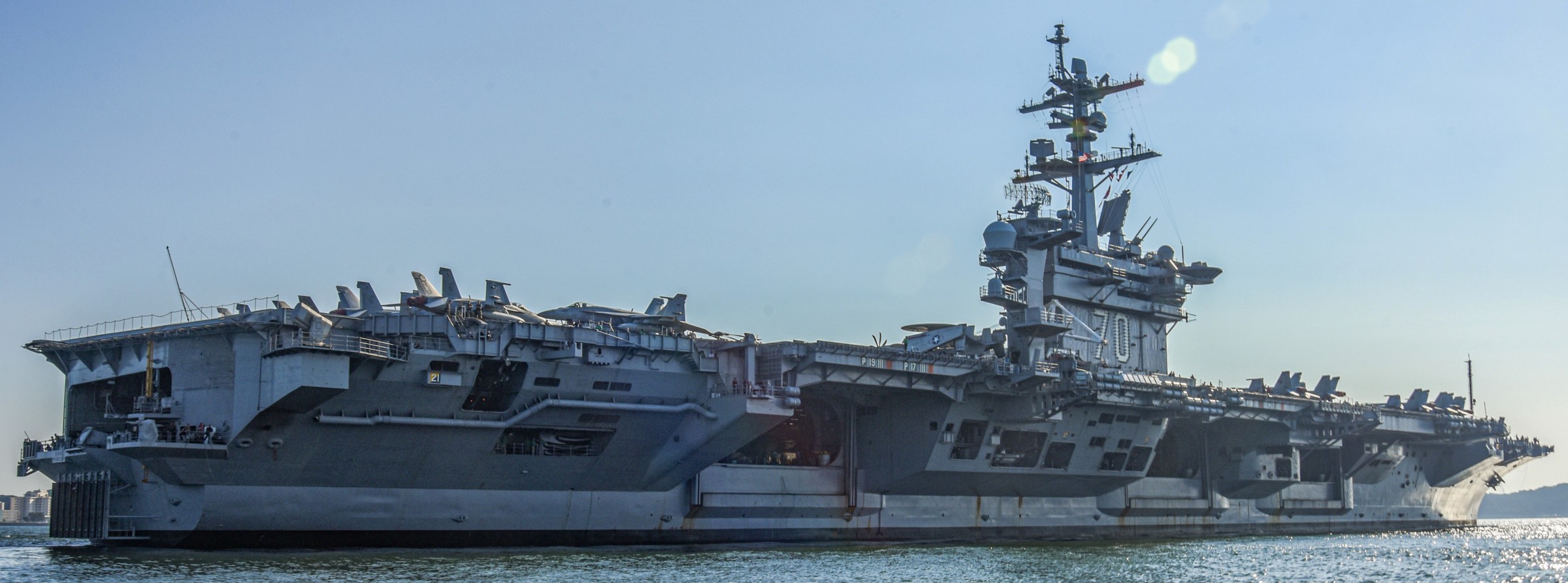 with CVW-2 embarked - Fleet Activities Yokosuka, Japan - August 2021  with CVW-2 embarked - Pacific Ocean - August 2021 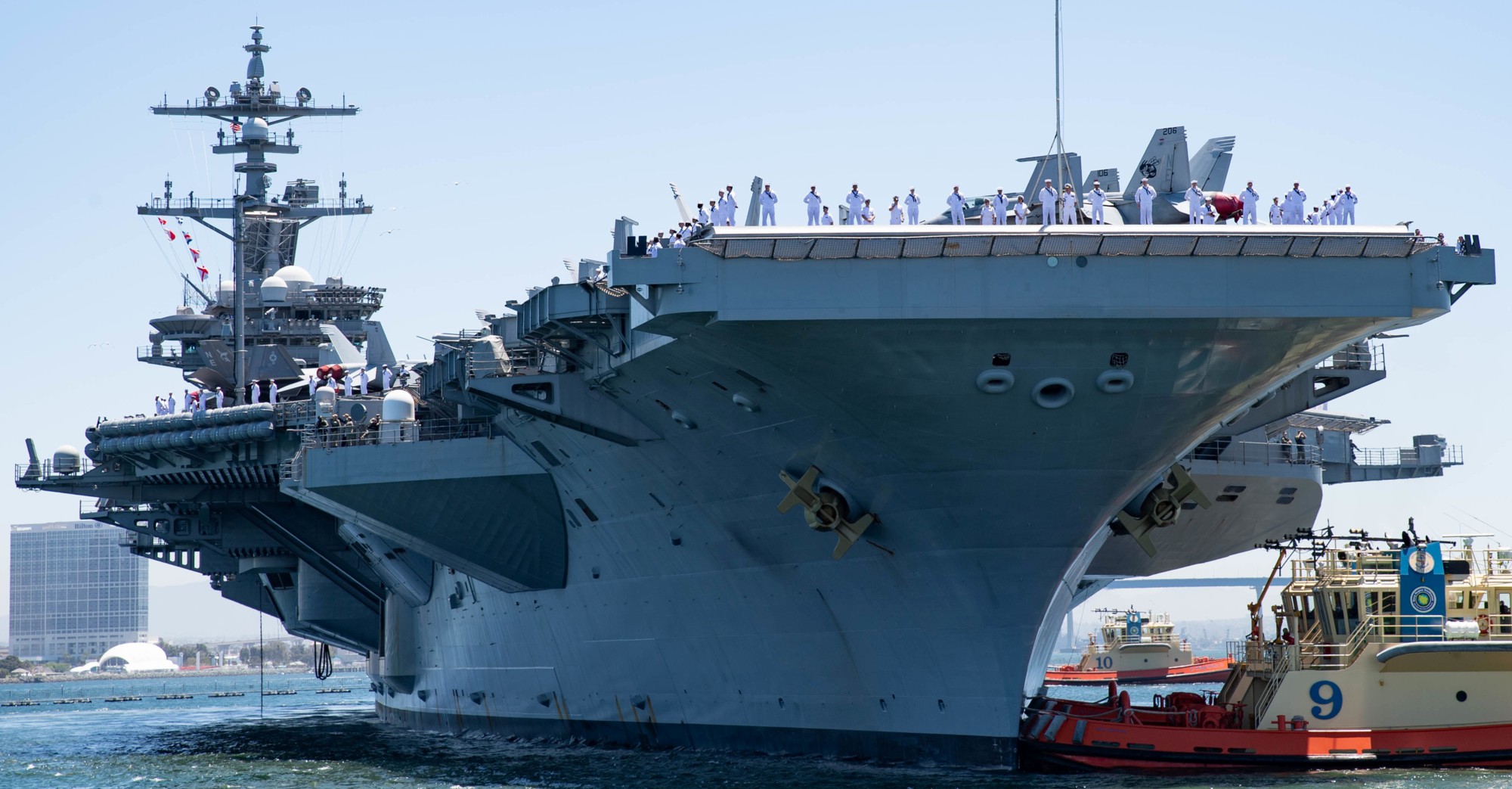 departing NAS North Island, California for deployment - August 2021 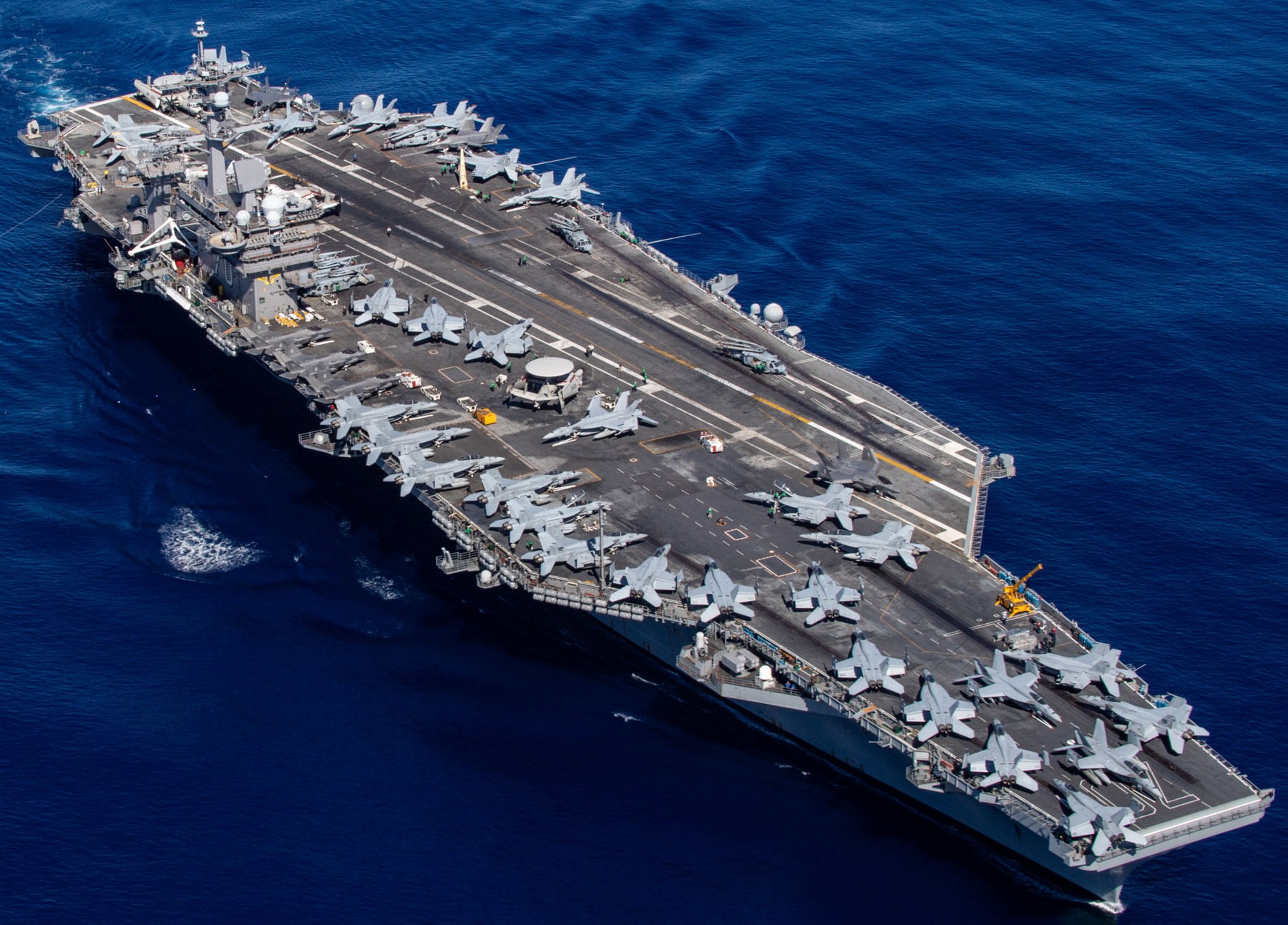 with CVW-2 embarked - COMPTUEX, Pacific Ocean - June 2021 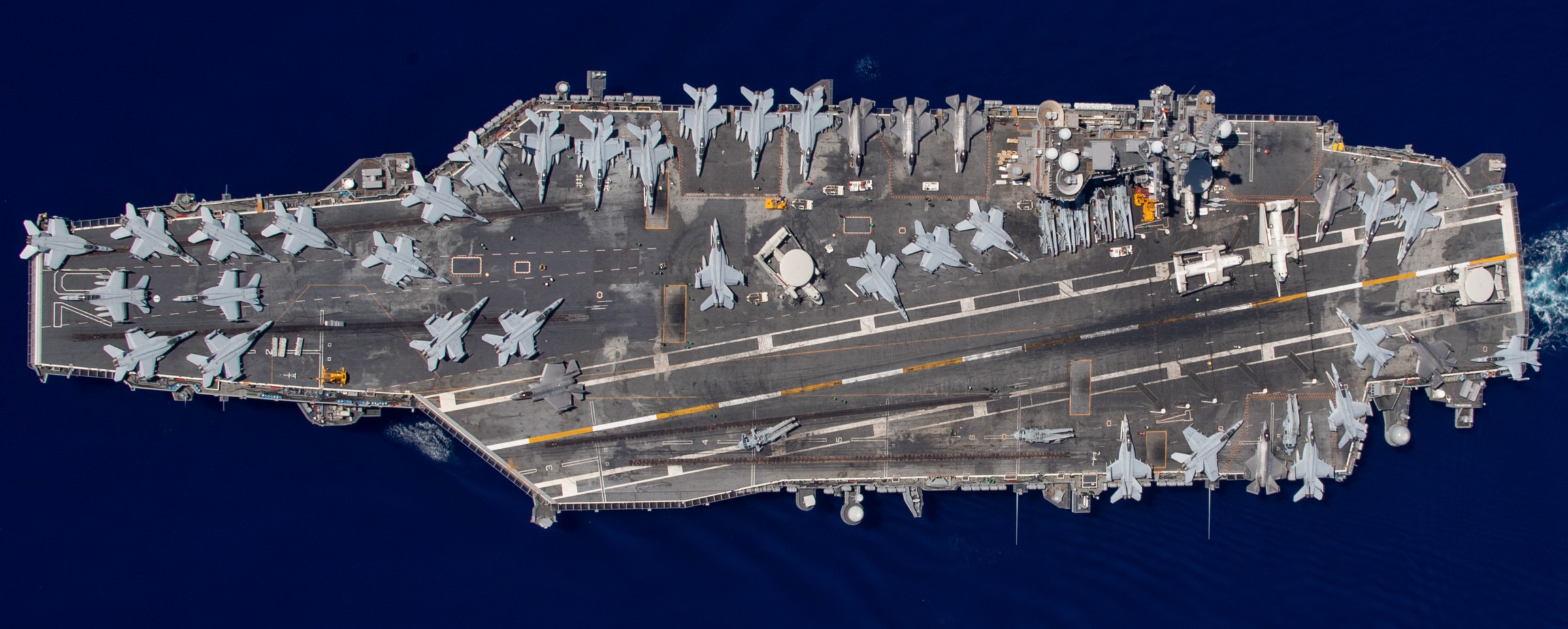 with CVW-2 embarked - COMPTUEX, Pacific Ocean - June 2021 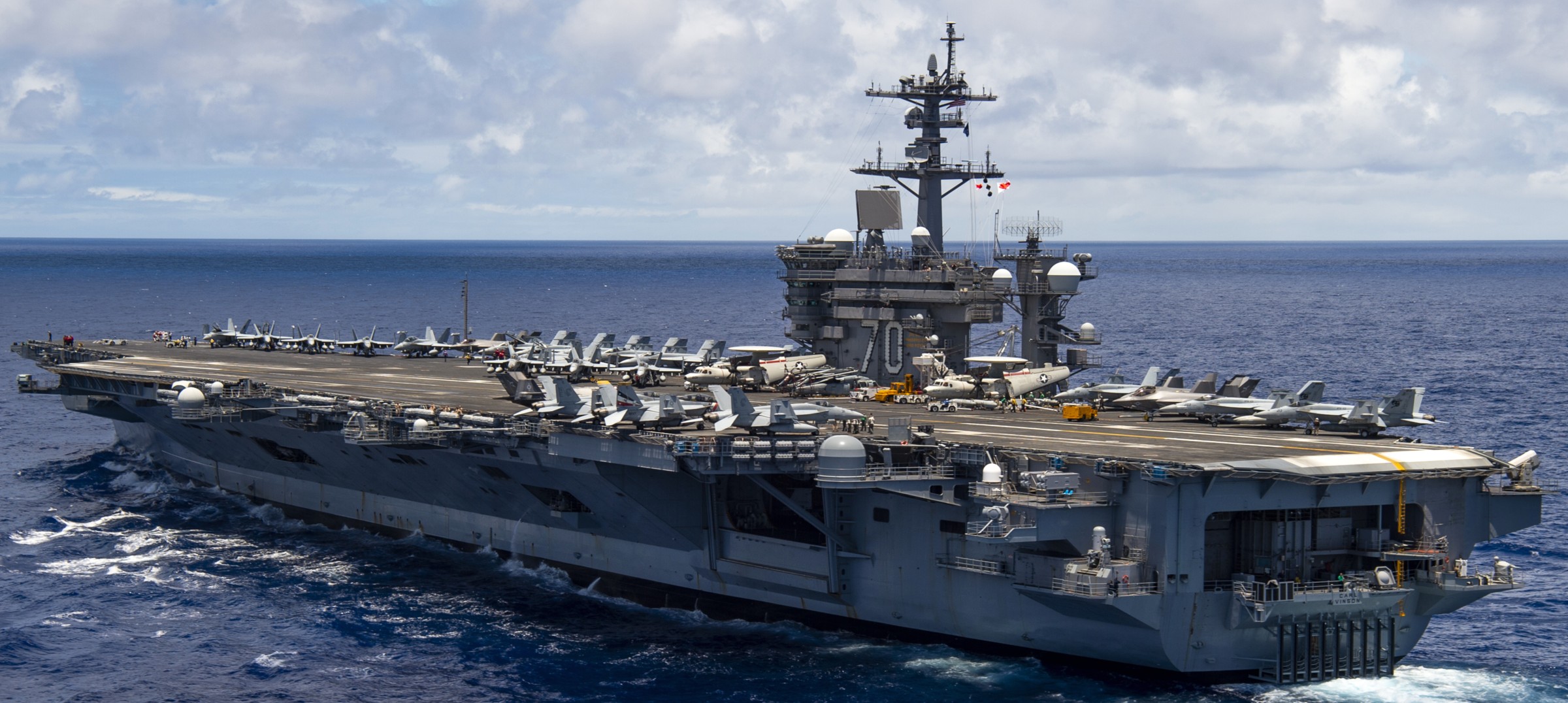 with CVW-2 embarked - COMPTUEX, Pacific Ocean - June 2021 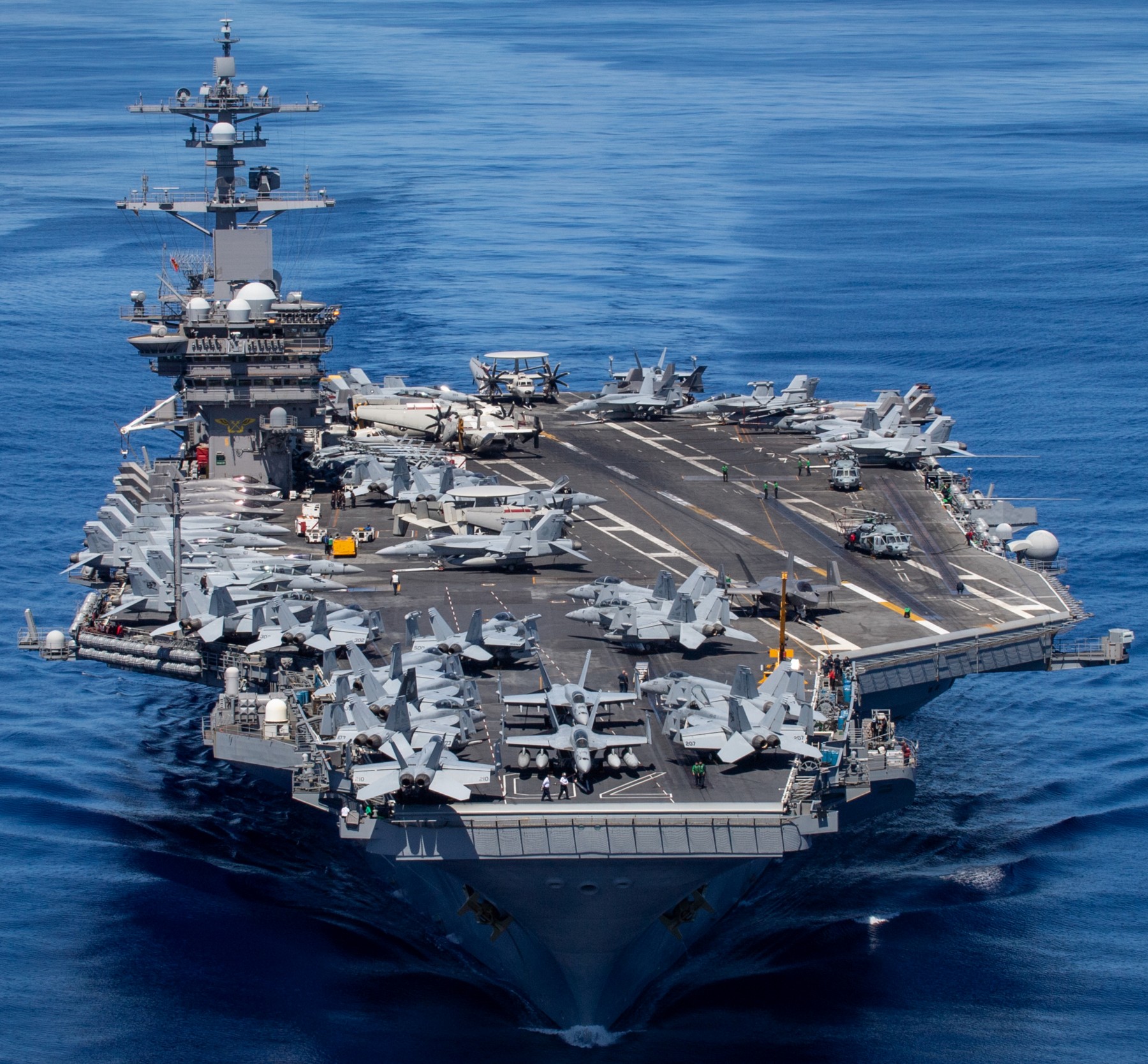 with CVW-2 embarked - COMPTUEX, Pacific Ocean - June 2021 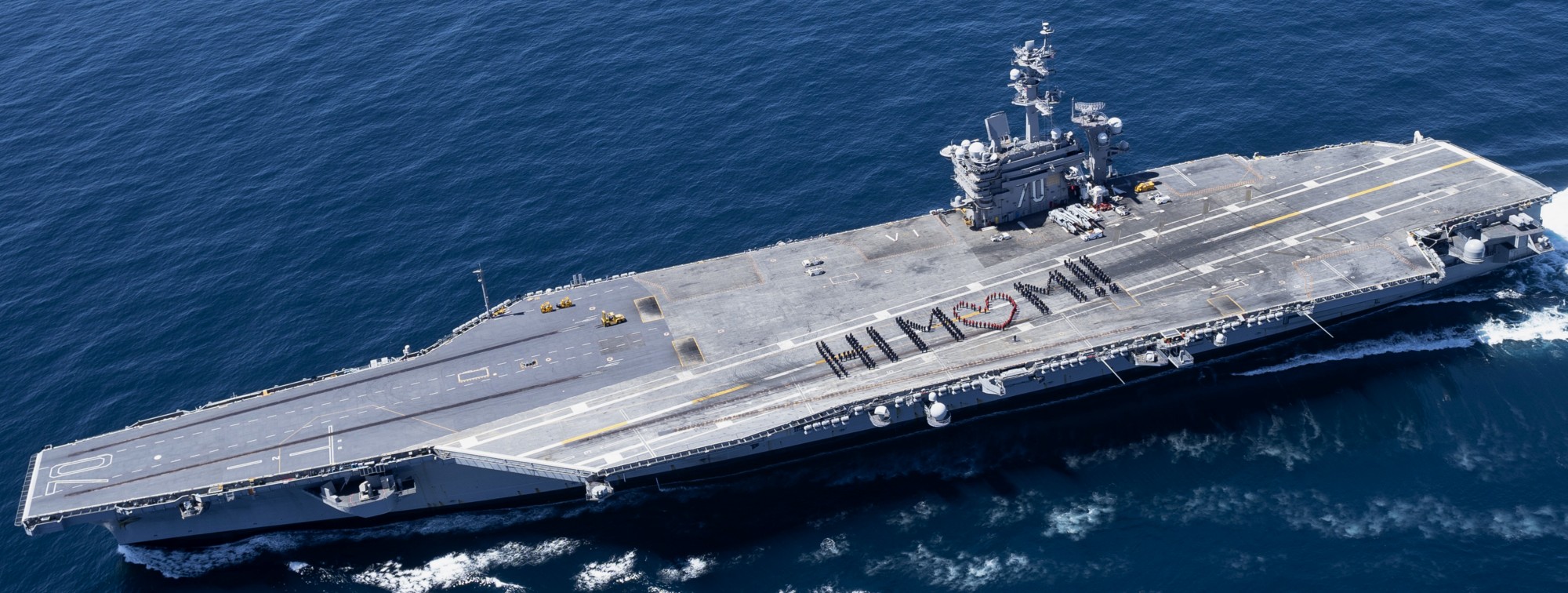 mother's day greeting - Pacific Ocean - April 2021 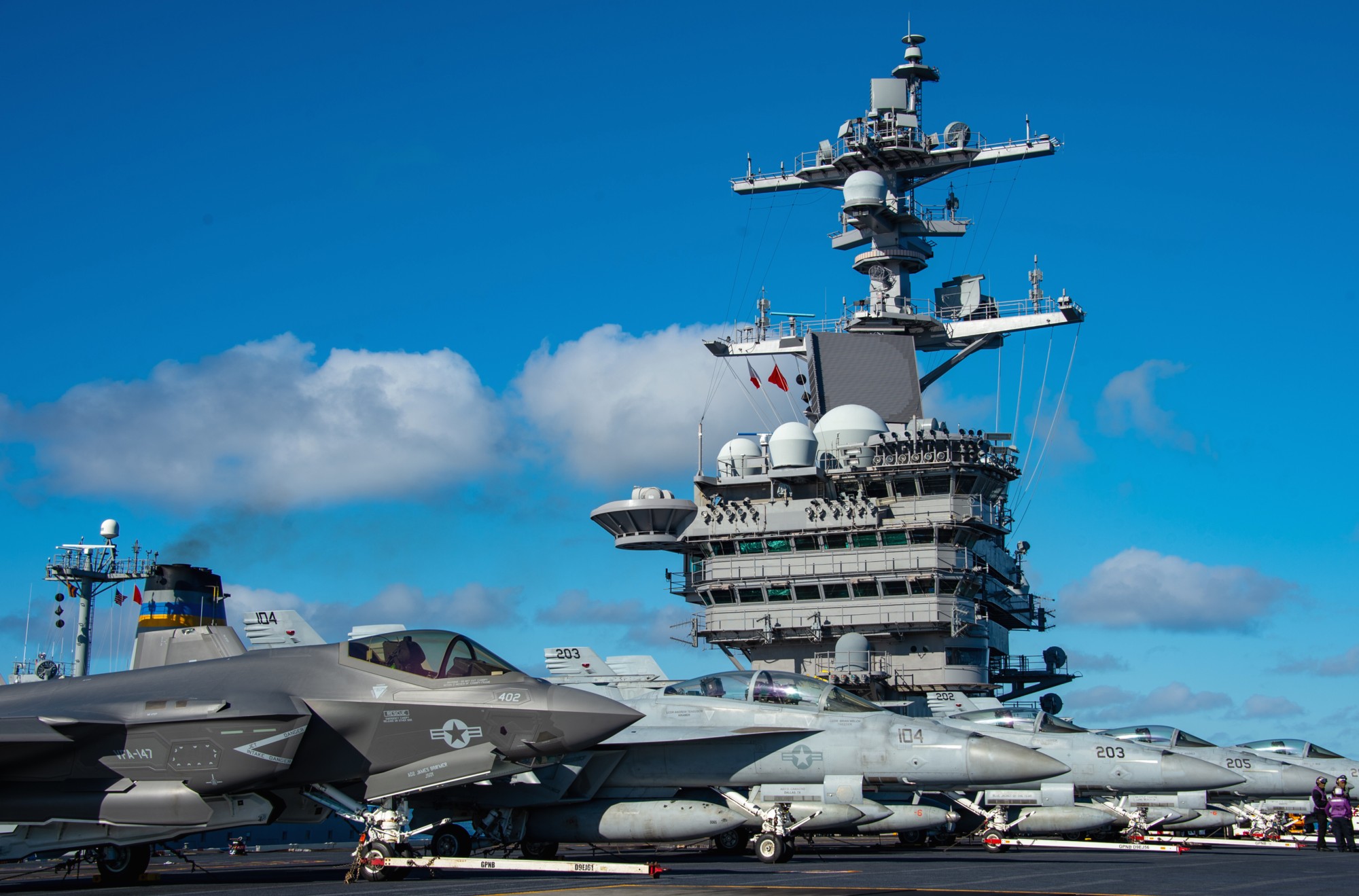 with CVW-2 embarked - Pacific Ocean - January 2021 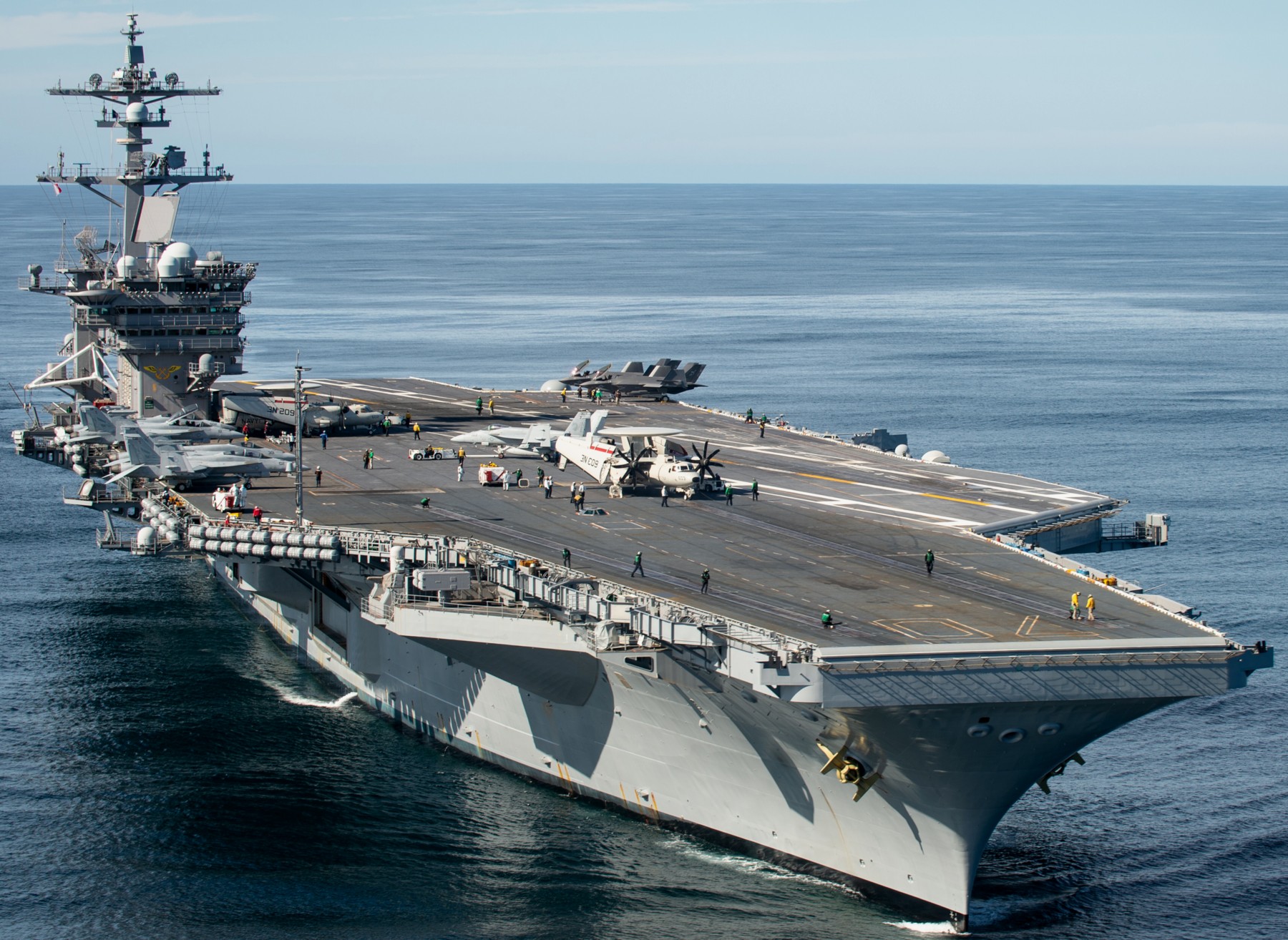 with CVW-2 embarked - Pacific Ocean - January 2021 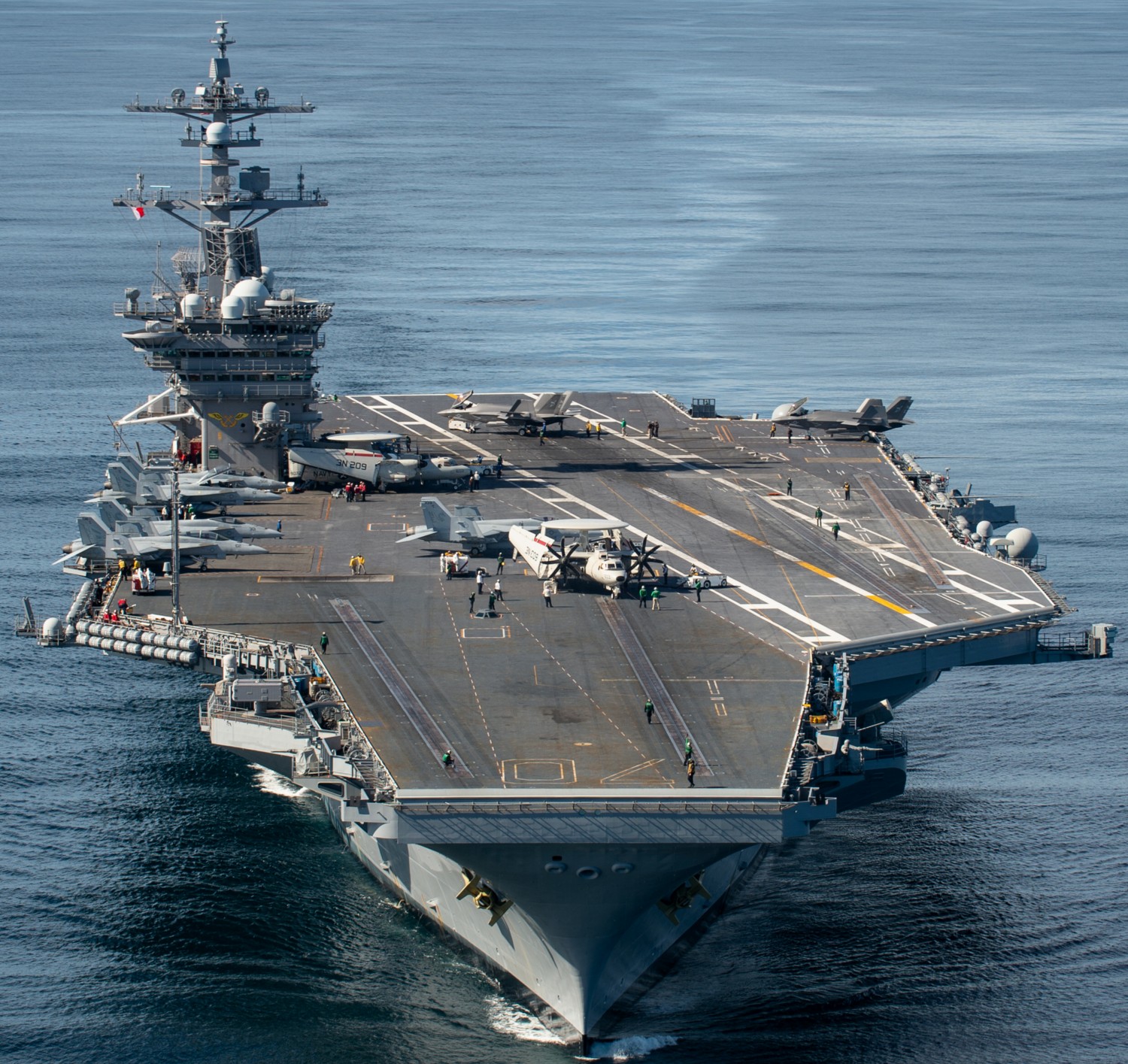 with CVW-2 embarked - Pacific Ocean - January 2021 > continue - CVN 70 image page 2 < > continue - CVN 70 image page 3 < |
||
|
Carl Vinson (November 18, 1883 - June 1, 1981): Carl Vinson - born in Baldwin County, Georgia, on 18 November 1893, son of Edward S. and Anne M. Vinson - attended Georgia Military College in Milledgeville and graduated from Mercer University Law School with an LL.B. degree in 1902, beginning practice on 5 June of that year. Vinson's appointment as Baldwin County Prosecutor in 1904 started a career of more than 60 consecutive years of service in public office. Elected to the Georgia General Assembly in 1909, he remained there until 1912, serving as Speaker Pro Tempore during his second term. He returned to his home county as County Court Judge from 3 October 1912 through 2 November 1914. Elected as a Democrat the next day to the House of Representatives (63rd Congress) to fill an unexpired term caused by the resignation of Thomas W. Hardwick. Vinson became a popular candidate who normally ran against only token opposition, and the people of Georgia returned him to that office for a hitherto unprecedented 26 successive terms. He also became the dean of Georgia's congressional delegation. During his first speech on national defense, Vinson stated his conviction that the Republic's needs must be determined without partisan political pressure, and predicted the growth's of the world's fleets. Soon thereafter, his strong belief in the efficacy of sea power in national defense earned him a seat on the House Naval Affairs Committee, from which he would guide America toward a powerful presence upon the seas. His subsequent chairmanship of the committee beginning in 1931 (72nd Congress) gained him the nickname of "The Admiral." Vinson supported a series of naval construction bills to bring American sea power up to the standards of the Washington Naval Limitation Treaty of 1922, and the London Naval Limitation Treaty of 1930. Working with Senator Park Trammell (D., Fla.) he introduced a bill in 1934 to bring U.S. naval strength up to the limits authorized by these treaties within eight years. The resulting legislation reversed a decade and a half of naval neglect and retrenchment and bore the handiwork of the two men to such a degree that it became known as the Vinson-Trammell Act. Despite the rise of fascism in Europe and the Far East, and the expansion of the German, Italian, and Japanese fleets during the years preceding WWII, Congress remained divided concerning naval growth, largely due to economic restraints imposed by the Great Depression and lingering disillusionment among Americans concerning the country's involvement in WWI. Undaunted, Vinson continued to strive for naval reform and readiness, presenting additional bills and opening hearings intended to place the U.S. fleet on a par with those of the totalitarian powers. In 1938 and 1940, he introduced bills to raise the fleet to treaty limits, the latter known as the Vinson Naval Expansion Act. All three of his principal legislative efforts included a strong emphasis on Naval Aviation, and congressional representatives referred to them colloquially as "The (1st - 3rd) Vinson Bills." Vinson's determination largely ensured that the United States entered the war with a fleet capable of absorbing the initial Axis blows until the Navy could be increased to defeat the enemy. The Naval Affairs and Military Affairs Committees joined as the Armed Services Committee in 1947, and Vinson served as the committee's chairman for the remainder of his legislative career, except for four years of a Republican-controlled Congress. Vinson retired from Congress at age 80 in January 1965, and returned to Milledgeville. "America is strong," he reflected during the warships' keel laying on 11 October 1975 at Newport News, Virginia, "but she is in danger of becoming weak. This great aircraft carrier will add strength. But it must not stop here. Only with determination on the part of our people to remain militarily strong, will we survive." Vinson died in Milledgeville on 1 June 1981 and was interred in Memory Hill Cemetery.
|
||
|
Chronology and Significant
Events: 24-27 Jan 1982: Two Soviet Tupolev Tu-95D Bear reconnaissance planes, flying out of Cuba, circled Carl Vinson (CVN-70) as she completed sea trials within 42 miles of Cape Charles, Virginia, on 26 January. An Airborne Warning and Control System (AWACS) aircraft and a Grumman E-2C Hawkeye from Naval Air Station (NAS) Norfolk directed a pair of McDonnell Douglas F-4S Phantom IIs from Fighter Squadron (VF)-74 from NAS Oceana, Va., and two USAF McDonnell Douglas F-15C Eagles from Langley Air Force Base, Va., to keep an eye on the Bears. The Eagles intercepted the Russians about 190 miles from the carrier and escorted them away, handing the Soviets off to the Phantom IIs, who shepherded the Bears back to Cuban waters. Analysts perceived the move as unusually provocative during a period of heightened tension between the two powers resulting from the Cold War arms build up in Europe. The event caused great controversy in the media, as well as led to heated exchanges between American and Russian diplomats. ADM Hyman G. Rickover, however, on board to observe her progress, directed attention to the new ship's capabilities in an era of international strife, pointing out that the ship's nuclear propulsion made her "independent of the propulsion fuel oil umbilical cord." 26 Feb 1982: The shipyard delivered Carl Vinson to the Navy. 13 Mar 1982: ADM Thomas B. Hayward, Chief of Naval Operations; Secretary of the Navy John F. Lehman, Jr.; VADM Lando W. Zech, Jr., Chief of Naval Personnel; VADM Thomas J. Kilcline, Commander Naval Air Force Atlantic Fleet; Senators Samuel A. Nunn (D., Georgia), grandnephew of the ship's namesake, and John G. Tower (R., Texas) - the principal speaker - CAPT Richard L. Martin, her first commanding officer (CO); CAPT Gary L. Beck, her first executive officer and the ship's sponsor, Molly Snead, were among more than 7,000 people in attendance during the ship's commissioning while she lay moored starboard side alongside Pier 2, at her building yard. "We're ready to go," proclaimed CAPT Martin, "where we are tasked to go." 15 Mar 1982: Carl Vinson logged her first underway time while hosting a dependent's cruise as she shifted berths from Newport News to Pier 12, Naval Station, Norfolk, Va. 18 Mar-2 Apr 1982: Carl Vinson completed her initial operational sea period, off the Virginia coast. LCDRs Kenneth K. Grubbs and Thomas Russell of the Strike Aircraft Test Directorate accomplished McDonnell Douglas F/A-18A Hornet sea trials on board (22 March-2 April). Grubbs and Russell made 63 catapult launches and arrested landings, numerous touch-and-go landings, and intentional "bolters" (deliberately missing the ship's arresting cables). These were the second Hornet sea trials since the original at-sea tests on board aircraft carrier America (CV-66) from 30 October to 2 November 1979. In addition, CDR Stephen C. Wood, the commanding officer of Air Anti-Submarine Squadron (VS)-32, logged the ship’s first arrested landing, in a Lockheed S-3A Viking. 15 Apr-11 Jun 1982: Carl Vinson completed shakedown, carrier qualifications and refresher training in the Caribbean, principally off Guantánamo Bay, Cuba. The carrier made her first underway refueling, with frigate Moinester (FF-1097) on 16 April, and her initial underway weapons onload, with fast combat support ship Seattle (AOE-3), two days later. Although she visited St. Thomas, Virgin Islands (17 to 20 May) and Barbados (23 to 25 May), the Navy cancelled a visit to Rio de Janeiro, Brazil, due to tensions in the region arising from the Falklands [Malvinas] War between Great Britain and Argentina, shortening Carl Vinson’s cruise by almost two weeks. 23 Jul-10 Dec 1982: Carl Vinson conducted a post shakedown availability at her building yard. The ship offloaded her weapons at "Whisky" anchorage on the Elizabeth River on 23 July and proceeded to the deperming [reducing her permanent magnetism to protect against magnetic mines and torpedoes] crib at nearby Craney Island the next day. Reaching Newport News on 2 August, Carl Vinson entered Shipway No. 11 (drydock) on 11 September. Workers installed two 3,500 gallon Aqueous Film Forming Foam storage tanks in the hangar bay overhead, significantly increasing fire fighting capabilities. While in the shipyard, she served as flagship for the commander of Orange forces during ReadiEx-82. In addition, ADM James D. Watkins, Chief of Naval Operations, announced that her home port would shift from Norfolk to NAS Alameda, California, effective 1 March 1983. Under Secretary of the Navy James F. Goodrich previously announced that Carl Vinson would relieve aircraft carrier Coral Sea (CV-43), which would switch home ports with the former. Secretary of the Navy Lehman, however, overturned the decision, with speculation centering on concerns over balancing carrier strength between the Atlantic and Pacific Fleets. The move also became controversial by affecting sailors scheduled to cross-deck between the two ships. Carl Vinson undocked on 20 November, and RADM Kendall E. Moranville, Commander Carrier Group 4, broke his flag in her on 2 December. 11-15 Dec 1982: The ship completed post availability sea trials, including additional Hornet operations, off the Virginia capes, before returning for the holidays. 4 Jan-4 Feb 1983: Carl Vinson accomplished refresher training, carrier qualifications and an Operational Readiness Exam (ORE) in Puerto Rican waters. The ship anchored at Roosevelt Roads, Puerto Rico, on 30 January, which afforded divers the opportunity to photograph the No. 2 screw and discover several cracks on the edges of the blades. The carrier got underway the next morning and returned to Pier 12 at Norfolk on 4 February, unloading ammunition that day. Carl Vinson had her No. 2 screw replaced while she lay in drydock at Newport News (6-16 February). She then reloaded fuel and ammunition at Whisky anchorage (17-18 February). 1 Mar 1983: Carl Vinson began her maiden deployment, that included a global circumnavigation and a change of home ports from Norfolk to Alameda. RADM Moranville and CDR Thomas S. Slater, Commander [CAG] Carrier Air Wing (CVW)-15: Attack Squadron (VA)-52 (Grumman A-6E Intruders and KA-6Ds), VA-37 and VA-105 (Corsair IIs), VF-51 and VF-111 (Grumman F-14A Tomcats), Carrier Airborne Early Warning Squadron (VAW)-114 (Hawkeyes), Tactical Electronic Warfare Squadron (VAQ)-134 (Grumman EA-6B Prowlers), VS-29 (Vikings) and Helicopter Antisubmarine Squadron (HS)-4 (Sikorsky SH-3H Sea Kings), embarked. 5 Mar 1983: A Soviet Bear reconnoitered the ship while she operated off Puerto Rico, although her fighters did not intercept the Russians. 11 Mar 1983: A Tupolev Tu-142F Bear attempted to inspect Carl Vinson. Her Tomcats intercepted the bomber at 595 nautical miles and escorted the Bear for 17 minutes until the Soviet aircraft exited the area. 15-16 Mar 1983: The ship participated in a "war at sea" scenario with aircraft carriers Dwight D. Eisenhower (CVN-69) and John F. Kennedy (CV-67), conducting flight operations in association with the "hostilities" phase of ReadiEx 1-83. 17 Mar 1983: Taking on stores and ammunition, Carl Vinson headed for the Mediterranean, accompanied by guided missile cruiser Texas (CGN-39) and frigate Brumby (FF-1044). 19 Mar 1983: Carl Vinson's Tomcats intercepted a Bear 200 miles out, but the Russian proved so aggressive that the Americans continued escorting them for two and a half hours. 26 Mar 1983: Carl Vinson passed eastward through the Strait of Gibraltar and immediately began AdEx 1-83, an air operations exercise with the Royal Moroccan Air Force. Moroccan Northrop F-5 Tigers and Dassault Breguet F.1 Mirages flew simulated strikes against Carl Vinson; U.S. aircraft retaliated by attacking Moroccan airfields. The fleet air defense phase of the exercise occurred in an area of restricted maneuverability barely 20 miles from shore, forcing the Tomcats to intercept their Moroccan adversaries at low altitudes in multiple engagements, testing both sides' flying skills. 4-27 Apr 1983: Carl Vinson participated in exercise National Week in the western Mediterranean, operating as Orange flagship against Blue forces led by aircraft carrier Nimitz (CVN-69). Tomcats of VF-51 flew low level dissimilar air combat maneuvering against McDonnell Douglas F-4Ns from CVWR-20 and long range (800 nautical miles) strikes against Nimitz. In addition, HS-4 successfully recovered a man overboard during this period. Aircraft No. 103, however, an F-14 (BuNo 160662) from VF-51 crashed during the first watch on 9 April, near 38º11'N, 005º52'E, as Carl Vinson steamed from Monte Carlo, Monaco, to Casablanca, Morocco. Although a calm night, the water temperature nonetheless dropped to a chilling 55º F., adding the threat of hypothermia to the sense of urgency among the search and rescue teams. Although Helo Nos 614 and 615 of HS-4, together with lookouts, spotted debris, and the ship launched her starboard motor whale boat, searchers failed to locate either man. During an aerial firepower demonstration for Moroccan visitors (12 April), Intruders from VA-52 dropped 22 MK 82 bombs in a practice run alongside the ship, forming, in the eyes of one squadron observer, a "wall-of-water." The ship then visited Abidjan, Ivory Coast (23-25 April). 28 Apr 1983: Carl Vinson crossed the equator at the Prime Meridian, at 0542. 3-5 May 1983: Carl Vinson rounded the Cape of Good Hope and entered the Indian Ocean. The crew described the weather as “rough,” though not nearly as difficult as they expected for that time of year at the Cape, an area known for heavy seas, especially during the winter season in the Southern Hemisphere. 9-13 May 1983: Australian guided missile frigate HMAS Canberra (F-02) operated with Carl Vinson as the carrier proceeded toward Diego Garcia in the British Indian Ocean Territory. The Australian ship, the Americans noted, “proved a worthy adversary.” 17-18 May 1983: Tomcats of VF-51, the pilots surprised by the "excellent weather," flew in Glad Customer 83-4H, an electronic warfare exercise vs. USAF Boeing B-52H Stratofortresses near Diego Garcia. The ship launched a mixed force of one Hawkeye, a Douglas EA-3B Skywarrior, two Vikings and two sections of Tomcats with KA-6D tanker support, to intercept the B-52s at 400 nautical miles. 19 May-7 Jun 1983: Carl Vinson operated in the North Arabian Sea. Her aircrews had planned to fly an average of six days on and two off, maintaining a daily maximum of 85 sorties, 11 to 12 of which would be fighter. Inquisitive Soviet Ilyushin Il-38 Mays, however, consistently disrupted schedules, while the extreme temperatures and dust created safety and habitability problems. Sea Kings from HS-4 honed their submarine hunting skills against attack submarine Boston (SSN-701). Carl Vinson also participated in Operation Beacon Flash 83-6 with the Omanis (29-31 May). Omani SEPECAT Jaguars and Hawker Hunters attacked the ship, tangling with her Tomcats, and the Americans flew strikes against targets at Thumrait, Oman, defended by Jaguars and Rapier Short Range Air Defense missiles. “With several Beacon Flashes behind them,” noted an observer in VF-51, “the Omanis were hard to surprise.” 8-18 Jun 1983: While en route to Diego Garcia, Carl Vinson participated in a war at sea exercise with Coral Sea. The latter also completed a world cruise as she shifted home ports from Alameda, California, to Norfolk (21 March-12 September 1983). The two carriers launched long range (1,000 nautical miles) strikes against each other, and in MultiPlEx 83-3, a combined arms exercise, Carl Vinson operated with guided missile cruiser Worden (CG-18) and attack submarine Phoenix (SSN-702). RADM Moranville embarked in Coral Sea on 9 June, cross-decking with RADM Paul F. McCarthy, Jr., Commander Carrier Group 1, who embarked in Carl Vinson. Upon reaching 45 days at sea (18 June), the crew enjoyed a “Steel Beach picnic,” including beer and a boxing match. 19-30 Jun 1983: After clearing the Diego Garcia area, Carl Vinson again exercised with Phoenix while steaming toward Western Australia. Poor weather forced her to cancel most aerial phases of Operation Beacon South 83-2. Rain-slicked and pitching decks made flight operations challenging, and “just taxiing," recalled an observer in VA-52, "became an exciting, terrifying experience.” 1-7 Jul 1983: Carl Vinson visited Perth. After 64 continual days at sea, one crewmember described the visit as “a joyous reunion with an old friend.” 19-20 Jul 1983: Tomcats from VF-51 participated in Operation Vector South vs. USAF McDonnell Douglas F-15 Eagles of the 13th Air Force’s 18th Tactical Fighter Wing operating in the maritime role. “Fighters dropped the tanks,” reflected an observer in VF-51, “and fought clean for the first time in the deployment.” 22-24 Jul 1983: RADM McCarthy disembarked and RADM Thomas F. Brown, III, Commander Carrier Group 5, embarked. Two days later the ship again crossed the equator. 26 Jul 1983: Aircraft No. 307, an A-7E, LT(JG) Murray J. Charles of VA-37 at the controls, missed the wires and hit the ramp during a night landing. It was a calm night, though light cross winds posed landing problems. LT(JG) Charles ejected as his Corsair II went over the angled deck into the water, at about 006º21’6”N, 067º42’6”E. Helicopter No. 612, supported by a helo from frigate Cook (FF-1083), picked up the pilot 16 minutes later. LT(JG) Charles survived but suffered back pains and difficulty breathing, and required intensive care. 13-22 Aug 1983: Carl Vinson served as flagship for Battle Group Charlie during Operation Bright Star 83-4/Eastern Wind with USMC and the Somali units in the Gulf of Aden. Carl Vinson maintained an around-the-clock alert vs. Soviet and Yemeni Mikoyan Gurevich aircraft [MiGs] and patrol boats capable of launching anti-ship missiles. Bright Star enabled Carl Vinson's aircraft to fly against Marine Attack Squadron (VMA)-231 Detachment B McDonnell Douglas AV-8A Harriers operating from amphibious assault ship Tarawa (LHA-1), as she steamed off Berbera, Somalia. Seasonal haze restricted visibility, however, and the crew experienced what they referred to as “Indian Ocean ennui,” noting that “Any kind of change was welcome.” 25 Aug 1983: The crew celebrated their second beer day of the deployment. 17 Sep 1983: During the evening Carl Vinson rescued Vietnamese refugees ["boat people"] escaping communist persecution and the upheaval that still lingered following the fall of the Saigon regime in 1975. 20 Sep 1983: CDR Slater - the wing’s commander - recorded his 200th landing on board Carl Vinson, becoming the ship’s first double centurion, his 1,403 arrestment and 601st in a Tomcat. 28-30 Sep 1983: Carl Vinson took part in AnnualEx 83-58G in the Sea of Japan, where her Tomcats battled USAF F-15s and McDonnell Douglas A-4M Skyhawks. Super Typhoon Forrest slammed into the task force, however, forcing Carl Vinson to cancel remaining events of the exercise and change courses to evade the high seas. 5-12 Oct 1983: Carl Vinson arrived off Pusan in South Korea for a routine visit. On the 9th, however, assassins detonated a bomb among a South Korean delegation led by President Chun D. Hwan, as the South Koreans prepared to visit the Martyr’s Mausoleum at Rangoon in Burma. The explosion killed 21 people and injured 48 more, though the blast failed to kill President Hwan, who arrived late. The bombing caused widespread repercussions due to rumors crediting the assassins with being North Korean agents, which necessitated that Battle Group Charlie, with Carl Vinson as flagship, remain in Korean waters for "contingency operations" due to a possible war between North and South Korea. The crew received word that the Navy might extend the ship’s deployment, but diplomatic efforts defused the crisis, enabling the carrier to complete her cruise. 29 Oct 1983: Carl Vinson sailed beneath San Francisco's Golden Gate Bridge for the first time and during the afternoon moored to Pier 3 at her new home port of Alameda, completing a world cruise. The ship accomplished more than 11,500 aircraft launches and recoveries and sailed upward of 40,000 miles during her maiden deployment. Tomcats intercepted Russian Bears, Mays and Antonov An-12 Cubs 28 times. 14-19 Feb 1984: Carl Vinson certified for F-14A Mode I approaches while operating in Californian waters. 2-10 Mar 1984: Mayor Dianne Feinstein (D.) of San Francisco, California, declared Carl Vinson to be “San Francisco’s Own,” authorizing a 33-member USS Carl Vinson Committee to solidify relations with the ship (2 March). Famed NFL quarterback Joseph C. “Joe” Montana, Jr., of the San Francisco 49ers, visited the ship for the filming of an NFL Most Valuable Player Award ceremony (5 March)., and a television crew from KPIX-TV 5 Evening Magazine also shot a feature story about the ship (9-10 March). 29 Mar 1984: Secretary of the Navy Lehman and VADM Crawford A. Easterling, Commander Naval Air Force Pacific Fleet, toured the ship. 4 Apr 1984: Carl Vinson conducted a dry replenishment with Canadian replenishment oiler HMCS Provider (AOR-508). 29 Apr-3 May 1984: A five-man team from Fleet Audio Visual Command embarked to film Hornet flight operations. 12 May 1984: Actor Lee Horsley, portraying "Matt Houston" on the television show of that name, toured the ship. 14-23 May 1984: Carl Vinson participated in (separate) weapons and composite training exercises off southern California, emphasizing the operational employment of all ship and air wing systems. 31 May-18 Jun 1984: Carl Vinson took part in RimPac [Rim of the Pacific] Maritime-84, a series of multi-scenario exercises stretching from southern California to the mid-Pacific. 31 Jul-22 Aug 1984: The ship participated in ReadiEx 84-4 and an ORE off the coast of California. 13 Oct 1984: Carl Vinson deployed to the Western Pacific and Indian Oceans. Aircraft No. 425 (BuNo 152789), a Grumman C-2A Greyhound from Fleet Logistics Support Squadron (VRC)-50, and an EA-3B of Fleet Air Reconnaissance Squadron (VQ)-1 Detachment Charlie also later embarked with CVW-15. Logistics sailors leapfrogged ahead of the ship to Pearl Harbor, Hawaii, then Guam and the Philippines. Utilizing the latter as a base of operations, they also sent detachments to various Japanese facilities and to Diego Garcia. 18 Oct-6 Nov 1984: During Operation FleetEx 85 Phase I in the Eastern Pacific (18-30 October), Carl Vinson conducted dual carrier battle group operations with aircraft carrier Constellation (CV-64). In addition, her aircraft participated in four Busy Observer exercises with USAF B-52Hs. The Russians monitored the ship from the outset and Tomcats from VF-51 and VF-111 intercepted a pair of Bear D’s 229 nautical miles out on the very first day. Apparently, aggressive flying prevented the Russians – who closed to 95 nautical miles before changing course – from locating the carrier. F-14s intercepted a second pair of Bears two days later, at 86 nautical miles. Carl Vinson then provided close air support for marines practicing amphibious landings at Barking Sands, Hawaii, in Bell Volcano 85-1 (31 October-1 November) before putting into Pearl Harbor, prior to continuing on into the Western Pacific. 10-21 Nov 1984: Carl Vinson originally planned to operate with aircraft carrier Midway (CV-41) during FleetEx 85 Phase II, however, Typhoons Bill and Clara forced her to cancel her participation on both occasions. The ship positioned herself northeast of the storm centers on the 30 knot wind radius. 22 Nov-12 Dec 1984: Carl Vinson’s Battle Group Charlie operated with two other battle groups during FleetEx 85 Phase III: Alpha, led by Midway, and Foxtrot, led by aircraft carrier Enterprise (CVN-65). Orange opposition comprised USN, USMC and USAF commands, including Lockheed KC-135 Hercules and Boeing E-3A Sentry AWACs, and seven Japanese and U.S. attack submarines, including Drum (SSN-677), Pogy (SSN-647) and Tautog (SSN-639). The three groups joined east of the Philippines and transited north past Okinawa toward northern Japan. Additional Soviet surveillance flights searched futilely for the ship and due to a combination of evasive measures by the ship and foul weather that hindered flying–a very strong westerly wind apparently forced the sixth Bear to disengage and refuel did not spot her until their sixth mission on the 30th, by which point she bypassed the Okinawa area. Planes from all three carriers tangled in a mock battle with Air Force opposite numbers off Okinawa, however, that service’s regulations then stated that interceptors should be unarmed when intercepting USAF tactical aircraft. At one point the Americans unexpectedly detected Soviet Bears inbound, with 25 Tomcats from Carl Vinson and Enterprise, together with Phantom IIs from Midway airborne but unarmed. Men frantically raced to recover F-14As on both of the former carriers, rearm and scramble them aloft. Altogether, the Russians made seven aerial attempts to shadow Carl Vinson during her transit. Upon completing the exercise, Enterprise was detached to return to the Third Fleet while Carl Vinson and Midway passed through the Tsugaru Strait into the Sea of Japan, with an AWACs shepherding them. “The three days that followed” noted CAPT Thomas A. Mercer, “were the most exciting periods of the deployment.” Russian aircraft, including Bears, Beriev Be-12 Mails and Ilyushin Il-38s, in addition to ships and submarines conducted continuous surveillance, forcing the two carriers to stagger their flight schedules to maintain 24-hour air coverage, a grueling pace. USMC Phantom IIs flying from Japan helped by intercepting some of these Soviet bombers. A few Soviet aircraft proved noticeably audacious, and as the ships attempted to watch some shadowing Mays on the morning of 2 December, a pair of Badgers closed the carriers to within 150 nautical miles. Shortly afterward, two Bear Ds orbited the buffer zone approximately 180 to 220 nautical miles to the northwest. The range of Russian anti-ship missiles carried by these bombers made these incidents dangerous episodes for Carl Vinson and Midway, and in this instance Carl Vinson launched her alert combat air patrol (CAP) and a Hawkeye to supplement Midway’s aircrew to counter a large raid forming to the north and northwest. ADM Sylvester R. Foley, Jr., Commander-in-Chief Pacific Fleet, watched the confrontation unfold from Carl Vinson’s Combat Direction Center. The crew manned their Battle Stations as radar operators tracked multiple regimental-sized raids comprising three Tupolev Tu-22M Backfires, two Bear Ds, nine Tupolev Tu-16 Badgers and six Mays approaching from three different directions, backed up by numerous fighters that flew barrier CAPs. Tomcats from both carriers intercepted the Russian bombers during tense encounters, reducing a rapidly escalating situation. Undaunted, the Soviets returned the next day as two MiG-23 Floggers and two Sukhoi (Su)-15F Flagons joined two Bear Ds, two Badgers, two Mays and two Mails in another series of sweeps against the ships, requiring Tomcats to escort the Flagons for over two hours. A Hawkeye of VAW-114 directed a Tomcat to intercept the Floggers. The Americans maneuvered to within ¾ of a mile on the trail Flogger’s “six o’clock position” and observed the Russians to be armed with two R-23 (AA-7) Apex and four R-60 (AA-8) Aphid air-to-air missiles, increasing tension between the two nation’s aviators. The Hawkeye detected an additional Flagon outbound and vectored a pair of F-14s to intercept it. Surface surveillance included a Kashin-class guided missile destroyer, which a Kara-class guided missile cruiser joined a short while later, after the cruiser emergency sortied from Vladivostok without running lights to avoid detection. Carl Vinson launched an Intruder that discovered the Kara and the Russians responded by simultaneously radiating their air search, missile and gun fire control radars. Destroyer John Young (DD-973) and frigate Knox (FF-1052) were detached to monitor the Soviets. Meanwhile, an Intruder located a larger Russian battle group, consisting of aircraft carrier Novorossiysk (CVHG-137, Project 1143), another Kara, a Kresta-class guided missile cruiser, two Krivak-class guided missile frigates and a Primorye-class intelligence collector, on a southeasterly course from Vladivostok. The Soviets closed to within 60 nautical miles and Novorossiysk utilized over-the-horizon-targeting to threaten the Americans. The Intruder watched them until a Tomcat from VF-111 arrived and photographed the snoopers via the Tactical Air Reconnaissance System [TARPS]. The bitter northern weather, with temperatures dropping to 15º F. and winds increasing to 50 knots, forced men above deck to wear foul weather gear and for ships to rotate watchstanders more rapidly than normal procedures. Crewmembers found their “extreme foul” weather face masks to be especially useful, though heavy mittens proved too cumbersome for flight deck use. Keeping their feet warm proved the most challenging weather-related problem for the crew. The ship set up a soup kitchen on the 03 level to provide hot chocolate, coffee, soup and doughnuts to watchstanders numbed by the cold. After crossing the Sea of Japan the carriers separated, so the Novorossiysk group set course for Russian waters, although the Kara-class cruiser continued to trail Carl Vinson for some time. Midway proceeded toward Pusan, South Korea, while Carl Vinson put in to Yokosuka, Japan, for a brief visit (10-12 December). 12-24 Dec 1984: Carl Vinson steamed in the South China Sea, arriving at NAS Cubi Point in the Philippines in time for Christmas Eve. Since the Navy assigned 89 aircraft to the ship at the beginning of her deployment, she rotated a detachment of two Tomcats and a pair of Corsair IIs ashore at Cubi and at Clark AFB. 31 Dec 1984: Carl Vinson completed 14,461 arrested landings during 1984, raising her total to date to 33,319. 6-7 Jan 1985: Two Bear Ds flying from the former U.S. base at Cam Rahn Bay in Vietnam shadowed the ship (6 January) as she made her way southward across the South China Sea toward Singapore, followed by two Bear Ds, a pair of Bear Es/Fs and three Badgers the next day. One of the Tu-16s conducted bombing runs in the vicinity of Catwick Shoals. 9-10 Jan 1985: Carl Vinson passed through the Strait of Malacca and entered the Indian Ocean. En route, she overtook a Russian Foxtrot-class submarine transiting the strait. The ship launched a Sea King to track the sub, however, as the helo dropped sonobuoys to acquire the Soviets the crew of a nearby Krivak-class frigate provocatively shot the buoys with small arms fire. 18-19 Jan 1985: Carl Vinson relieved aircraft carrier Independence (CV-62) in the Indian Ocean. 19 Jan-12 Apr 1985: During the following weeks Carl Vinson operated mostly southwest of 20ºN, 60ºE, to the east of al Masirah Island, Oman. Although convenient for airhead supply, this operating area lay within 200 nautical miles of Iranian Lockheed P-3F Orion patrol routes, as well as the normal An-12 Cub lanes and several commercial airways. Iranian F-4Ds/Es also covered some of their Orions. These potential threats kept the crew busy and F-14s made a total of 28 intercepts of Soviet Cubs, Mays, Ilyushin Il-62 Classics and Il-76 Candids, along with Iranian Orions and Lockheed C-130 Hercules, altogether 98 Russian and 16 Iranian aircraft. In all but one of the 14 instances concerning Mays an EA-3B detected the incoming aircraft at ranges in excess of 500 nautical miles. The wing also practiced contingency night strikes averaging 40 aircraft. Tomcats flew TARPS missions over the anchorage at Socotra Island, spotting two Charlie II, one Foxtrot and one Victor-class Soviet submarines. At different times, Carl Vinson aircraft also discovered and tracked two Soviet Charlie Is and one Foxtrot underway in the vicinity of Socotra. HS-4 and VS-29 combined their hunts for the Charlie Is in a “Wolftrap” over 11 to 17 February for the first one, and from 3 to 5 March for the second boat. The crew armed an SH-3H with four M-60 machine guns to protect against terrorist attacks and for combat search and rescue missions, and the Sea King simulated terrorist attacks by small craft and suicide planes against the group, providing realistic training. A Russian Balzam-class intelligence collector (SSV-80) monitored activities and trailed the ship up to the Eight Degree Channel. Carl Vinson experienced two airborne accidents. The first involved a KA-6D tanker from VA-52 with an extended refueling drogue that emergency diverted ashore to Masirah, and the second, a Corsair II that dropped its hook and hit the catapult shuttle during launching, forcing the pilot to make a hair-raising 1,200 nautical mile flight to Diego Garcia, accompanied by a KA-6D. Crewmembers requiring advanced medical care would be transferred from other ships in the group to Carl Vinson, and from there through Naval Support Activity (NSA) Diego Garcia. The Air Force’s 9th Aeromedical Evacuation Squadron then flew them to Clark AB in the Philippines, an exhausting series of flights for patients. 23-28 Jan 1985: Carl Vinson operated with French forces (23-24 January) and with British (27-28 January). 29-31 Jan 1985: Carl Vinson participated in MultiPlEx 85-3, which included passive over-the-horizon targeting, anti-ship missile defense and surface gunnery exercises. 16-19 Feb 1985: Carl Vinson participated in Operations Beacon Flash 85-3 and 85-4 with the Omanis. Omani Jaguars and Hunters again attacked the ship, fighting Tomcats, and the Americans struck Masirah and Thumrait and the range at Rubkut, while Jaguars and Rapiers attempted to shoot them down. Although the Omanis fought nobly they could not stop eight mini-strikes of six to eight aircraft each from 0700 to 1400, that the ship launched during the final evolution that swamped their defenses and (perhaps understandably) offended them. “We recommend,” noted the carrier’s Cruise Report, “that Omani desires be satisfied and a good time will be had by all.” The Omanis nonetheless proved “very easy to work with” and also qualified their Jaguar pilots of No. 20 Squadron on the KA-6 tanker package. Carl Vinson aircraft dropped 230 MK-82 bombs, together with 28 MK-82 FIN bombs and five MK-83 laser-guided bomb (LGB) Is during the first exercise, and 300 MK-82 bombs, along with three MK-83 LGB Is and two MK-83 LGB IIs during the second. 25-27 Feb 1985: Carl Vinson conducted a passing exercise with the British and French. 15 Mar 1985: Carl Vinson participated in Glad Warrior, an anti-ship strike exercise whereby B-52s simulated Soviet bombers attacking the carrier. 23-26 Mar 1985: The ship took part in Beacon Flash 85-5. 28-30 Mar 1985: Carl Vinson anchored off Masirah. 7 Apr 1985: Aircrew rescued the crew of an F-14A after they ejected from their Tomcat following a dual hydraulic failure during a nighttime mission. 12 Apr 1985: Constellation relieved Carl Vinson, the latter then steaming toward Australian waters, narrowly avoiding tropical cyclone Margot as it swirled in a southerly direction from southwestern Sumatra. 26-29 Apr 1985: Following a visit to Fremantle (19-26 April), Carl Vinson operated with Australian forces during which aircrew practiced live bombing runs at Lancelin Target Area, operated by sailors from HMAS Sterling (the Royal Australian Navy normally names shore establishments after ships) at Perth. The crew noted that the friendly welcome which Australians extend “has only gotten better.” 30 Apr 1985: Carl Vinson departed the Indian Ocean and transited the Lomboc Strait northbound en route to Cubi Point. The ship also negotiated the Makassar Strait and crossed the Java, Celebes and Sulu Seas on her way to Philippine waters. 24 May 1985: Carl Vinson returned home, having logged interceptions of over 100 Soviet and Iranian aircraft. 9-10 Oct 1985: Anthony “Tony” Scott, the director of the motion picture Top Gun, embarked with an eight-man crew to obtain flight deck and aerial footage for the film. 12 Oct 1985: Carl Vinson took station in a procession of over a dozen ships to participate in Fleet Week 1985. Passing beneath the Golden Gate Bridge into San Francisco Bay, she fired a gun salute to ADM James A. Lyons, Jr., Commander-in-Chief Pacific Fleet. Later that evening Mayor Feinstein presented the City of San Francisco’s Silver Service Award to CAPT Mercer during the annual Navy Ball. 22-28 Mar 1986: Carl Vinson conducted training in southern Californian waters. Aircraft No. 110, an F-14A, LT Richard A. Samolovitch and CDR Charles F. Zullinger of VF-51, crashed while flying air combat maneuvering at 1037, at 31º40’N, 118º1’E, 44 miles from Carl Vinson (26 March). The Tomcat departed controlled flight and entered a flat spin. Fetch No. 614, a Sea King, recovered both men in “good shape” at 1116. May-Apr 1986: Carl Vinson participated in ReadiEx-86, a 24-day Third Fleet exercise including coordinated antisubmarine operations between the carrier and patrol squadrons flying out of NAS Moffett Field, California. VADM Moranville, Commander Third Fleet, held briefings on board (3-4 April). While launching from Catapult No. 3 an Intruder’s (VA-52) jet blast blew final checker AD2 Brian L. Preston of that squadron overboard portside, at 1435 on 6 April, at 27º29’9”N, 122º34’3”W, 245 nautical miles from Isla de Guadalupe. A taxiing Corsair II’s blast blew Preston behind the Intruder, that in turn thrust him over the side. Although O’Callahan (FF-1051) lowered a motor whaleboat that recovered the sailor, however, he died at 1645 on board the frigate. 12 Aug 1986: RADM Edward W. Clexton, Jr., Commander Carrier Group 3, CAPT James B. Perkins, III, Commander Destroyer Squadron 9 (to coordinate antisubmarine warfare for the group) and CAPT Ronald J. Zlatoper, CAG CVW-15, embarked in Carl Vinson as she deployed for the northern and western Pacific, the Indian Ocean and the North Arabian Sea. Guided missile cruisers Jouett (CG-29), Leahy (CG-16) and Vincennes (CG-49), guided missile destroyer Berkeley (DDG-15), destroyer Paul F. Foster (DD-964), guided missile frigate Gary (FFG-51), frigates Bradley (FF-1041), Brewton (FF-1086) and Marvin Shields (FF-1066), ammunition ship Flint (AE-32) and replenishment oiler Roanoke (AOR-7) also deployed. 18-22 Aug 1986: Carl Vinson steamed in the Bering Sea for the first time. CVW-15 observed that Soviet surveillance and harsh weather including high winds, low clouds and fog “tasked every aspect of carrier operations to the limit.” The ship’s Supply Department noted that the “environment required imagination to overcome both the elements and the scarcity of logistics support in the area.”Carl Vinson's aircraft flew low level missions over the Aleutian Islands. The ship just completed an underway replenishment during the afternoon watch (16 August) when a huge wave slammed into Elevator No. 1, positioned at the Hangar Bay level about 25 feet above the sea, and swept seven men overboard at 1243. The sailors were in the midst of moving aircraft up to the flight deck when they went over the side. Shipmates too far away to reach them watched helplessly as the men disappeared into the frothing maelstrom, though as soon as they recovered their own footing they threw smoke flares and life rings into the water. Six of the men overboard formed a compact group to assist their rescuers in the high seas; the sea pushed the seventh away from the others. Paul F. Foster could not directly recover the men in that weather and lowered her motor whaleboat. “We provided life rings to the men,” noted CDR Raymond P. Conrad, the destroyer’s commanding officer, “but the wind and seas prevented a shipboard recovery. I then decided to send the boat.” Despite the appalling conditions the craft’s crew saved the first six men and returned them to the destroyer within the hour. The survivors later returned to the carrier via helicopter. Helo No. 611, an SH-3H from HS-4, rescued the seventh man. The wave injured an eighth sailor when it smashed him against an aircraft, but thinking quickly, ABH3 Joseph Bartosz, working nearby, ran onto the elevator and clung to his injured shipmate with one hand and an aircraft tie-down fitting with the other and grimly rode out a second swell as it rolled across the elevator. Bartosz and his fellows then pulled the sailor out of harm’s way into the skin of the ship, where he successfully underwent surgery. 1-5 Sep 1986: After the ship crossed the Northern Pacific she put into Pusan, South Korea, where she accomplished her first import replenishment from a Mobile Logistics Support Force ship. Carl Vinson's aircraft made low level runs on targets at the South Korean range at Koon-ni (5 September). 7-8 Sep 1986: Carl Vinson's aircraft bombed the range at Tori-Shima, Japan. 18 Sep 1986: While under tow Aircraft No. 512, an Intruder, rolled over an ordnanceman’s leg during a flight deck re-spot, at 1405. The AO lost his leg due to the accident. 20 Sep 1986: Representatives of the Sultan of Brunei toured the ship, which performed a firepower demonstration. In addition, by this point in her deployment, VS-29 aircraft tracked two Soviet diesel submarines. 29 Sep 1986: Carl Vinson transited the Strait of Malacca and entered the Indian Ocean. 2 Oct 1986: Carl Vinson crossed the equator and Shellbacks initiated over 3,000 Polywogs. 5-11 Oct 1986: Carl Vinson visited Diego Garcia, and conducted an opposed port breakout exercise while standing out (10-11 October). 17-21 Oct 1986: The ship anchored at Masirah, holding a “steel beach” picnic for the crew (19 October). 25-28 Oct 1986: Carl Vinson took part in Beacon Flash. Aircrew flew low level bombing runs. 29 Oct 1986: The ship cooperated with battleship Missouri (BB-63) in an over-the-horizon targeting exercise, conducting strikes in excess of 1,000 nautical miles. 30 Oct-2 Nov 1986: Carl Vinson anchored at Masirah. 4-5 Nov 1986: The ship operated with the French Middle East Force. 7 Nov 1986: Carl Vinson anchored at Masirah. 17-23 Nov 1986: Accompanied by guided missile cruisers Leahy and Vincennes and replenishment oiler Roanoke, the carrier visited Mombasa. As Fish Eagle, a 600-passenger ferry utilized as a liberty boat, tied up alongside Carl Vinson at 2230 on the 17th, a stanchion gave way and snapped, hitting three men: AN Demetrius Embry, SN Kenneth Depew and SN Mark Womack. Depew suffered minor bruises and Womack a broken nose, and both men were released. Embry, however, endured a compound fracture to his jaw and fractured larynx which required him to be evacuated to an Army medical facility in West Germany for further treatment. 29 Nov-7 Dec 1986: Carl Vinson put into Diego Garcia. While there, ADM Lyons held briefings on board (1-3 December). Sir Humphrey E. Atkins, Chairman of the British House of Commons Defence Committee, visited the ship (1 December). Country-Western musician Loretta Lynn and her husband Oliver V. “Doo” led the 25 members of the Loretta Lynn DoD-USO Celebrity Show for a visit (6-7 December). After giving a concert on the evening of the 6th, they remained on board the next day as the ship stood out of her anchorage to observe flight operations. 7-16 Dec 1986: The ship participated in two exercises: Weapons Week 87-1 (7-10 December), and Busy Customer 87-1 (15-16 December). 17-19 Dec 1986: Carl Vinson's aircraft performed low level bombing runs against the ranges at Learmonth and Lancelin (17-18 December). Australian Defence Minister Kim C. Beazley visited the ship overnight (18-19 December). 29 Dec 1986: Aircraft No. 312, an A-7E Corsair II of VA-97, LT Kevin H. Graffis, experienced a malfunction as its flap handle stuck in the isolation mode, causing the brakes to fail. The A-6E skidded over the port side, at 1517 at 17º30’45”S, 108º32’E. Graffis ejected and a Sea King from HS-4 rescued him. 2 Jan 1987: Carl Vinson crossed the equator. 5-10 Jan 1987: The ship visited Singapore. 11-29 Jan 1987: Sailing from Singapore on 11 January, the ship crossed the Pacific and participated in Operations Kernal Potlach 87-1 (24-28 January) and Safe Haven (25 January) in the Bering Sea (23-28 January). En route Carl Vinson's aircraft practiced bombing at Scarborough Shoals in the Philippines (13 January) and at Tori-Shima (16 January). Despite frequent storms of ice and “blinding snow” which completely covered the flight deck, temperatures that averaged 20º to 36º F.–and dropped to as low as 10º–winds of up to 40 to 60 knots and seas which sent the ship through pitching excursions of 19 feet, the crew persevered and supported amphibious and air landings at Adak and Shemya in the Aleutian Islands. The Engineering Department rigged steam hoses and lances to clear the flight deck for handling aircraft, however, the ship noted that jet exhaust from Intruder’s proved the most effective way to clear snow and ice. Battle Group Charlie Northern Pacific Group received the Meritorious Unit Commendation for these grueling exercises. In addition to the weather they completed these operations in “the midst of heightened and continuous Soviet air reconnaissance,” notes the citation, “as severe a test of true combat readiness as any carrier battle group had ever encountered.” More than 10,000 sailors and marines and 14 ships participated in the exercises. 6 Mar 1987: Jerry Garcia and the Grateful Dead played to a crowd packing Hanger Bay 2. 23 Mar-24 Aug 1987: Carl Vinson got underway using tugs, emergency diesel generators and the auxiliary boiler and proceeded to general anchorage no. 9, south of Hunter’s Point Naval Shipyard in the San Francisco Bay area. She entered drydock the next day for a drydock selected restricted availability, during which workers removed and repaired all 4 screws and the no. 2 tailshaft. The ship refloated on 2 July, and undocked the following day to return to Pier 3 at Alameda under tow. The crew performed additional work through 24 August. 20 Sep 1987: While attempting to land during carrier qualifications in southern Californian waters, Aircraft 213, a Grumman F-14A Tomcat of VF-111, went over the port side after No. 4 Purchase Cable snapped, at 1947, at 31º26’8”N, 117º46’8”W. LTs John G. Speer and Michael D. Conn successfully ejected. 23 Sep 1987: GEN Robert T. Herres, USAF, Vice Chairman of the Joint Chiefs of Staff, visited the ship during the first dog watch to observe flight operations while she steamed off southern California. Shortly thereafter an Intruder from VA-52 crashed near Santa Catalina Island while flying ashore to NAS Whidbey Island, Wash., overnight. CDR Loyd D. Sledge, the pilot, died, though the bombardier/navigator survived. 9-10 Dec 1987: Stephen P. Coonts, a Naval Aviator, Vietnam veteran and author, visited the ship during preproduction of the film adaptation of his novel Flight of the Intruder. 15-16 Dec 1987: While steaming in southern Californian waters Carl Vinson encountered low visibility conditions during the morning watch on the 16th. Just as the ship secured from low visibility watch she received an urgent message from tank landing ship Cayuga (LST-1186)–steaming nearby–concerning motor vessel Explorador, which sank off Santa Barbara Island the previous day. Cayuga conducted a search and rescue for the six men believed on board the vessel, and Carl Vinson assumed on scene commander duties at 1120. She launched Aircraft Nos 614 and 615, two “Alert 15” Sea Kings from HS-4 Detachment A which spotted the survivors in the water at 1345 at 33º17’4”N, 119º11’1”W, and began rescuing James E. Alford, Jay J. Delaney, Jeffrey S. Felton, Edward E. Lopez, Bernie E. Sauls and Gary E. Trumper, all of whom were on board by 1624. 25 Jan-11 Feb 1988: Carl Vinson participated in ReadiEx 88-1 in Californian waters (through 7 February), plus additional time underway for carrier qualifications for CVW-15. 28 Mar-27 Apr 1988: Carl Vinson participated in a series of exercises, including Comprehensive Training Unit Exercise [CompTuEx] 88-2 (28 March-1 April); Battle-Ex 88-2 (4-7 April, in port at San Diego); ReadiEx 88-2 (8-20 April); Battle Force Exercise (21-24 April); and Mobile Sea Range (25-27 April). 15 Jun 1988: RADM David N. Rogers, Commander Carrier Group 3, CAPT James H. Finney, CAG CVW-15 and CAPT William J. Flanagan, Jr., Commander Destroyer Squadron 5 (CAPT Robert C. Williamson, III, relieved Flanagan the next day) embarked in Carl Vinson as she deployed to the northern and Western Pacific, Indian Ocean and Arabian Sea. 21-30 Jun 1988: The ship conducted interoperability evolutions with the Air Force (21-22 June) in Alaskan waters, including intercepting B-52s, following which she transited the Bering Sea. Carl Vinson conducted a weapon exercise with Enterprise, the latter operating 400 nautical miles to the southwest. The weather quickly deteriorated into ice fog, fog, heavy winds and high seas, severely testing the ship and her men. Carl Vinson's aircraft flew with the knowledge that should the weather descend below landing minimums (a common occurrence) no divert field would be available through most of these days. Tomcats from VF-111 intercepted eight Soviet MiG-23 Floggers on 30 June. 26 Jun 1988: The ship crossed the International Date Line. 1 Jul 1988: Carl Vinson's aircraft performed dissimilar air combat maneuvering with the Japanese Air Self Defense Force. 21-22 Jul 1988: Following a brief visit to Singapore (18-20 July) the ship transited the Strait of Malacca and entered the Indian Ocean. 25 Jul 1988: Carl Vinson crossed the equator. The wing reported that the initiation ceremony rid the ship’s decks “of the pollywog scourge.” 28-31 Jul 1988: Carl Vinson relieved aircraft carrier Forrestal (CV-59) in the North Arabian Sea. 1-9 Aug 1988: The ship operated with French aircraft carrier FS Clemenceau (R-98) in the North Arabian Sea. Fifty French crewmembers visited Carl Vinson on the 7th. American aircrew flew 63 sorties over a 12-hour period escorting Operation Earnest Will Convoy Nos (53-88) 88053 and 88064 (6-5 August). Ongoing Iraqi and Iranian attacks against tankers steaming in the region threatened freedom of navigation within the Persian Gulf during the war between the two countries, and the U.S.-authorized Earnest Will to maintain the sea lanes. Initially, the Americans renamed and reflagged 11 Kuwaiti tankers, and began escorting the ships through the Strait of Hormuz into the Persian Gulf to Kuwait and then returning outbound, beginning with Earnest Will Convoy No. 87001 on 22 July 1987. 3-4 Sep 1988: Carl Vinson anchored off Masirah. 8 Sep 1988: Aircraft No. 204, an F-14A, LT Jay A. Abrams and LCDR Mark A. Bruder of VF-111, spiraled out of control during air combat maneuvering at 1811, about 46 nautical miles from the ship at 23º16’N, 60º38’E. The incident forced the crew to eject, but Helo Nos 610 and 613 from the ship recovered both men. 26 Sep 1988: As the ship steamed in the Gulf of Oman, Aircraft No. 201, a Tomcat, LCDR Randal C. Sweeney and LT Michael S. Helwig of VF-111, experienced an in-flight environmental control system fire and subsequent loss of flight controls at 1355, at 22º16’3”N, 69º27’E. A calm sea and visibility of 10 nautical miles aided Helo No. 610, which rescued both men and had them back on board within an hour. 2-3 Oct 1988: The ship participated in Beacon Flash 88. Aircrew made simulated raids against targets at the range at Rubkut, and numerous low level navigational flights. 10-15 Oct 1988: After her planes flew low level missions over Somalia (9 October), the ship broke the monotony of her voyage with a five-day visit to Mombasa, Kenya. 16 Oct 1988: Carl Vinson crossed the equator. 18 Oct 1988: Carl Vinson's aircraft again flew low level missions over Somalia. 23 Oct 1988: RADM Anthony A. Less, Commander Joint Task Force Middle East, visited the ship. 28-29 Oct 1988: Nimitz relieved Carl Vinson in the Indian Ocean as both ships switched between the command of the Fifth and Seventh Fleets. 1 Nov 1988: The ship transited the Strait of Malacca and then turned toward the Gulf of Thailand. 15-16 Dec 1988: High winds in the San Francisco-Oakland Bay area delayed Carl Vinson’s scheduled homecoming by a day, a frustrating blow to her crew and their families before she moored at Pier 3 at NAS Alameda. 1989: During the year the ship reinstituted Boatswain’s Mate’s piping the word over the 1MC speaker system, a tradition previously suspended. 24 Jun 1989: The ship hosted a luncheon for the American Academy of Achievement in Hanger Bay No. 2. Guests included GEN Colin L. Powell, USA, Commander-in-Chief Forces Command, BGEN Charles E. “Chuck” Yeager, USAF (Ret.), Thomas W. “Tom” Selleck, Thomas J. “Tom” Brokaw, Thomas L. “Tom” Clancy, Jr., Oprah G. Winfrey, Frances R. “Dinah” Shore, Belle M. “Bubbles” [Beverly Sills] Silverman and 20 Nobel Prize laureates. 2 Aug 1989: While launching as the ship operated off southern California, Aircraft No. 202, a Tomcat of VF-111, suffered an in-flight fire at 1830 that caused a loss of flight hydraulics, forcing the aircrew to eject at 32º21’6”N, 118º27’3”W. A helo rescued both men approximately six miles from NAS North Island. 24-29 Jul 1989: While operating off southern Californian waters, CVW-15 assumed the role of anti-surface warfare commander for the battle group for the first time. Aircraft No. 106, however, an F-14A from VF-51 was lost at sea off San Clemente Island on 24 July. The crew ejected successfully. 18 Sep-4 Oct 1989: Carl Vinson deployed to the Northern and Western Pacific. RADM Daniel P. March, Commander Carrier Group 3, CAPT Lyle G. “Ho Chi” Bien, CAG CVW-15 and CAPT Harry M. Dyck, Jr., Commander Destroyer Squadron 5, embarked. En route the ship took part in PacEx ’89 Phases II and III, an opposed transit northward to the Gulf of Alaska with Constellation and Enterprise (19-21 September). Carl Vinson's aircraft participated in a variety of exercises, including long range strikes. Upon arriving in Alaskan waters the carrier continued to conduct threat scenarios including PacEx ’89 Phase IV, an enormous joint U.S., Japanese and South Korean exercise, a mobile sea range and missile shoot (27 September) and Kernal Potlach (1 October). Many crewmembers commented that Phase IV comprised more vessels and aircraft than they ever witnessed operating together. In addition to the usual grueling weather that sweeps across the region, aircrew also had to contend with launching and recovering within several miles of the mountainous terrain, a dangerous endeavor under any circumstances made more so by the harsh weather. Heavy seas pounded the ship throughout her northern sojourn and at various times the crew battled flooding in the Close-in-Weapons-System (CIWS) Mount 22 equipment room, foc’sle and several crew berthing areas. Storms also damaged the port motor whaleboat, which required extensive repairs. In addition, Carl Vinson evaluated the Navy’s Combat Rationing Plan, following which she transited out of the area and conducted “heavy” flight operations. 6 Oct 1989: Carl Vinson crossed the International Date Line westbound, initiating sailors into "The Domain of the Golden Dragon." 14-21 Oct 1989: The ship participated in Operation Valiant Blitz 89, consisting of open ocean anti-air and anti-surface exercises, together with an opposed transit and support of amphibious operations, in Korean waters. Daily Soviet aerial reconnaissance flights interrupted the exercises, and at one point the Russians sent a huge simulated strike of at least 34 Badgers toward the carrier. Carl Vinson steamed as part of a formation of 48 ships, including Enterprise and battleships Missouri and New Jersey (BB-62) (14 October). At 1704 on 17 October, however, a major earthquake devastated the San Francisco-Oakland Bay area, with its epicenter south-southwest of Loma Prieta Peak in the Forest of Nisene Marks State Park. Many crewmembers had families in the area, and concern for the safety of loved ones weighed heavily upon the men of the ship and wing, who spent anxious hours attempting to contact people at home. 31 Oct 1989: While the ship plowed through 12-foot seas about 600 miles north of Wake Island, a rogue wave swept over three sailors on the port aft weather deck, at 32º37’N, 159º21’E. The unexpected swell swept DCFN Donald Evans overboard. Despite an extensive 25-hour air and sea search covering 2,000 square-miles, searchers could not recover DCFN Evans. 2 Nov 1989: Carl Vinson crossed the International Date Line eastbound. By this point she steamed over 18,000 nautical miles since 1 September. 8-9 Nov 1989: Carl Vinson put into the San Diego area to disembark CVW-15 (8 November), enabling those men to return home to visit families recovering from the earthquake. The next day the ship slid beneath the Golden Gate Bridge and moored to Pier 3, Alameda. 1 Feb 1990: A C-2A Greyhound of VRC-50 Detachment 70 supported the ship as she deployed to the Western Pacific and Indian Oceans, using NAS Cubi Point as a central base of operations. The detachment also helped U.S. and Filipino relief efforts in July and August when an earthquake struck the Baguio area of Luzon. RADM Timothy W. Wright, Commander Battle Group Charlie, broke his flag from the ship during her deployment to the Western Pacific and Indian Oceans. CVW-15 began to transition to F-14Ds, F/A-18Cs and Sikorsky SH-60F Seahawks. 4-10 Feb 1990: The ship participated in ReadiEx 89-5B en route to Hawaiian waters. 19 Feb 1990: Carl Vinson crossed the International Date Line westbound. 26 Feb-18 Mar 1990: The ship provided air support for amphibious landings, low level strikes, jamming support and air-to-air combat training during Team Spirit 90 in Korean waters. Phase 1 began off eastern Korea, interrupted by a brief visit to Sasebo, Japan (4-6 March), before completing Phase 2. RADM Larry G. Vogt, Commander U.S. Naval Forces Korea, visited the ship (16 March). The wing reported that InMarSat commercial satellite telephones became “a major factor” toward maintaining aircraft readiness rates, together with split SatCom antenna configuration, which allowed Carl Vinson to communicate between two satellites simultaneously. 21-23 Mar 1990: The ship transited the Strait of Tsushima and continued around toward the South China Sea, operating en route with Midway. 13-14 Apr 1990: Carl Vinson took part in Merlion 90 with Singaporean forces and then entered Singapore for upkeep and liberty for her crew. 22-23 Apr 1990: The ship passed through the Strait of Malacca into the Indian Ocean, operating with the Malaysian and Thai forces. Thai GEN Sundhara Kongsompong, Commander-in-Chief Armed Forces, and Air Chief Marshal Pisith Salikupt, Chief of Staff, visited the ship (23 April). 25 Apr 1990: The carrier crossed the equator. 30 Apr-1 May 1990: Carl Vinson anchored at Diego Garcia. 5 May-1 Jun 1990: The ship operated in the North Arabian Sea with Combined Joint Task Force MiddleEast. Carl Vinson conducted a variety of exercises, twice anchoring off Masirah (13-14 May; 24-25 May). She also trained with the Omanis and with British destroyer HMS Cardiff (D-108). 7 Jun 1990: RADM Wright relieved RADM March on board. 12-21 Jun 1990: The ship visited Fremantle (12-18 June), with Governor General William G. Hayden included among her many visitors, after which she conducted a passing exercise with the Royal Australian Navy (20 June). The next day she sailed by northerly courses through the Lombok Strait. 24-25 Jun 1990: Carl Vinson transited the Sibutu Passage–between the Sulu Archipelago and Borneo–northbound. The following day CAPT John F. Sussilleaux relieved CAPT Dyck in a ceremony on board Knox. 27-28 Jun 1990: The ship participated in two exercises: a HarpoonEx and Sea Slam 90. Foul weather plagued Carl Vinson throughout the exercises as Typhoon Ophelia plowed through the area just ahead of the ship and Typhoon Percy slammed heavy seas and winds into her as the carrier began the exercise, forcing her to cut short the two-day event and cram all of the live missile firings into a single day. Destroyer Oldendorf (DD-972), forward-deployed to Japanese waters, a Lockheed P-3C Orion from patrol squadron (VP)-9, and Marine All-Weather Attack Squadron (VMA(AW)-533 also participated in the tests, which consisted of firing multiple RGM-84 Harpoons, including one by a USMC Intruder, an AGM-45 Shrike, an AGM-88 High Speed Anti-Radiation Missile (HARM), an AGM-62 Walleye II and four laser-guided bombs against an aging utility landing craft fitted with threat emitters as radar simulators, which fleet ocean tug Sioux (ATF-171) towed into the area for the gunners to sink as the target. 19 Jul 1990: The carrier crossed the International Date Line eastbound. 1 Sep 1990: The ship’s marine detachment deactivated due to her impending yard work. 15-22 Sep 1990: Carl Vinson shifted home ports from Alameda to Puget Sound Naval Shipyard, Bremerton, Wash., for a complex overhaul (effective 14 September). En route, she moored at Naval Weapons Station, Indian Island, Wash., to off-load 2,900 tons of ammunition (17-22 September). Project Noah’s Ark moved dependents and personal property including vehicles that crowded the flight deck, and gave family members a glimpse of life on board. The ship moored to Pier 3 upon arriving at Bremerton. 29 Sep 1990: The ship completed most of her $300 million complex overhaul in Drydock No. 6 at Puget Sound beginning on this date. To enable crewmembers (relatively) safe and clean berthing, the Navy made available the unclassified vessel (ex-transport) General Hugh J. Gaffey (IX-507) to over 2,000 men. The staff the carrier assigned to General Hugh J. Gaffey separated from the Navigation Department to become a new department with an officer in charge in June 1991. The crew installed and developed a prototype personal computer local area network on board the vessel during overhaul. Two berthing barges, YFN-1223 and YRBM-20, also supported Carl Vinson. The ship established her Complex Overhaul Department, consisting of 14 officers, 13 chief petty officers and over 200 sailors manning Firewatch, Rehab and Ship’s Force Work Package Divisions, to oversee all non-nuclear repair/upgrade work. The ship reconfigured to embark and operate Grumman F-14D Tomcats, McDonnell Douglas F/A-18C Block 14 Hornets, S-3B Vikings and Sikorsky HH-60 and SH-60F Seahawks. In addition to a number of shore facilities, destroyer tender Samuel Gompers (AD-37) supported the ship during her overhaul. The ship reciprocated by dispatching detachments to support Operations Desert Shield/Desert Storm/Desert Sabre, aircraft carriers Abraham Lincoln (CVN-72) and Nimitz, Missouri, hospital ship Mercy (T-AH-19), ocean minesweeper Pledge (MSO-492), VA-52 during Red Flag opposition force exercises at Nellis AFB, Las Vegas, Nev., CVWR-30 at NAS Fallon, Nev., Operation Roving Sands 92 at Roswell, N.M., and VA-304 during training at Naval Weapons Center China Lake, California (January 1991). These detachments provided useful training for the crewmembers involved, who honed skills they otherwise could not use during the overhaul. At various times distinguished visitors included Secretary of the Navy Henry L. Garrett, III, VADM Kenneth C. Malley, Commander Naval Sea Systems Command, VADM James F. Dorsey, Jr., Commander Third Fleet and VADM Edwin R. Kohn, Jr., Commander Naval Air Forces Pacific Fleet. 3 Apr 1991: Governor Booth Gardner (D.-Washington), visited the ship. 15-18 Nov 1991: Carl Vinson floated from Drydock No. 6 and shifted berths back to Pier 3 (15 November), while General Hugh J. Gaffey, YFN-1223 and YRBM-20 shifted berths to Piers 3 and 4 three days later. 18 Feb 1992: The crew began transferring back to the ship from General Hugh J. Gaffey. Mid-Jul 1992: The ship completed catapult testing. 1 Aug 1992: The ship changed her overhaul commander from RADM Joseph J. “Jack” Dantone, Jr., Commander Carrier Group 3, to RADM James R. Fitzgerald, Commander Cruiser Destroyer Group 3, and also activated her marine detachment. During succeeding weeks the marines trained at nearby Camp Wesley Harris. 29 Aug 1992: FN Billy Self of Chemical Warfare Division saved a fellow American’s life in Yakima, Washington. Self and his wife Tara had returned from their wedding reception to a hotel room when they overheard a fight in the adjacent room. Suddenly, an agonized voice cried out for help–the person’s brother was dying and no one in the vicinity knew cardiopulmonary resuscitation [CPR]. Self’s wife summoned help while the fireman, a former lifeguard, responded. As he opened the door, he discovered a group of about a half dozen people, two of them covered with blood. During an argument concerning two gallons of tequila, a brother-in-law had drawn a butcher knife and slashed one of two other brothers on his face and arms and stabbed him in the chest and back. “There was blood everywhere,” Self explained later, “I told them to back away and checked for a pulse then looked for lacerations. There was no pulse so I started CPR.” Self’s knowledge and actions saved the man’s life, his second such rescue, as he previously saved a child at a swimming pool incident in his home town of Jasper, Alabama. 25 Nov 1992: The marine detachment assumed the ship’s security mission, including brow and response forces. The consolidation of marine Security Force battalions globally resulted in the detachment shifting its administrative chain of command from the Pacific to Atlantic Fleets. In addition, the Navy-Marine Corps paper …From The Sea defined the strategic concept intended to carry the Naval Service beyond the Cold War and into the 21st century. This doctrine assigned further Visit, Board, Search and Seizure [VBSS]-maritime interception, Tactical Rescue of Aircraft and Personnel [TRAP], FIM-92 Stinger close in man-portable air defense and embassy/consulate reinforcement/evacuation missions to the marines, so they began field training at Fort Lewis, Washington, Fort Ord and Mare Island Naval Shipyard, both in California, and the Norfolk area. The revised organization dropped the detachment from two officers and 66 enlisted marines to two officers and 46 enlisted. 1-7 Apr 1993: Carl Vinson completed sea trials. 13-15 Apr 1993: The ship conducted Project Noah’s Ark in reverse as she returned to Alameda. In addition to the crew, several hundred dependents, 700 automobiles, 35 motorcycles, 10 trailers and one recreational vehicle packed on board for the journey. A huge crowd including fireboats and aircraft flyovers greeted the carrier upon her arrival, and CNN vied with media to cover the event. 10 May 1993: The last of the ship’s weapons technicians (WTs) disestablished in keeping with the Navy’s new policies concerning nuclear weapons. 26 May-2 Jun 1993: While the ship served as a qualifying platform for fleet replacement squadrons in southern Californian waters, VADM Leighton W. Smith, Jr., and Russian VADM Aleksander Gorbunov, led a joint U.S.-Russian Incident at Sea Delegation on board to observe flight operations, during the evening of 26 May. LT Shannon L. Workman performed her initial carrier qualifications (26-28 May). On 21 February 1994, Workman had become the Navy’s first female combat pilot to pass successfully fleet carrier qualifications, later embarking with VAQ-130 in Dwight D. Eisenhower that October. 23 Jul-6 Aug 1993: Carl Vinson sailed north along the Pacific coast operating with guided missile cruisers Arkansas (CGN-41) and Antietam (CG-54), attack submarine Asheville (SSN-758), fast combat support ship Camden (AOE-2) and Coast Guard cutter Munro (WHEC-724) before putting into Indian Head on the evening of 27 July. Over 1,600 guests boarded the next morning for the Seattle Seafair. The crew provided tours, static aircraft displays and musical entertainment for more than 22,000 visitors who thronged the carrier during the fair before she stood out of Puget Sound on 2 August. The ship moored at Indian Head en route her return to load weapons (2-3 August). 13 Aug 1993: President William J. "Bill" Clinton spoke to a crowd of more than 3,000 sailors and civilians on Pier 3 before the ship at Alameda concerning the BRAC [Base Realignment and Closure] program. Due to security considerations, the Navy gave the crew only 72 hours to prepare for the chief executive’s visit. Deputy Secretary of Defense William J. Perry, Secretary of the Navy John H. Dalton, Under Secretary of the Army John W. Shannon, Secretary of Commerce Ronald H. Brown and Senators Diane Feinstein and Barbara Boxer (D.) also comprised the Presidential entourage. Following his speech and a brief visit to Arkansas, the President came on board Carl Vinson and inspected the carrier from 1200 to 1330. Sailors lined four-deep in the hanger bay to shake hands with President Clinton, take his photograph or simply to catch a glimpse of the man. The affable chief executive spent a leisurely 20 minutes traversing the bay and greeting the crowd, before dining in wardroom no. 3 with nearly 50 crewmembers from Carl Vinson, Arkansas, replenishment oiler Kansas City (AOR-3) and NAS Alameda. Upon completing the meal, the President slowly made his way back to the quarterdeck, “shaking every hand offered,” before pausing on the pier for a "photo opportunity" with sailors from his home state of Arkansas. 30-31 Aug 1993: While checking the forward bearing temperature of fleet replenishment oiler John Ericsson (T-AO-194)’s power take-off unit, chief engineer Eugene Scheller lost his balance at about 1430, and the unit’s rotating machinery drew his right hand and lower arm into the equipment, all but severing his thumb and fingers. The sea was choppy, with eyewitnesses describing the swells as “pretty high,” pounding the ship–then about 300 miles out to sea off the west coast–with heavy rolls. With time of the essence, the Navy dispatched a Greyhound from North Island out to Carl Vinson as she returned from two weeks of routine flight operations. Though almost 500 miles from the oiler, the carrier responded to the international law of the sea for those in distress, of those "doing business in great waters." “We’re the only ship in the vicinity, and this man needs our help,” CAPT John S. Payne told the crew. “As sailors, it’s our duty to go to the aid of a fellow mariner.” A USCG Sikorsky HH-60J Jayhawk commanded by CDR Mike Hardie, USCG, the executive officer of Coast Guard Air Station San Francisco, flew out and landed on board Carl Vinson two hours later to embark LCDR Jeffrey R. Brinker, MC, the carrier’s chief medical officer, and to refuel. The Jayhawk then continued on to the oiler, at that point some 315 miles away as the carrier raced to close the distance. When the helo arrived over John Ericsson at dusk, the sea became so rough that the crew considered landing on the pitching deck in the gathering darkness to be unacceptably risky, so Brinker courageously agreed to have them lower him on a hoist. “I elected to go down because of the seriousness of the injury,” he later explained, …“If we were going to save his arm and hand, we needed to maintain a blood supply.” Brinker quickly assessed the situation and “packaged” the chief engineer for the flight, and the Jayhawk hoisted the patient aloft. Recovering on board Carl Vinson from astern during the first watch, the crew evacuated Scheller via the Greyhound to North Island. Sailors rushed him to the Naval Hospital at Balboa, where surgeons reattached some of his missing fingers. While Scheller lost his middle finger, the prompt action by his shipmates saved his arm. “He’s very lucky considering how far they [John Ericsson] were,” Brinker said of the extraordinary rescue. “We got him to the hospital about 16 hours after the accident and saved most of his hand and arm.” In addition to her role in the rescue, the ship logged a total of 177 pilots qualified for daylight and 52 for nighttime landings, recording some 799 daytime traps and 389 after dark, altogether before she returned to Alameda. 7 Sep 1993: Mayor Francis M. “Frank” Jordon of San Francisco conducted a dinner tour of the ship. 1-14 Oct 1993: Carl Vinson completed CompTuEx 94-3A in Californian waters. 18-20 Oct 1993: The ship conducted CompTuEx 94-1B off California’s west coast. 26 Oct-7 Nov 1993: The ship operated with the Peleliu (LHA-5) Amphibious Ready Group and the 11th Marine Expeditionary Unit (MEU) in FleetEx 94-1A off the West Coast. The two groups incorporated their operations to mutually support each other, the first time that they did so together. The scenario converted the Camp Pendleton area into a foreign country fragmented by terrorists and disparate factions, trapping Americans ashore. “We’ve just had some more bombs blow up,” noted CAPT Mike Ramos, USMC, as he peered at an operations chart. “We’re still finalizing the evacuation plan, but it looks like we’ll want some extensive air cover,” thus beginning the key phase of the exercise involving the carrier. USMC Bell AH-1W/T Super Cobras and UH-1N Hueys and Sikorsky CH-53E Super Stallions flew in to secure a landing zone, from which Boeing CH-46E Sea Knights began evacuating people escaping the "terrorists." The “ambassador” and his staff interrupted operations by notifying rescuers of evacuees and crises ashore, emphasizing a realistic simulation of a country descending into chaos and the urgency of rescuing people trapped within it. Hawkeyes from Carl Vinson surveyed the fluid "battles" and provided command-and-control; Tomcats covered the helos while USMC AV-8B Harrier IIs from VMA-214 and helicopter gunships flew close air support against "terrorists" firing surface-to-air missiles at evacuating helos. 1-11 Dec 1993: Carl Vinson participated in FleetEx 94-1B/C in Californian waters. 31 Dec 1993: Although she completed her overhaul, the ship still managed to launch and recover over 9,200 aircraft through the end of the year, indicating the pace of her operations. Due to the Navy’s initial decision to remove marine detachments from carriers, the detachment spent most of the year preparing to deactivate, sending many leathernecks to other commands. Just three days before their scheduled deactivation, however, the Navy rescinded its original decision and authorized them to remain at a reduced status. The detachment then comprised 26 marines. 1 Jan 1994: As Carl Vinson began the year her ship’s company numbered 172 officers and 2,912 enlisted, which changed to 168 officers and 2,983 enlisted by next New Year's. 11-18 Jan, 17 Feb-14 Mar 1994: A film crew from the Discovery Channel embarked to prepare Carrier: Fortress At Sea, a documentary of the ship and her operations narrated by actor Martin Sheen. CVW-14 sailed with Grumman F-14D Tomcats, McDonnell Douglas (Boeing) F/A-18C Block 14 Hornets, E-2C Group II Hawkeyes, Improved Capability [ICAP] II/Block 86 EA-6B Prowlers, S-3B Vikings and Sikorsky HH-60H and SH-60F Seahawks for the first time on board Carl Vinson during the ship’s deployment to the Western Pacific and Indian Oceans and to the Arabian Gulf. She also deployed with the Joint Tactical Information Distribution System (JTIDS). Antietam, Arkansas, Asheville and Camden sailed with Carl Vinson from west coast ports, while guided missile frigate Reuben James (FFG-57) and attack submarine Buffalo (SSN-715) later stood out of Pearl Harbor and rendezvoused with the group in Hawaiian waters. Although new aircraft always present problems to carrier and air wing maintainers as the sailors address issues, the Hornets and Tomcats presented unique concerns due to their On-Board Oxygen Generating System concentrators, which required establishing new procedures to operate with them. Shortly before 1400 on 22 February, as the ship steamed toward Oahu, still about 1,400 miles distant to the west, an F-14D, LTs Richard H. Lucas and Jeffrey W. Strobel of VF-11, launched and began flying simulated attack patterns back and forth across Carl Vinson’s intended course, to enable her radar operators to track them. As they approached the carrier from her stern at 2,000 feet about a half hour into their flight the right engine stalled and a moment later burst into flames. The two men experienced “a big thump,” according to Strobel, “and the jet shook like it shouldn’t have.” LCDR Bob Frantz, from his vantage point in the ship’s control tower, observed that the Tomcat emitted “a puff of smoke followed by a trail of flame” as the F-14D raced past the carrier’s port side. With the fire blazing out of control, the men had no other alternative, and Lucas shouted “Eject! Eject! Eject!” At this point, crewmembers described the Tomcat as “a flaming ball of fire.” An SH-60F, LCDR William A. Kuhns, Jr., LT Kevin P. Lenox, crewman John Guarriello and rescue swimmer Robert Binczak of HS-8, responded so promptly that the Seahawk’s crew had to wait for the aviators to descend in their parachutes before hoisting them out of the six to eight foot swells. Their shipmates decided good-naturedly that by surviving the mishap the two men required new nicknames and Lucas, formerly known as “Biscuit” due to his nonsensical use of that word, became “Comet,” and Strobel, originally known as “Strobes,” became “Kool,” due to his professional handling of the accident. In addition, Secretary of the Navy Dalton made a daylight embark on 26 January, and RADM Timothy W. Wright, Commander Seventh Fleet, later embarked for the day as the ship sailed en route to Fleet Support Activities Yokosuka, Japan (10-11 March). Thousands of angry protestors opposed to nuclear weapons and propulsion and to U.S. forces deployed to Japan, however, some afloat and some ashore, met the ship upon her arrival (11 March). 14-19 Mar 1994: Carl Vinson trained with Japanese naval forces, during which time (16 March), she relieved Independence in the Western Pacific. 26-28 Mar 1994: The ship conducted a passing exercise with the Singaporean Air Force, and completed MerGate 94-2 (27-28 March). 13 Apr 1994: Carl Vinson transited the Strait of Malacca westbound. 16 Apr 1994: The ship sailed through the Strait of Hormuz and entered the Arabian Gulf, the first time that she sailed in that body of water and supported Operation Southern Watch. The UN established a no-fly zone along the 32nd parallel after the Iraqis renewed attacks against Shiite Muslims in August 1992, and the coalition began patrolling this no-fly zone. RADM Vernon E. Clark, Commander Carl Vinson Battle Group, described the group’s mission as to “maintain the peace and be a force for deterrence.” Aircrew flew numerous sorties enforcing the UN resolutions, and in addition, the ship’s marines performed eight permissive VBSS operations against foreign-flagged ships in the Gulf. At various times the marines also manned machine guns positions on board, and served in combat search and rescue flights with HS-8 as marksmen and as a designated assist team. The Operations Department developed expendable mobile acoustic training target operations to assist commands conducting anti-submarine operations in the region. They also provided “extensive” weather forecasting to a variety of commands in the area, and installed a battle group cellular telephone system. Due to the ongoing threat posed by mines in the Gulf, the Deck and Weapons Departments stood round-the-clock mine watches. Speculation among the crew also centered during this period on the ship’s deployment to the crisis occurring in Yemen, though the Navy did not deploy her there. 17 Apr 1994: VADM Douglas J. Katz, Commander Naval Forces Central Command, and RADM Robert P. Hickey, Deputy Commander Joint Task Force-Southwest Asia [JTF-SWA], visited the ship. 20-27 Apr 1994: The ship participated in Initial Link 94-2 (20-25 April) and Red Reef V (21-27 April). 30 Apr-5 May 1994: Carl Vinson took part in Impelling Victory, Eastern Angler and Nautical Sailor 94-2, the latter during the first week of May. 22-24 May 1994: The ship participated in Inspired Alert 94-2 and GulfEx XXIV. 28-31 May 1994: The carrier completed Iron Siren. 9-16 Jun 1994: Carl Vinson took part in Beacon Flash 94-2. MGEN Glenn A. Profitt, II, USAF, Commander JTF-SWA, embarked overnight (10-11 June). 19 Jun 1994: The ship transited the Strait of Hormuz eastbound. The group queried 300 ships suspected of smuggling and boarded 24 of them while in the Gulf. 26 Jun 1994: Carl Vinson crossed the equator. 5-9 Jul 1994: The carrier anchored at Fremantle, allowing the crew to visit Perth. The weather became so rough, however, that the stern barge broke several mooring cleats and had to be re-welded, though liberty parties enjoyed their respite ashore. On 6 July, a local radio station broadcast a live show from the Hanger Bay, interviewed CAPT John S. Payne and hosted a reception in honor of the Republic’s Declaration of Independence. 17-22 Jul 1994: Continuing around Australia the ship sailed up the Derwent River into Hobart, Tasmania, her first visit to that port. This time the weather cooperated and provided a calm visit. Nonetheless, Australian legislative action kept shops closed during the ship’s first visit - due to Sunday trading laws - which generated controversy among local media due to the city’s failure to welcome the crew with open arms, though people more than made up for it over the succeeding days. “At this stage,” observed RADM Clark, “there are more people wanting sailors to come into their homes than we have sailors,” referring to the Australians’ efforts to make up for their legislature’s decision. “Despite the strong willingness of the crew to stay,” the carrier stood out again for home, her historian noting the overwhelming response of the Australians. Carl Vinson's aircraft flew over the city to bid farewell to her hosts as the ship stood out. 31 Jul-1 Aug 1994: Carl Vinson offloaded weapons to ammunition ship Shasta (AE-33). 4-17 Aug 1994: A crew from the Discovery Channel embarked at Pearl Harbor to film the Tiger [over 900 male dependent’s] Cruise to Alameda. ADM Zlatoper relieved ADM Robert J. Kelly as Commander-in-Chief Pacific Fleet on board (6 August). During her deployment the 264 embarked Naval Aviators flew 7,535 sorties, 1,243 of them during Southern Watch, and fired or dropped 203,500 pieces of ordnance ranging from rounds to bombs and missiles. 22-29 Sep 1994: While the ship conducted student carrier qualifications off southern Californian waters, Boeing [McDonnell Douglas] T-45As made their first Goshawk qualifications on board Carl Vinson. The Air Department ran “mixed patterns” consisting of Goshawks and McDonnell Douglas TA-4 Skyhawks. The students completed 577 traps. 17 Oct 1994-17 Feb 1995: Carl Vinson completed Ship’s Restricted Availability 95. This program uniquely included working with Puget Sound Naval Shipyard, the first such off-site availability for the ship. At various times during the year, the ship’s marines conducted boarding training with ships preserved at nearby Suison Bay, and with HS-4 for heliborne fast rope insertion. 3 Jan 1995: Mayor Ralph Appezzatto of Alameda awarded AN Warren Pribula a citation for the senior airman’s apprehension of a drug suspect. 21-26 Feb 1995: The ship completed sea trials. 21-22 Apr 1995: CAPTs Alan L. Bean, Charles “Pete” Conrad, Jr., and Richard F. Gordon, Jr., and their wives embarked overnight. The three men comprised the all-Naval Aviator crew of Apollo XII (14-24 November 1969) that orbited and landed upon the moon. “Old Reliable,” Aircraft No. 66, a Sea King (BuNo 152711), CDR Warren E. Aut, LT(JG) Glenn A. Casey, AWHC Kenny V. Cunningham and AWH2 Abram R. Dominguez from HS-4 embarked on board antisubmarine warfare support aircraft carrier Hornet (CVS-12), recovered the three astronauts following their splashdown about 350 nautical miles southeast of Samoa. 12 May 1995: The ship conducted a family day sail, unique from other such events in that she hosted over 9,000 guests, a record number of visitors for her to date. Rough weather did not deter the crowd, who reached such record numbers in large measure due to the pending disestablishment of NAS Alameda and the transfer of the ship elsewhere, which placed additional stress on crewmembers who had to move families. High winds and rain made her return memorable as well. Winds gusted out of the southwest at 40 knots and the weather challenged the pilot to keep Carl Vinson parallel to the pier at Alameda. With barely a foot to go a worker suggested that she should breast out from the pier an additional 15 feet, which proved to be a mistake when even four commercial tugs could not correct the mighty vessel’s progress in the choppy swells. The ship contacted the forward camel and crushed pier pilings, snapping half of the section completely into two pieces before watchstanders could correct the error. By the time that she moored frustrated guests moved hurriedly ashore. 17-18 May 1995: At about 1015 an F/A-18D, RADM James G. Prout, III, Commander Carl Vinson Battle Group, and CDR Joseph G. Kleefisch, Commanding Officer VFA-25, disappeared from a second Hornet’s radar and radio contact during a training flight from NAS Lemoore, California, to St. Louis, Missouri, with a scheduled refueling stop at Buckley Air National Guard Base near Denver, Colorado. Inclement weather forced the men to fly an instrument flight rules route and they then decided to alter that route and climb above the clouds when the loss occurred over northern New Mexico, 50 to 60 miles north-northwest of Santa Fe. Low clouds and rain hampered searchers at lower altitudes, and snow falling above 7,500 feet impeded efforts higher up. The Air Force diverted a Lockheed C-130 Hercules, and at 1300 launched a Sikorsky H-53 Super Jolly Green Giant, both from the 58th Special Operations Wing at Kirtland AFB near Albuquerque in New Mexico, to assist in the search. The other Hornet landed safely at 1130 at Buckley. At about 0930 the following day an Air Force Sikorsky MH-53J Pave Low III discovered the Hornet’s wreckage at about 9,700 feet, strewn across three miles of Mogote Ridge, a rugged peak east of Canjilon. His shipmates described RADM Prout as being “on the fast track,” and the Navy just selected the accomplished leader for promotion before he died. “I found him to be one of the finest naval officers I ever worked for,” CAPT Larry C. Baucom, the ship’s commanding officer, later reflected, adding that the admiral was fair and “extremely personable.” 4 Jul 1995: Forty crewmembers from the ship participated in a flag ceremony during a commemorative Independence Day baseball game between the Oakland A’s [Athletics] and Milwaukee Brewers at Oakland-Alameda County Coliseum. The A’s defeated the Brewers 5 to 3. 18 Jul-18 Aug 1995: The ship participated in the ComOptEvFor/CNO Project 1285 EHF SatCom Development Test [DT-IV] and EHF [extremely high frequency] Sat Com UFO/E operational test and evaluation. 18 Aug-13 Sep 1995: Carl Vinson took part in the 50th anniversary commemoration of the end of WWII. The ship embarked 12 vintage WWII “Warbird” aircraft on 18 August: Heavenly Body, In The Mood and Pacific Princess, a trio of North American B-25J Mitchells (Serial Nos 43-28204, 44-29199 and 44-30832) later variant of the earlier model Mitchells that LCOL James H. Doolittle, USAAF, led off aircraft carrier Hornet (CV-8) to attack the Japanese on 18 April 1942; two Corsairs–a Goodyear FG-1D (BuNo 88303) and a Vought F4U-5N (BuNo 124486); an Eastern FM-2 Wildcat (BuNo 86819); a Grumman HU-16C (UF-1) Albatross (BuNo 131911); a couple of Grumman Gooses–a JRF-4 (BuNo 35921) and a JRF-5 (BuNo 87732); a North American SNJ-5 Texan (BuNo 90623); and a pair of Eastern TBM-3E Avengers (BuNos 53818 and 91453). Some of the younger crewmembers commented that they felt apprehensive around so many whirling propellers simultaneously, as they normally only operated with a handful of Greyhounds and Hawkeyes, and jets comprised most embarked aircraft. During the voyage they secured all but the Albatross below in the Hanger Deck, enabling the carrier to complete flight operations. Carl Vinson stood out from Alameda for Hawaiian waters three days later. En route, the carrier participated in Exercise Ke Koa [The Warrior] 95, with Canadian frigate Annapolis (DDH-265) reinforcing the Americans. While steaming off Waikiki Beach on Oahu on 29 August, the ship launched 10 of the Warbirds (Avenger No. 91453 damaged its propeller and R-2600 engine during take-off trials and remained as a static display, and the Albatross stayed on board temporarily) to NAS Barbers Point as a commercial tug pushed her starboard side to assist the carrier in maintaining station, then she put into Pearl Harbor. VADM Robert J. “Rocky” Spane, Commander Naval Air Forces Pacific Fleet, also embarked to observe the fly-off. The Ground Support Equipment Division utilized an A/S32A-35 crash crane to replace the propeller of the Wildcat and some sailors deployed to Ford Island to assist with staging the historical aircraft. Carl Vinson became the reviewing platform for the International Parade of Ships (2 September). Stretching for over three-miles, the formation of 17 vessels included Arkansas, guided missile destroyer John S. McCain (DDG-56), guided missile frigate Crommelin (FFG-37), Annapolis, Russian guided missile destroyer Udaloy [Type 1155; which also participated with a pair of Russian vessels in Cooperation from the Sea, a disaster relief exercise between the Americans and Russians] and Russian Ropucha II [Type 775M] class tank landing ship. Hundreds of crewmembers packed Carl Vinson’s flight deck to watch the display. President and Mrs.Clinton stood in a misting rain at the Punchbowl–National Memorial Cemetery of the Pacific with a crowd of WWII veterans and their families estimated at 10,000 to honor the 33,143 veterans buried there, where the President delivered his speech “A Grateful Nation Remembers…” He and the first lady then embarked in Carl Vinson with an entourage that included Secretary of the Navy Dalton, Chairman of the Joint Chiefs of Staff GEN John M.D. Shailikashvili, USA, Chief of Naval Operations Jeremy M. “Mike” Boorda, Secretary of Veterans Affairs Jesse Brown, ADM Zlatoper, Postmaster General Marvin T. Runyon and 2,000 veterans. Carl Vinson provided national level command and control for the chief executive during his visit. The President and his wife dropped a wreath into the sea in memory of the veterans of the war, and he and Runyon unveiled a stamp series commemorating WWII. The postal service marked the special edition stamps entitled “1945: Victory at last” with “first day of issue,” making them collector’s items, and sold over $10,000 worth the first day. The chief executive ate lunch with selected WWII veterans and crewmembers, and later that evening the ship hosted a dance in the hangar bay, where Secretary Dalton presented her, Cruiser Destroyer Group 3 and CVW-14 with a Meritorious Unit Commendation for supporting the commemoration. The Clintons then went ashore to drop red anthuriums at the Arizona (BB-39) Memorial at Battleship Row at Ford Island, after which they reviewed a parade of veterans through Waikiki. The day’s activities included shows by teams from the different services, including the Navy Flight Demonstration Squadron (Blue Angels). Carl Vinson also hosted about 8,000 visitors during VJ [Victory over Japan] Day activities (4 September). Oct 1995: The Navy announced that it awarded the Navy Achievement Medal to AB3 Torrance Gardner of V-3 Division, that fueled Carl Vinson’s fighters, who valiantly extinguished a fire in hangar bay no. 2. 5-8 Oct 1995: The ship loaded seven WWII Warbirds, including Tootsie, a B-25J Mitchell. Embarking approximately 350 guests overnight, Carl Vinson stood out of the Bay Area, launching six of the vintage aircraft the next day as she passed beneath the Golden Gate Bridge and entered the Pacific. As she returned (7 October), the carrier launched and recovered two Hornets, two Tomcats and a Viking, the latter within San Francisco Bay, as the lead ship in a pass in review of 11 ships including U.S. "Liberty Ship" Jeremiah O’Brien and Mexican gunship Brigadier Jose Maria De La Vega Gonzalez (C-03). After mooring, Carl Vinson hosted over 6,000 visitors the following day for Fleet Week ‘95. 27-30 Nov 1995: Carl Vinson completed CompTuEx 96-1A. Her underway replenishments included an evolution with Canadian replenishment oiler HMCS Protecteur (AOR-509). 2-3 Dec 1995: NASA space shuttle astronauts LCOL Ronald M. Sega, USAFR, who participated in STS-60, the first joint U.S.-Russian Space Shuttle Mission, and Dr. Bonnie J. Dunbar, visited the ship. 14 Dec 1995: Australian golfer Gregory “The Shark” Norman visited the ship. Arriving in a Tomcat, Norman completed several traps before having lunch with the crew and conducting a golf clinic in the hangar bay. 1 Jan-31 Dec 1996: During the year the ship demonstrated the Challenge Athena (CA-III) Commercial C-Band Satellite System. Evaluators noted that the system “added a new dimension to carrier Task Group command and control capabilities,” especially concerning “near real-time” data to respond to rapidly changing events. The crew also activated The Gold Eagle Network, a local area network afloat, their largest and most extensive one to date, and one which the Navy utilized as a model to test its Information Technology for the 21st Century [IT-21] Initiative. By the end of the year the ship had almost 600 computers connected to the Internet, and processed almost five million network notes during deployment, indicating the extent to which her sailors and marines relied upon electronic access to fulfill their missions. 8-10 Feb 1996: The ship participated in FleetEx 96-1A/MRCI. 14-16 Feb 1996: Carl Vinson took part in SacCEx with the Tarawa Amphibious Ready Group, comprising Tarawa, amphibious transport dock Duluth (LPD-6) and dock landing ship Rushmore (LSD-47). 8-18 Mar 1996: The carrier conducted a Joint Tactical Fleet Exercise [JTFEx]. 24 May 1996: Carl Vinson crossed the International Date Line westbound. 29 May 1996: The ship participated in ASWEx 96-5, primarily an anti-submarine exercise, with the Japanese. 17-23 Jun 1996: Following a brief visit to Singapore (17-20 June), Carl Vinson transited the Karimata Strait–between Borneo and Sumatra [Belitung Island]–southbound (22 June). The next day she passed through the Sunda Strait–between Sumatra and Java–westbound. The ship and the Indonesians performed air shows for each other. 25 Jun 1996: Carl Vinson crossed the equator. 1 Jul 1996: The ship transited the Strait of Hormuz and entered the Arabian Gulf. 5-9 Jul 1996: Carl Vinson supported Operation Southern Watch for the first time during this deployment. 11-14 Jul 1996: The ship trained with Air Force expeditionary force servicemembers. 18-25 Jul 1996: Carl Vinson took part in Rugged Nautilus 96, a short notice exercise designed to respond to heightened threats resulting from tensions with the Iranians, and from terrorist threats against the XXVI Olympiad [Olympic Games] held at Atlanta, Georgia. The ship established secure connectivity with JTF-SWA via the Contingency Theater Automated Planning System to direct the movements of nearly 13,000 people and over 100 aircraft operating at sea and within six different nations in the area. CVW-14 aircrews flew 1,496 sorties and 3,263 flight hours during Rugged Nautilus 96, including 184 “surge” sorties within a 24-hour period. 16 Aug 1996: The carrier passed through the Strait of Hormuz into the Arabian Sea. 17-20 Aug 1996: Carl Vinson anchored at Muscat in Oman. Her visit became a controversial one documented by the media as it provoked protests from Muslim extremists in the region, who resented her presence as an extension of American power. 22 Aug 1996: The ship transited the Strait of Hormuz, returning to the Arabian Gulf. 3-4 Sep 1996: Carl Vinson participated in Operation Desert Strike, a retributive operation to punish Saddam Hussein for repeated violations of UN Security Council Resolution 688, which is designed to protect Kurds and Marsh Arabs from Iraqi atrocities. “Our objectives are limited but clear:” emphasized President Clinton, “to make Saddam pay a price for the latest act of brutality (and) reducing his ability to threaten his neighbors and America’s interests.” Guided missile cruiser Shiloh (CG-67), guided missile destroyers Laboon (DDG-58) and Russell (DDG-59), destroyer Hewitt (DD-966) and attack submarine Jefferson City (SSN-759) launched at least 31 R/UGM-109 Tomahawk Land Attack Missiles [TLAMs] against Iraqi air defense sites. Carl Vinson linked to Jefferson City during the strikes to exchange crucial data. A pair of Boeing B-52H Stratofortresses from the 2nd Bomb Wing at Barksdale AFB, Louisiana, staged through Guam as they flew over 14,000 miles during a grueling 34-hour mission that required multiple aerial refuelings. Tomcats from VF-11 on board Carl Vinson escorted the B-52s as they hammered Iraqi defenders with 13 AGM-86C conventional air-launched cruise missiles [CALCMs]. CVW-14 aircrew also flew combat air patrol over Kuwait City. In addition, the coalition extended the no-fly zone northward to the 33rd parallel, requiring pilots to fly additional sorties to enforce the extension. 2 Oct 1996: Carl Vinson sailed through the Strait of Hormuz, leaving the Gulf. Aircrew flew a total of 1,893 sorties and 5,183 flight hours supporting Southern Watch. The carrier served as the Task Group Electronic Warfare Control Ship, and intercepted, analyzed and identified over 126 unique emitters. Operating in the intense heat of the Gulf wore on crewmembers and vessels alike, and the ship’s Repair Division (R-1) repaired over 125 air conditioning boundary doors. In addition, while in the Gulf, the ship participated in Operation Vigilant Sentinel, coordinating over 200 maritime interception queries and 128 actual boardings and inspections–including 10 diversions–of ships suspected of violating UN sanctions against the Iraqis. 20-24 Oct 1996: The carrier returned to Hobart, and the crew again experienced exceptional Australian hospitality. By this point Carl Vinson developed a special relationship with the city and its people. 30 Oct-1 Nov 1996: The ship simultaneously crossed the equator and the International Date Line eastbound, making all participants Golden Shellbacks. 7 Nov 1996: Carl Vinson hosted the change of command ceremony for Commander-in-Chief Pacific Fleet as she put into Pearl Harbor en route home. ADM Archie R. Clemins relieved ADM Zlatoper, and guests included Chief of Naval Operations ADM Jay L. Johnson and Senator John S. McCain, III (R.). 11 Nov 1996: While returning to Eastern Pacific waters the ship provided Naval Aviators from two fleet replacement squadrons, VS-41 and VFA (Strike Fighter Squadron)-125, proficiency carrier landings after the wing flew-off to NAS Miramar, California. Afloat Training Group Pacific copied the ship’s meteorological and oceanographic briefings as a baseline for training other ships’ meteorological and oceanographic divisions. 12 Jan-12 Sep 1997: Carl Vinson completed a $110 million planned incremental availability at Bremerton. Over 450 family members, 800 vehicles and three-tons of household goods embarked for Project Noah's Ark as the ship shifted from Alameda to Bremerton (12-18 January). The carrier steamed underway (14-17 January), as the crew required additional time to load and unload passengers and cargo. Carl Vinson promised the people of the Bay Area to always remain “San Francisco’s Own.” During the first couple of months of the year the ship had to share facilities with Nimitz, which completed her own extended ship’s restricted availability at Bremerton. While underway off the Washington coast, Carl Vinson accomplished 38 A-6E traps from VA-196–her last Intruder recoveries– (10-14 February), and the Intruders flew a “missing man” formation in honor of A-6 aviators lost in the line of duty. The ship began major pier side work on 28 April. The carrier sent a detachment to take part in Roving Sands 97 (15-28 April). A local company produced a 30-minute video entitled The Man and the Machine, documenting life on board the carrier, which proved very popular with crewmembers. "Sailor Phones" became another morale-building innovation, as crewmembers could call home for an average of one dollar a minute. Up to 10 lines were available at any one time, and though usually not enough for so large a crew, those who could get through valued their time spent with loved ones. Block seating at the Seattle Kingdome for an average of over 800 crewmembers during “Carl Vinson Days” to view Seattle Mariners baseball games became extremely well-liked. The Avionics and Armament Divisions (IM-3) relocated the Calibration Laboratory to submarine tender Proteus (AS-19), which had been decommissioned on 30 September 1992 and occupied a nearby berth. Taking advantage of the tender included completely calibrating two jet engine test facilities. Sailors also renovated Pier Bravo at the yard from an industrial into a fleet pier. The ship established the Woman at Sea Committee to oversee numerous modification projects to accommodate female members of the crew. Air intercept controllers qualified as controllers, and established joint interoperability with the Western Area Defense Sector, McChord Air Force Base, Fort Lewis, Coast Guard District 13 and all Naval commands in the Pacific Northwest through the Wide Area Network line/Multi-Unit Tactical Trainer System. Naval Aviation sailors specializing in undersea warfare maintained flight qualifications by flying on board P-3Cs from Whidbey Island. ADM Clemins visited the ship and viewed internet and video teleconferencing demonstrations, as well as touring Arkansas and fast combat support ship Rainier (AOE-7), on 5 August. As AOC Matthew Scott of the Aviation Intermediate Maintenance Department drove along Washington State Highway 20 approaching Deception Pass Bridge as he returned to NAS Whidbey Island around 2300 on 28 August, he noticed Starrena Cheatwood, a teenage girl, and a pair of young men, desperately flagging him down. The trio described their terrifying ordeal: their pickup truck passed through a wooden guardrail and plunged 185 feet down into the dark waters of Puget Sound. The three jumped clear, but a fourth person, Lesli Lancaster, the teen driver, was unable to extricate herself in time. Clinching a flashlight between his teeth, Scott clambered down the steep embankment and dove into the water. “It literally took my breath away,” he said later, referring to the frigid sound. Fighting the bitter cold he swam to the scene, where a second man, Chad Heiserman of Oak Harbor on the island, joined him. Together they freed Lancaster and tended to her injuries, Scott utilizing his first aid training as a damage control repair party leader. A rescue boat arrived and they placed Lancaster on board, sheltering her from the harsh wind as they rode back. “She would not have gotten out of the water,” explained Robert Smith, a communications officer with the Washington State Patrol in Everett, “without the man’s help.” Carl Vinson completed sea trials (5-10 September). 21-30 Sep 1997: The activities of a Russian Oscar II class submarine caused media debate concerning the survivability of aircraft carriers against modern subs. The Oscar II loitered in Pacific Northwest waters shadowing ships entering and leaving the area, including Carl Vinson, which conducted flight deck qualifications underway during this period, Constellation and Nimitz, apparently trailing the latter despite the carrier’s high speed attempt to elude her stalker. “It’s not a regular practice,” Secretary of Defense William S. Cohen declared during an interview in November concerning the sub’s aggressiveness in comparison to Russian naval disarray following the collapse of the East Bloc, “but it’s not unprecedented, either.” The Russians seemingly maneuvered to within SSN-19 [P-700 3M-45 Granat] Shipwreck cruise missile range of the carriers on at least one occasion. In addition, Naval Aviation across the Fleet conducted an unrelated global safety stand-down (23 September). 4 Oct 1997: Carl Vinson, guided missile cruiser California (CGN-36) and Camden, held one of the largest combined open houses to date, while moored to Piers Bravo, Charlie and Delta, respectively, at Bremerton. Over 2,000 visitors braved stiff winds and driving rain as they swarmed on board the three ships, with 1,300 people touring the carrier. 13 Nov 1997: While Carl Vinson steamed in Pacific Northwest waters, a fire burned down most of Kona Village, an apartment complex near Bremerton where many crewmembers lived. Fellow crewmembers and the Navy and Marine Corps Relief Society assisted sailors displaced by the conflagration. 1 Jan-31 Dec 1998: As the ship’s marine detachment disestablished during the year her last seven marines transferred ashore to the Second Fleet’s Anti-Terrorism Security Team [FAST] Company at Yorktown, Virginia. 14-31 Mar 1998: The ship took part in CompTuEx(A). During an especially stormy period she encountered swells reaching up to 15 feet. 18 Jun 1998: RADM Alfred G. “Al” Harms, Jr., relieved RADM Donald A. Weiss as Commander Carl Vinson Battle Group and of Carrier Group 3, in a ceremony on board. 22-25 Jun 1998: Carl Vinson operated in southern Californian waters, including MissilEx 08-11 (25 June). 5 Jul-5 Aug 1998: The carrier participated in JTFEx 98-2/FleetEx 98-2 in the Eastern Pacific. Carl Vinson put into Pearl Harbor from 6 to 9 July, and again from 2 to 5 August. She spent most of the period, however, taking part in the additional exercise of RimPac ’98 in the Hawaiian Operations Area, with the work-up phase lasting from the 10 to 23 July, and the tactical phase from 24 July to 1 August. At least 52 participating ships and submarines, 200 aircraft and 25,000 sailors and marines represented six countries: Americans, Australians, Canadians, Chileans, Japanese and South Koreans. Australian replenishment tanker HMAS Success (OR-304) supplied the carrier. Nine crewmembers: ATCS Rick Perez, AM1 Cheryll Miller, AO1 John Burgoyne, III, AO1 Brian Smith, PO1 Robert Ryan, AB2 Ron Silveira, QM2 Paul Chaffin, PO2 Thanos Jones and PO2 Edward J. Sweeney, II; honored their fallen shipmates and reenlisted on board the Arizona Memorial on 7 August. In addition, following Missouri’s shift of berths from the Pacific Northwest to Pearl Harbor, Carl Vinson crewmembers helped paint and preserve the battleship in preparation for her retention as a national memorial. 6-10 Aug 1998: After completing the exercises Carl Vinson came about for Washington waters, conducting a passing exercise with the Japanese (6-7 August) and taking part in Texas Thunder 98-4 (8-10 August). 24-27 Aug 1998: Carl Vinson stood out of Bremerton to operate off the Pacific Northwest coast, during which she onloaded munitions and ordnance from ammunition ship Mount Hood (AE-29). This was her third such evolution in as many weeks: she took on ordnance from aircraft carriers Independence, as she prepared for decommissioning, and John C. Stennis (CVN-74), as the latter returned from the Western Pacific. 6 Nov 1998-2 May 1999: RADM Harms broke his flag on board during her deployment to the Western Pacific, Indian Ocean and Arabian Gulf. Guided missile cruisers Antietam and Princeton (CG-59), guided missile destroyer Fitzgerald (DDG-62), Oldendorf, guided missile frigate McClusky (FFG-41) and attack submarines Columbus (SSN-762) and Pasadena (SSN-752) sailed with the carrier. Carl Vinson also deployed for the first time with a Physical Therapy and Rehabilitation Center, which enabled at least 40 patients that otherwise would have transferred ashore to remain with the ship. Due to Navy-wide recruiting shortfalls, however, she deployed with as many as 300 sailors fewer then her intended complement. “We’d like to have those 300 people – it provides us with some cushion in case somebody gets sick or there’s an emergency, and by not having them you lose some of that cushion,” CAPT David M. Crocker explained, adding: “We wouldn’t be going if we weren’t ready.” Some 73 aircraft embarked with CVW-11, including about 45 fighter and strike types. 21 Nov 1998: Carl Vinson crossed the International Date Line westbound. 7-31 Dec 1998: The Navy originally intended for Carl Vinson to complete her deployment with routine port visits to Hong Kong and Singapore, together with possible visits to Australian ports, before continuing into the Indian Ocean to support Operation Southern Watch. Ongoing tensions resulting from Iraq's failure to comply with UN resolutions, however, forced the coalition to launch Operation Desert Fox, a retributive four day air campaign against Iraq (16-20 December). Shortly after she departed Singapore during a monsoon with near zero visibility on 12 December (following her visit that had begun on 7 December), Carl Vinson received orders to make best speed to the Arabian Gulf, a voyage of almost 3,800 miles. “The course has been altered,” CDR David M. Koontz, a spokesman for Naval Air Forces Pacific Fleet, announced.“There will be no port visits in Australia,” a heavy blow to sailors anticipating them. Passing through the Strait of Malacca at an average speed of 30 knots she sped cross the Indian Ocean, transiting the Strait of Hormuz and arriving in the Gulf overnight (18-19 December). “What has changed,” noted RADM Harms in reference to deploying to the region, “is that every single mission we’re [conducting] over there, Saddam Hussein is shooting at our forces.” CVW-11 aircraft pounded nearly 50 targets in a half dozen Iraqi military sites in the southern part of the country in 14 strikes, using about 20 precision-guided and 60 laser-guided munitions. Princeton and Fitzgerald added to the crescendo of destruction by firing TLAMs at the recalcitrant Iraqis. The ship’s Intelligence Team developed their first Automated Debriefing Database, as well as a Bomb Hit Assessment system that streamlined the targeting and evaluation process. The latter proved especially invaluable by displaying to aircrew their forward looking infrared and weapons system video, as assigned targets consistently required updating in rapidly changing modern battlefields. As the ship sailed into harm’s way her sailors' families became more concerned for the welfare of their loved ones. “It’s a difficult time for them,” RADM William D. Center, Commander Naval Surface Group Pacific Northwest, noted. “It’s tough enough to have their family members gone during the holidays. There is an element of risk.” While in the Gulf the Telecommunications Division (CS-1) established a three-way video teleconference between the Fifth Fleet, Carl Vinson and British aircraft carrier HMS Invincible (R-05). The ship spent Christmas anchored at Bahrain. Carl Vinson’s swift arrival allowed Enterprise, which launched the initial strikes of Desert Fox, to come about for home after several days “to allow things to cool down,” on 2 January 1999. 1 Jan-31 Dec 1999: When a key antenna system experienced a catastrophic failure during the year, CS-1 increased bandwidth, despite consultants who believed it would not work. The conversion proved successful and designers adopted it for further usage. 5 Jan 1999: Two Iraqi MiG-25 Foxbats “dipped” into the No-Fly Zone southeast of Baghdad at about 2315, forcing a pair of F-14Ds from VF-213 to engage them. The Tomcats chased the Foxbats and fired AIM-54 Phoenix air-to-air missiles at the Iraqis, who fled back into their own airspace outside the zone. Another pair of Foxbats had attempted the same tactic with two USAF McDonnell Douglas F-15Cs about 15 minutes earlier some 60 miles away. The Eagles fired four air-to-air missiles at the escaping MiGs. One of the MiGs from those battles purportedly crashed when it ran out of fuel. Iraqi MiG-23s and F.1 Mirages also flew suspicious patterns during that engagement, forcing the Americans to monitor their intentions. Marine GEN Anthony C. “Tony” Zinni, Commander-in-Chief Central Command, referred to the episode as Hussein’s “desperate attempt…to claim some sort of victory” following the pounding which the coalition gave the dictator during Desert Fox. 23 Jan 1999: A couple of Hornets and two Tomcats patrolling the No-Fly Zone detected a pair of MiG-21s “darting in and out” of restricted airspace, and chased them off. Iraqi anti-aircraft artillery gunners opened up on the Americans, who topped off the engagement by dropping laser-guided bombs on two surface-to-air missile sites that began targeting them with their acquisition radars. American aircraft clashed almost daily with Iraqi air defense troops during this period, though they usually knocked-out those guns, radar and missiles, forcing the Iraqis to begin shifting their equipment and gunners out of the zone into central Iraq to preserve their dwindling forces. 2 Feb 1999: Two Hornets and a pair of Tomcats attacked a CSSC-3 anti-ship cruise missile battery and its radar which the Iraqis secretly attempted to deploy along the al-Faw Peninsula, near the Shatt a-Arab waterway. The Pentagon revealed that the Iraqis emplaced the weapons to threaten ships, especially tankers, sailing in Kuwaiti coastal waters. Almost simultaneously, USAF and USMC planes flying out of Incirlik, Turkey, patrolling the northern No-Fly Zone tangled with Iraqi anti-aircraft gunners five separate times in barely an hour. 7-10 Feb 1999: The ship moored at Jebel Ali, her first pier side port call of the deployment since leaving American waters. 18-19 Feb 1999: Secretary of the Navy Danzig and his wife visited the ship overnight. 16 Mar 1999: Carl Vinson and McClusky conducted a routine interception of Russian container ship Perma Bridge [Panamanian-registered, 6,177 gross tons] in the Gulf. As the Russians obediently mustered on their fo’csle, the boarding party discovered the ship’s chief engineer unconscious in his berth. The team rushed HM1 John Deal from the frigate to Perma Bridge, where Deal diagnosed the Russian as suffering from respiratory distress. A Seawolf of HS-6 evacuated the man to the carrier, where her sick bay watch worked through the night to save him, flying the fortunate man ashore the next day. “It’s still a puzzle about what happened to him,” LT Kelly Gann, the nurse running Carl Vinson’s intensive care unit, said later, “But he came to the right place. We have the best corpsmen in the Navy here.” 22 Mar 1999: Carl Vinson departed the Gulf after steaming more than 17,000 nautical miles in those waters and launching air strikes against pre-selected targets located in the no-fly zone in support of Southern Watch in this period. During these tense days, her aircraft launched AGM-154A Joint Standoff Weapons [JSOWs] and AIM-54A Phoenix air-to-air missiles for the first time in combat from the ship. RADM Harms later borrowed the then-current American Express credit card commercials to referring to the effectiveness of those weapons: “don’t leave home without it.” CAPT Crocker referred to the ongoing strikes against the noncompliant Iraqis as “the longest sustained bombing campaign since Vietnam.” 29 Mar-3 Apr 1999: The ship visited Perth-Fremantle in Australia. Although the Australians mostly welcomed her in their traditionally hospitable fashion, approximately 150 Serbian expatriates and sympathizers marred the occasion (1 April) by protesting American involvement in the Kosovo crisis in the Balkans, and disrupted the crew’s long-sought Australian liberty. While the dissenter’s two-hour rally turned out to be a peaceful event, an incident by 1,500 demonstrators the previous day outside the U.S. Consulate in Perth had become violent when the angry crowd began throwing ink bombs, fruit and eggs at the building, requiring about 50 police, bolstered by mounted troopers, to protect the Consulate. The Australians took no chances as the ships arrived and reinforced their security teams along the waterfront throughout the visit. 7-12 Apr 1999: Carl Vinson visited Hobart. 6 May 1999: The carrier returned to Bremerton from a deployment to the Western Pacific, Indian Ocean and Arabian Gulf. Pilots flew a total of 5,600 sorties during deployment. In addition, her Tiger Cruise back from Pearl Harbor became unique when a brother and sister, AZ2 Scott Logan of VFA-97 and Cynthia R. Bradley, reunited after 25 years apart following their parent’s divorce in 1975. 27 Jun 1999: About 1,000 crewmembers and their families attended the Seattle Mariners vs. Texas Rangers baseball game at the Kingdome during "USS Carl Vinson Appreciation Day." CAPT Crocker threw the first pitch and the ship’s ceremonial color guard presented the colors. The Mariners defeated the Rangers five to two. 15 Jul 1999: RADM Michael J. McCabe relieved RADM Harms as Commander, Carrier Group 3, in a ceremony on board. 3-8 Aug 1999: During the ship’s transit to Seattle for that city’s Seafair ‘99, the port’s 50th annual anniversary celebration, she embarked 2,200 guests at the ammunition depot at Port Hadlock on Indian Head Island, Washington, and transported them to the city (4 August). Carl Vinson led the Seafair Fleet–centered around Third Fleet flagship Coronado (AGF-11), dock landing ship Anchorage (LSD-36), guided missile cruiser Bunker Hill (CG-52), guided missile destroyer Decatur (DDG-73), guided missile frigate John A. Moore (FFG-19) and Coast Guard cutter Active (WMEC-618)–into the harbor. After mooring at Pier 37, she hosted another 22,000 guests (7-8 August), before departing with an additional 350 visitors back to Bremerton on the latter date. Jul 1999-Jun 2000: The ship completed a $230 million drydocked planned incremental availability at Bremerton. 10 Jul 2000: RADM Thomas E. Zelibor relieved RADM McCabe as Commander Carrier Group 3, in a ceremony on board. 23 Oct 2000: McDonnell Douglas F/A-18E/F Super Hornets practiced “touch and goes” from the ship while she conducted fleet replacement squadron qualifications in southern Californian waters, the first Super Hornet operations from Carl Vinson. Dec 2000: The Navy completed Pier Delta at Bremerton, a $65 million, 1,310-by-150-foot pier that could berth two Nimitz-class carriers or a carrier and a pair of fast combat support ships simultaneously. The pier also included Sinclair’s, a special recreational facility comprising big screen video games, TVs, internet access and laundry facilities. Carl Vinson moored to Pier Delta during most of her time at the port over the following years. 5-9 Feb 2001: Carl Vinson experienced a starring role in the motion picture Behind Enemy Lines, concerning a pair of Naval Aviators shot down during a seemingly routine reconnaissance mission over war-torn Bosnia on Christmas day. The film is loosely based upon some of the exploits of CAPT Scott F. O’Grady, USAF, south of Banja Luka, Bosnia-Herzegovina (2-8 June 1995), when a Serb surface-to-air missile downed his F-16. He spent the intervening six days eluding his pursuers until marines rescued the intrepid pilot, as O’Grady describes in his book Return with Honor, which generated some of the film’s script. Twentieth Century Fox Film Corporation sent 75 members of their production and filming team, including actors Eugene A. “Gene” Hackman, David Keith and Owen C. Wilson, to embark with the ship while she trained and conducted fleet replacement squadron carrier qualifications in Californian waters. “We wanted to show what real life is on a carrier, and being here on the Carl Vinson was really the key to that,” Stephanie Austin, the film’s executive producer, explained. “Carl Vinson was the model for all our interior sets. The Carl Vinson insignia are everywhere on the sets.” About 200 crewmembers participated in the filming as extras and Super Hornets are also featured for the first time flying from the ship during a major film production. Dressed as a Navy lieutenant (he portrays the ship’s command master chief in Behind Enemy Lines), David Keith read the reenlistment oath for ET3 Angela McCallister of the Combat Systems Department as she signed-on for a further six years service. The ship disembarked her guests when she moored at NAS North Island [also see 23 November 2001]. 12 Feb-1 Mar 2001: During CompTuEx the ship controlled 68 aircraft from CVW-11 averaging 151 flight hours per day. Musicians Eddie Money and Alan White, the drummer of the group Yes, performed for the crew. 30 Apr-15 Jun 2001: While participating in JTFEx and fleet air superiority training the ship sustained 70 aircraft from CVW-11 that averaged 205 daily flight hours, rising to 250 hours per day through the final three days, which became close to the cycles they would experience during the fighting after the terrorist attacks of 9/11. 13 Jul-4 Aug 2001: Code Red Worm, a particularly virulent computer virus, emerged from the ongoing “Hacker War” between the Chinese and Americans, and infected a number of Department of Defense systems, spawning multiple threats and causing considerable havoc by threatening connectivity with key commands. Sailors of Information Systems Security Division (CS-2), however, regained full operability of the ship’s local area network after the attack. Continuing their efforts the sailors also protected the ship from the second wave of attacks known as Code Red II [not considered a variant of the original infection]. Carl Vinson deployed to the Western Pacific, Indian Ocean and Arabian Gulf on 23 July. CVW-11 comprised VF-213 (10 F-14Ds), VFAs-22 and 94 (24 F/A-18Cs), VFA-97 (12 F/A-18As), VAW-117 (four E-2Cs), VAQ-135 (four EA-6Bs), VS-29 (eight S-3Bs), VRC-30 Detachment 3 (two C-2As) and HS-6 (four SH-60Fs and two HH-60Hs). The wing reported on board, however, with seven of its nine squadrons non-deployable due to failure to comply with health standards, a situation that forced the Aviation Medicine team of the ship’s Medical Department to perform over 2,000 physicals. Antietam, Princeton, guided missile destroyer O’Kane (DDG-77), guided missile frigate Ingraham (FFG-61), attack submarines Key West (SSN-722) and Olympia (SSN-717) and fast combat support ship Sacramento (AOE-1) deployed with the carrier. Additionally, some 46 sailors from carrier Ronald Reagan (CVN-76)'s Precommissioning Unit volunteered to integrate themselves into Carl Vinson’s crew during the deployment. RADM Thomas E. Zelibor, Commander Carrier Group-3, broke his flag from Carl Vinson during the deployment. During the final two days of this period the wing performed strike training on Kaula Rock, west-southwest of Kawaihoa Point on Ni’ihau in Hawaiian waters. 8-9 Aug 2001: Continuing their work-ups while sailing westerly courses, Carl Vinson’s aircraft conducted strike training against Wake Island. 12-13 Aug 2001: CVW-11 practiced bombing runs on Farallon de Medinilla, approximately 45 nautical miles from Saipan in the Northern Marianas. 17 Aug 2001: The ship accomplished a dual carrier battle group exercise with Constellation and USAF units in the South China Sea. 23-27 Aug 2001: Carl Vinson visited Pattaya Beach in Thailand. 28 Aug-3 Sep 2001: The carrier put into Changi Naval Base at Singapore. Over 6,000 visitors swarmed on board to visit her before Carl Vinson stood out for the Indian Ocean. 11 Sep 2001: As Carl Vinson rounded the southern tip of India enroute to the CentCom area of responsibility, word came of the al Qaeda terrorist attacks on the United States that murdered upward of 2,981 people. The Navy immediately ordered her to put on speed to rendezvous with Enterprise (that had just reached the Yemeni coast en route to the U.S. via the Cape of Good Hope). Carl Vinson increased to flank speed and arrived in that area the day after the terrorist attacks. “Our morale is high,” stated CAPT Bruce W. Clingan in a message home to the crew’s families shortly after the terrorist attacks, “as we wait patiently to see what will happen next on the world stage. We are certain we will play a key role in promoting lasting peace, prosperity and freedom wherever and whenever we might be called into action.” 6 Oct 2001: As the crew prepared for that action, CAPT Richard B. Wren relieved CAPT Clingan as the commanding officer of Carl Vinson during a scheduled ceremony on board. “We are the 9/11 force of choice,” noted RADM Zelibor proudly, “and we have a can-do attitude.” CAPT Clingan shared some of his thoughts with the crew and their families at home in part: “…You will crush terrorism and lay claim to ridding the world of fear…You will build nations, even as you eliminate the cancer of extremism that strangles them and will begin a new heritage of benevolence during war. You are America’s sons and daughters, keepers of a proud heritage of character…Victory will require the kind of character that I see every day in every one of you…” 7-9 Oct 2001: Under a clear sky during the early evening, Enterprise and Carl Vinson launched the first strikes of Operation Enduring Freedom, the opening phases of the "Global War on Terrorism," beginning against al Qaeda terrorists and their Taliban supporters in Afghanistan. “Are we itching for action?” a 24-year-old AM asked. “They’ve struck at home – and I got family in New York. It’s a kind of personal thing.” Sailors painted on some Tomcat tails “I [heart] NY.” Others affixed New York Fire Department stickers to bombs as special messages to the terrorists. Approximately 25 Naval aircraft supported by about 15 USAF bombers, including Boeing B-1B Lancers, six Northrop Grumman B-2 Spirits (509th Bomb Wing) and Boeing B-52H Stratofortresses, hit terrorist and military targets in staggered flights with a variety of ordnance. Carl Vinson blasted targets including a command-and-control facility–which one pilot referred to as “their eyes and ears”–at the airfield at Kandahar in the south of the country. “We were 10 for 10, in order” boasted CAPT Thomas C. Bennett, CAG CVW-11, as they dropped all of their 1,000 pound laser-guided GBU-16 bombs and 2,000 pound Joint Direct Attack Munition [JDAM] air-to-surface weapon kits squarely on their targets. The latter became weapons of choice for their accuracy, lethality and relatively inexpensive cost. The wing commander fondly referred to his pilots as “my steely-eyed killers.” Another officer noted: “We asked the Taliban to turn over Osama bin Laden. They said no. This is our answer.” Six Vikings flew off first to refuel strike aircraft, followed by several Hawkeyes, four Tomcats, six Hornets and several Prowlers. Due to the lack of available facilities in the region, the Vikings supplemented USAF and British RAF tankers to keep strike aircraft in the air, a vital mission due to the tremendous distances from the North Arabian Sea. Finding the dimly lit tankers on dark nights through the treacherous air currents of mountainous country became extremely dangerous. To relieve tension, sailors painted onto one S-3B gas tank “Got fuel?” in reference to the popular dairy product commercial ["Got Milk?]. Navy fighters escorted USAF bombers until the coalition attained air supremacy. Hawkeyes conducted surveillance and aircraft flow control, while Prowlers from VAQs-135 and 141 jammed enemy radar. Once they accomplished that, they switched to jamming communications with their ALQ-99 systems, normally utilized against radars, providing a unique twist for the crews. Within 72 hours there “was not a single [radar] emitter,” RADM John P. Cryer, III, Commander Naval Network and Space Operations Command, said later, “emitting in Afghanistan.” The enemy fired back lightly with guns, man-portable air defense missiles and surface-to-air missiles, but their tracers and missiles randomly streaked into the sky without “any rhyme or reason” according to one pilot. “Obviously they knew we were coming” he remarked to his copilot. After the attackers swamped enemy air defenses, Central Command lifted the requirement that all strike aircraft have EA-6B jamming protection. Enterprise and Carl Vinson each held flight operations for approximately 14 to 16 hours daily, overlapping each other as needed to maintain an average of three sections of two Hornets or Tomcats aloft. This enabled strikes to orbit the skies over Afghanistan, waiting for targets to emerge. Carl Vinson’s jets blasted a terrorist training camp near Kandahar (8 October), and destroyed a pair of MiG-21s caught on the ground at another airfield. “An aircraft dead on the ground,” observed Bennett, “is better than one airborne.” CAPT Charles R. “Snapper” Wright, the deputy commander of the wing, added: “When they blew, they blew big” as the fires cooked off ammunition and fuel, indicating that the Taliban may actually have considered rising to do battle in the skies with the carrier’s pilots. “Let’s put it this way:” Wright noted, “We would have liked to have seen them airborne,” giving the sailors the opportunity to score aerial kills against the obsolete jets, but the enemy evidently appreciated the risks and failed to rise to dogfight. CAPT Wren afterward noted that patriotism ran high during these historic days and many officers desirous of striking back at the enemy asked him to find them assignments on board. 10-18 Oct 2001: Dust storms blanketed much of southern Afghanistan during the first several days of this period, causing difficulties for pilots flying strikes, “scrambled” radars and even sent dense haze out to sea as far as the ship. Nonetheless, aircrew resolutely pounded Taliban military facilities such as airfields and fixed targets and troops, tanks, anti-aircraft weapons mounted on sport utility vehicles (SUVs) and artillery. Tomcats from Carl Vinson hit an airfield at Mukurin in the west of the country earlier in the day, four Hornets struck the airfield at Kandahar and jets attacked MiG-21s and Su-22 Fitters at the airfield near Shindand in western Afghanistan (10 October). The Navy issued strict orders to pilots to visually identify their targets in addition to utilizing their sophisticated equipment, to avoid inadvertently hitting civilians. This increased the risks to Naval Aviators, as Bennett explained: “You don’t like to stay in the same area too long.” One JDAM proved a dud, however, and failed to explode as it slammed dead-on into a command and control facility at the airfield at Kandahar. “It didn’t explode,” noted Bennett, “but when you have 2,000 pounds of steel ripping through a building, it tends to do a lot of damage.” The father of Colleen A.M. Barkow, who died in the World Trade Center on 9/11, wrote the ship and asked that the crew remember her. LT Matthew O’Neal, the carrier’s public affairs officer, e-mailed the grieving man a photograph of a laser-guided bomb with her name stenciled onto it that a jet flying from Carl Vinson slammed into the enemy in southern Afghanistan on 11 October. Many of al Qaeda and Taliban weapons, however, could be difficult to locate from high altitudes, and pilots consumed precious fuel looking for them, all the more crucial due to the extreme ranges at which they flew. “Everything they have is small enough to be mobile.” explained Bennett. During one strike on a moonless night he spent tense minutes searching for an elusive anti-aircraft gun while his aircraft ran low on fuel, finally forcing the pilot to abort his mission and return to the carrier to avoid ditching. Hornets and Tomcats launched in flights of four and six aircraft laden with 500 and 1,000 pound bombs, though others also occasionally returned to the ship still with their ordnance. “I hope the reason we are bringing back bombs,” speculated Bennett, “is that we are running out of targets.” By this point aircrew blasted most of the principal targets into rubble, and searched for what they termed “time sensitive targets,” meaning terrorists attempting to flee from cave to cave and from compound to compound as they attempted to elude their determined hunters from above. “I think we have severely degraded their command-and-control network” noted RADM Zelibor on the 17th. “We have severely degraded their anti-air capabilities and we have severely degraded their ability to resupply themselves. Now we have fragmented the opposition. It allows us to have a lot more ability to support future operations.” The admiral also elaborated that the Navy began shifting attacks from command and control and surface-to-air missiles to bombing anti-aircraft gunners and troops. “This ship is a national asset...” Shortly after midnight aircraft carrier Theodore Roosevelt (CVN 71) launched her first strikes in Enduring Freedom from about 150 miles off the coast of Pakistan, adding her firepower to Carl Vinson and Enterprise. 19-30 Oct 2001: Raids knocked out most enemy air defenses by this point, however, a few gunners stubbornly held out. “Some guys have not seen a thing” a radar intercept officer mused of his fellow aircrew and their experiences facing enemy air defenses. “For others, it’s a fireworks show.” Carl Vinson aircraft dropped BLU-109 blast/fragmentation 2,000 pound bombs which the crews glibly referred to as “bunker busters” to penetrate and collapse caves and hardened wells where terrorists lurked. “It’s a fairly extensive network that’s out there,” explained RADM Zelibor, “but we’ll systematically go after it the best we can.” The pace of the strikes varied. “This will not happen overnight,” noted Secretary of Defense Donald H. Rumsfeld in reference to the duration and intensity of the aerial campaign. “It is a marathon not a sprint. It will be years, not weeks or months.” Enterprise came about for home on the 25th, leaving Carl Vinson and Theodore Roosevelt to continue pounding the enemy. Secretary of the Navy Gordon R. England visited the ship (30 October) and addressed some of the crew: “You are indeed the point of the spear. What you do is crucial not just for our nation, but it’s literally crucial for the world.” The enemy continued their elusive game of cat and mouse, but not all escaped the vigilance of pilots. Flying a Tomcat, CAPT Wright and his radar intercept officer struck a cluster of buildings near Kandahar. An Army Green Beret controller observing the action notified Wright that the Taliban survivors attempted to escape. “We just rolled back in,” the pilot noted, looked down and saw these vehicles that looked like circus cars with guys jumping out everywhere. We were able to make another strike.” 9 Nov 2001: The crew enjoyed a picnic, including a beer ration after being at sea continuously for 45 days, on the flight deck. 14 Nov 2001: As special forces operators and the Northern Alliance [allied Afghan troops] drove the enemy from their positions in the northern half of the country and liberated the capital of Kabul, aircrew experienced additional difficulties identifying the warring factions from the air, prompting further delays during strikes known euphemistically as the fog of war. “The confusion is,” explained CAPT Bennett, “the rapid advance of the Northern Alliance has left us with an unclear picture of where the good guys and the bad guys are exactly located.” RADM Zelibor added: “It’s such a fluid situation on the ground, until the Taliban forces settle in someplace, we are going to have a very dynamic situation that is maybe going to cause us to…bring ordnance back, because we want to be sure where they are and what’s going on. Until that settles out, we’re not going to drop the bombs just to drop them.” 18-25 Nov 2001: Senators Carl Levin (D., Michigan) and John W. Warner (R., Virginia), the Chairman and Ranking Member of the Committee on Armed Services, led an entourage from the committee on a whirlwind tour to visit veterans across the Central Command area of responsibility, including a visit to Carl Vinson, where VADM Charles W. Moore, Jr., Commander Fifth Fleet, joined them. 23 Nov 2001: The film Behind Enemy Lines premiered before an estimated 3,000 sailors who packed the flight deck for a needed break from wartime operations. David Keith left his family on Thanksgiving to share the viewing with the crew. “It is great to be back here again” the actor declared. “Every man, woman and child in the United States of America wants to be you.” The movie also premiered ashore at North Island during the month. 1-3 Dec 2001: As the fighting on the ground surged into southern Afghanistan, the desperate enemy renewed their attacks against aircraft flying overhead with barrages of such intensity that they surprised aircrew. “We’re all talking about it,” LT(JG) Abe Bush, a Hornet pilot, declared. The terrorists and Taliban renegades employed even RPGs [from the Russian Raketniy Protivotankoviy Granatomets or rocket anti-tank grenade launchers] and AK-47 assault rifles at aircraft, most of which flew too high to be hit by such ordnance, but their actions nonetheless provided tense moments for pilots. “I wanted the excitement of Naval Aviation,” Bush said. “I guess I’m getting it.” CAPT Wright, flying an F-14D Tomcat, relieved CAPT Bennett, flying an EA-6B Prowler, as CAG CVW-11, during an aerial ceremony (1 December). 17-18 Dec 2001: With coalition victory in sight as the combination of air and missile strikes on the one hand, and special forces operators acting as forward air controllers with allied Afghan troops on the other, routed the terrorists and their supporters, the ship came about from the North Arabian Sea, turning over to her relief, John C. Stennis, in the North Arabian Sea. The crew of the latter reverently raised a flag found in the rubble of the World Trade Center that had collapsed in the attacks of 11 September, and launched their first strikes against the terrorists in Afghanistan. Some sailors stenciled onto the sides of F-14A Tomcats from VF-211 in John C. Stennis the names of victims of 9/11. “History will record,” VADM Moore observed solemnly, “that the USS Carl Vinson battle group made the most significant contribution to our nation’s military response to the tragic events of September 11.” Her crew endured 111 straight days at sea during this deployment. Carl Vinson accomplished over 8,000 fixed-wing launches and recoveries, and more than 4,950 helo sorties. These flights included 4,429 traps, 2,417 of which were at night; her aircrew flew over 300 coordinated strike missions, about 4,200 combat sorties, logged 10,731 flight hours and dropped over 2,020,000 pounds of ordnance against the enemy within Afghanistan. This meant that the weapons assembly teams prepared over 1,600 precision-guided munitions, including laser-guided bombs and JDAMs. So much ordnance left the ship that she required no less than 22 combat ammunition replenishments–five times as many pallets of ordnance then during the previous two years combined–during the wing’s 70 days of flying combat missions for Enduring Freedom. The crew sent 1,432,660 emails and received 2,104,819, demonstrating the unique impact that that electronic medium could make upon morale, and the carrier connected 450 sailors with their families via teleconferencing, 76 of whom were new fathers. The ship proudly did not record a single “Class Alpha” (involving fatalities) mishap. The heavy pace of the strikes strained crewmembers, however, from aircrew flying the arduous missions to maintainers and watchstanders keeping the aircraft in the air and the ship on station. Bandwidth and system loading limitations pushed combat systems equipment operation to maximum thresholds, but crewmembers utilized innovative solutions to ensure connectivity and support with other commands. The airframes branch of the General Maintenance Division (IM2) experienced a higher than normal workload due to Enduring Freedom, and affected difficult repairs including working on Hornet drop tanks and a Seawolf nose door. The tire and wheel shop processed 170 tires and wheels requiring servicing, an exhausting tempo. The Supply Department opted to utilize the existing logistic infrastructure via Bahrain to the maximum extent possible, rather then attempting to develop new locations during such a crisis. Crewmembers could take no chances with possible terrorist suicide attacks against the ship herself and up- and down-loaded RIM-7P Sea Sparrow surface-to-air missiles no less then 24 times and fired over 8,000 CIWS 20 mm rounds during practice shooting. The flight deck ordnance crew handled an average of 100 air-launched missiles and over 100 precision-guided munitions daily. The carrier’s weather forecasters coordinated their efforts with other commands including the Combined Force Air Combat Commander to provide accurate and up to the minute analysis of changing weather patterns for aircrew hammering terrorists from above. National agencies praised the crew’s efforts to gather intelligence on terrorists as “aggressive and effective.” Carl Vinson controlled a total of 16 ships, 55 maritime patrol aircraft and 45 helos from three separate battle groups during Enduring Freedom. Mail became a problem due to delays imposed by prioritizing supplies, and to security concerns following Anthrax attacks in the U.S., the latter requiring postal handlers on board to utilize special biological and bomb threat procedures. A critical shortage of Anthrax vaccines left most servicemembers across the globe without protection against the dreaded disease, a fear that weighed upon the minds of mail handlers. During the first weeks after 9/11 correspondence could take up to 35 days to reach the ship from home, but strident efforts by all hands in the “pipeline” ensured a relatively smoother flow into November, which became especially important to the crew as Christmas approached. “This is what they did for the American people” a writer in the carrier’s Cruise Book declared. Carl Vinson held an air power demonstration for visiting Indian dignitaries on 18 December. 23-27 Dec 2001: The ship visited Singapore en route home. Islamic extremist terrorists planned to attack Carl Vinson there, as well as the U.S., British, Australian and Israeli embassies/consulates, in retaliation for coalition successes since 9/11, and for the continued existence of Israel. Collaborative allied efforts led to a double breakthrough concerning the plot, however, when a detained al Qaeda terrorist confessed to participating in the scheme on 8 December, and the coalition seized al Qaeda videotapes in a terrorist safe house in Afghanistan that revealed detailed plans involving the intended assault. The conspiracy included Jamaah Islamiyah [Islamic Group], which attempted to establish an Islamic fundamentalist separatist state within Indonesia. Jamaah Islamiyah began coordinating its efforts with al Qaeda, which offered to reciprocate with its own resources in return for help in attacking Americans. The allies broke up the al Qaeda cell and disrupted the planned attack. Singapore’s Prime Minister Goh C. Tong revealed to a conference of union leaders that the Singaporeans uncovered a similar plot the previous year by terrorists to recruit Muslim extremists in the area to attack passing U.S. ships, including a video of key points along the coastline that the thugs filmed while planning their crimes. This free world victory forced the terrorists to accelerate their plot by attacking a ship moored at Changi, a facility that the city opened to accommodate larger vessels such as carriers, and following her notoriety in the media due to her Enduring Freedom strikes, they selected Carl Vinson as their prize. The Singaporeans arrested 13 alleged al Qaeda conspirators as they attempted to procure 20 tons of explosives on 9 December, though at least two other suspects eluded capture. On 21 March 2002, Malaysian police announced the recovery of four tons of ammonium nitrate from a palm oil estate just across the border from Singapore. The following June, the U.S. arrested Omar al-Faruq, another al Qaeda terrorist, in Jakarta in Indonesia. That September he told interrogators that Abu Bakar Bashkir [Ba’asyir], one of Jamaah Islamiyah’s erstwhile leaders, provided terrorists, explosives and money for several terrorist acts, including this plan and a follow-up one to blow up the U.S. and Israeli embassies in Jakarta and Kuala Lumpur in Malaysia, to coincide with the first anniversary of 9/11. Faruq elaborated that following his arrival in Indonesia in 1998, he met Agus Dwikarna, an Indonesian businessman, who also belonged to Jamaah Islamiyah. Together they established Laskar Jundullah, a militant arm that carried out brutal attacks against Christians on Sulawesi in Indonesia. In Manila in the Philippines, agents also seized a terrorist intending to attack the ship and the government offices as he carried a ton of Anzomex explosive, 300 detonators and six 400 meter rolls of detonating cords. Shortly after she stood out of that bustling port, Carl Vinson crossed the Equator two days after Christmas. 8-14 Jan 2002: Carl Vinson put into Pearl Harbor on her return voyage to the U.S., and 223 sailors from CVW-11 reenlisted on board the Arizona Memorial and Missouri. The ship embarked 975 family members for her “Tiger Cruise 2002,” 375 of whom remained on board for the final leg to Bremerton. Although they enjoyed clear weather during the first party of their voyage, 15 to 18-foot waves washed over the foc’sle the second day out, forcing activities below deck. 7 Mar-6 Sep 2002: Carl Vinson completed a planned nine-month incremental availability at Puget Sound Naval Shipyard in five months. The crew began removing equipment required to support Tomcats in keeping with the Navy’s gradual phase-out of F-14s from inventory. They also reconfigured the composite shop of Aircraft Division (IM-2) to accommodate Boeing F/A-18E/F Super Hornet components. The laboratory acquired updated analyzers which reduced the time needed to process samples. During the first week of September, the ship conducted sea trials in the waters of the Pacific Northwest. CAPT Wren announced that the ship was ready for sea again on 6 September. 7 Sep-31 Dec 2002: While she conducted fleet replacement squadron carrier qualifications in southern Californian waters, the Navy ordered the ship to accelerate her inter-deployment training cycle to participate in San Diego’s Fleet Week parade. An extreme rarity since WWII occurred on 30 September, when –Carl Vinson, Constellation, John C. Stennis and Nimitz–simultaneously shared their crowded berths around North Island. Carl Vinson completed 1,837 arrested landings during CompTuEx-02. Cheers erupted from crewmembers in the hangar bay when an F/A-18C Hornet landed on board as Carl Vinson renewed flight operations in the war on terrorism in the Eastern Pacific following her yard work, on 2 October. The ship transitioned to a stand-down period during the holidays upon her return to Bremerton on 10 December, however, she no sooner did so then the Navy ordered her to be ready to sail again with only a 96-hour notice, designating Carl Vinson as the Pacific Fleet’s “ready carrier.” 13 Jan 2003: As part of her new status, Carl Vinson deployed to the Western Pacific (first operating in Eastern Pacific waters), with rumors circulating that she would enable Kitty Hawk, which normally operated in those regions, to deploy to the Arabian Gulf to participate in Operation Iraqi Freedom. Antietam, guided missile destroyer Lassen (DDG-82), Ingraham and Sacramento deployed with Carl Vinson. As the carrier arrived off Hawaii, ADM Thomas B. Fargo, Commander Pacific Command, directed her to operate in Hawaiian waters while preparing for war. In addition to the impending strikes against the Iraqis, planners on board also had to take into account a burgeoning crisis with the North Koreans concerning the latter’s ongoing efforts to expand their nuclear weapons program. The North Koreans expelled international nuclear inspectors and restarted a plant suspected of being capable of producing weapons-grade Plutonium, generating fears of a possible North Korean strike against countries across the Pacific Rim, including the U.S. Carl Vinson became one of the first commands that would respond to this crisis. 13 Feb 2003: The Navy formerly announced that the carrier would relieve Kitty Hawk. 18 Feb 2003: An F/A-18C Hornet from VFA-147 crashed in the Western Pacific about 45 miles from Carl Vinson, at approximately 2015. The pilot ejected and a helo recovered him unharmed. May 2003: The ship resurfaced her flight deck while visiting Naval Activities, Guam. The normally routine work became more of a task due to Kitty Hawk’s return to Japanese waters, which extended Carl Vinson’s deployment to eight months. The Navy announced her extended deployment on 13 May, “in order to maintain a responsible defensive posture in the region” Jon Yoshishige, a Pacific Fleet spokesman explained. Sacramento visited Guam with the carrier, while Ingraham put into Saipan, also in the Marianas. 26 Jun 2003: Carl Vinson, Antietam, Ingraham and Sacramento put into Singapore, the carrier’s first visit to that city since the terrorist threat against her during Enduring Freedom in 2001. Jul 2003: During flight operations in the Western Pacific, Petty Officer Third Class Jason Countryman of VAQ-138 saved a sailor from being drawn into the engine of an EA-6B. As sailors completed pre-flight checks on a Hornet and directed it toward its assigned spot on the flight deck, the Hornet swept its exhaust in the direction of the Prowler and its deck crew. Countryman, seeing that his shipmate would take the force of the blow, shoved him to the deck, where they huddled beneath the scorching blast. 14-19 Sep 2003: The ship returned from deployment. As the sounds of “We Are The Champions” by the rock group Queen echoed over the flight deck, 63 aircraft of CVW-9 flew-off to North Island (14 September), after which the carrier put in to disembark the remaining wing sailors and marines the next day. She then headed north and arrived at Bremerton (19 September). During the recently concluded deployment, Carl Vinson had steamed approximately 60,000 nautical miles and aircrew flew more than 10,000 sorties, and had participated in a number of exercises, including Foal Eagle (4 March-2 April), Tandem Thrust and Ulchi Focus Lens. The crew had also gone ashore in Guam, South Korea, Japan, Singapore, Australia and Hong Kong. “We hit every gem in the Western pacific” CAPT Wren noted. 9 Oct 2003: The Navy announced that it recommended to the Department of Defense to begin the ship’s refueling and complex overhaul in the fall of 2005, one year later than originally planned. Among the factors driving the decision: the ship’s overall material condition, the fleet’s operational capabilities and operational needs. This would be Carl Vinson’s only such overhaul scheduled during the ship’s planned 50-year “life cycle” of commissioned service, though the delay ensured that the Navy received the maximum benefit from the ship’s reactor fuel. The move also entailed shifting the 2005 drydock planned incremental availability for aircraft carrier George Washington (CVN-73) from Norfolk Naval Shipyard to Northrop Grumman Newport News. Jan 2004: Twenty staff members from Columbia Pictures spent six days during the latter part of the month filming the motion picture Stealth on board Carl Vinson. The movie concerns the introduction of three futuristic stealth fighters designated Talons into the Fleet. To increase the Talon's success ratio, officials use a supersonic unmanned version, lined with a breathable titanium exo-skeleton. When the technology malfunctions, however, U.S. Navy pilots save the day. “We looked at many ships,” explained Kwame Parker, the production supervisor, “but we chose the [Carl] Vinson primarily for two reasons: The ship and crew have experience dealing with film crews, and during those past interactions, the merge was easy.” 17 Jun 2004: Carl Vinson's CVW-9 sank former USCG cutter White Bush (WLM-542) (ex-covered lighter YF-339) about 200 miles of the coast of southern California. VAQ-138 fired a pair of HARMs, while a Seahawk from HS-8 launched an AGM-114 Hellfire air-to-ground missile and Hornets pummeled the former U.S. Navy district craft with 20 Mk-83 1,000 pound bombs. Aviators vied for the satisfaction of sending her to the bottom. "We put the hole in [her]," LT(JG) Rick Hess of HS-8 noted proudly, "that ultimately led to [her] sinking.” 26 Jun 2004: RADM Bruce W. Clingan relieved RADM Evan M. Chanik as Commander Carl Vinson Strike Group, during a ceremony on board. 11 Sep-2 Oct 2004: The carrier completed CompTuEx in Southern Californian waters. Antietam, O’Kane, guided missile destroyer Mustin (DDG-89), Camden, Olympia and Explosive Ordnance Disposal Mobile Unit 11, Detachment 9 operated with Carl Vinson and CVW-9. 13-30 Jan 2005: The ship conducted JTFX in Eastern Pacific waters. Upon completing the crucial work-ups certifying her for deployment, she put into North Island for a final weekend of upkeep and liberty for the crew. 1 Feb 2005: Carl Vinson sailed on a global circumnavigation. Antietam, O’Kane, Mustin, Camden, Olympia and Explosive Ordnance Disposal Mobile Unit 11, Detachment 9 deployed with her. 17-19 Mar 2005: The ship arrived in the Arabian Gulf and began supporting Iraqi Freedom two days later when she relieved aircraft carrier Harry S. Truman (CVN-75), which had relieved John F. Kennedy on 20 November 2004. 4 Apr 2005: An F/A-18C Hornet from VFA-147 and an F/A-18F Super Hornet from VFA-154 blasted Iraqi insurgents east of Baghdad with two 500 pound laser-guided bombs. 6 Apr-24 May 2005: Six aircrew from VAQ-138 detached for Bagram AB in Afghanistan. Flying through harsh weather and over the rugged Hindu Kush Mountains, the six sailors provided electronic warfare support for coalition forces battling resurgent al Qaeda terrorists and their Taliban cohorts. The Strike Force Search and Rescue team from HS-8 also deployed ashore to Camp Arifjan in Kuwait. They labored under difficult conditions and their hangar consisted of a large, three-room shack next to Patton Airfield, a strip of asphalt they shared with Army Sikorsky UH-60 Black Hawks. Nonetheless, they patrolled the skies over both southeastern Iraq and the Northern Arabian Gulf. During the same period, however, a pair of USMC F/A-18C Hornets from Carl Vinson, MAJ John C. Spahr, USMC, and CAPT Kelly C. Hinz, USMC, of Marine Fighter Attack Squadron (VMFA)-323, crashed over Iraq while supporting coalition troops, at approximately 2210 on 2 May. Investigators failed to uncover evidence of hostile fire and believed that the two pilots collided at about 30,000 feet. Searchers retrieved both men’s bodies. GEN John Abizaid, USA, Commander Central Command, visited the ship three days later. Fighting continued unabated, however, and when Iraqi insurgents attacked coalition troops south of Samarra on 8 May, a Hornet from VFA-147 and a USMC F/A-18C from VMFA-323 dropped six precision bombs on the terrorists. 11 Jun 2005: While conducting Operation Sea Dragon–maritime security operations in the Gulf–the ship received a bridge-to-bridge distress call from Iranian-flagged fishing dhow Henif, at about 0820. The carrier dispatched Mustin to assist the Iranians, and HM3 Michael Campion from the destroyer discovered a fisherman suffering from acute abdominal pain due to a possible allergic reaction. They evacuated him to Mustin, where a Seahawk transported him to Carl Vinson for more extensive care. The carrier’s medical team restored the fisherman to health and one of her rigid hull inflatable boats returned him to Henif as the carrier pulled alongside, dwarfing the dhow.“They were glad we were in the area and willing to help,” LT(JG) Justin Burney, officer-in-charge of Mustin’s rescue team, said of the Iranian crew. “They said our presence in the Gulf was also a good thing, as it maintained the security of the waterways.” 25 Jun 2005: A Super Hornet from VFA-154 dropped a precision-guided bomb on Iraqi insurgents in the vicinity of Hit, while conducting overhead presence and security. 29-30 Jun 2005: Carl Vinson concluded operations supporting Iraqi Freedom and maritime security operations in the Arabian Gulf. During grueling 13-and-a-half-hour fly days, the ship launched a total of 6,500 sorties of more than 20,000 flight hours while sailing in those waters. 30 Jun-17 Jul 2005: Before Carl Vinson came about VAQ-138 sent another detachment ashore to al Asad AB in Iraq. The detachment endured the turbulent weather of the region, which includes scorching heat and dangerous brownouts caused by dust generated by wind and by aircraft exhausts. 31 Jul 2005: Carl Vinson moored to Pier 14 at her new home port of Norfolk after completing a trip around the world. 11 Nov 2005: The ship shifted berths from Pier 14 at Norfolk to Drydock No. 11 at Northrop Grumman Newport News shipyard, beginning in earnest her $1.94 billion refueling complex overhaul. The Navy originally intended to shift her the preceding day but high winds forced the postponement, which interfered with Veterans Day celebrations. “When we arrived at the Newport News shipyard, the ship had to be lined up perfectly,” explained BM1 James Myles of her Deck Department. “This is essential to holding the ship in place when the water is being pumped out of the dry dock – which took about four hours to accomplish.” Four tugs then eased the ship over in about two hours. 21 Dec 2005: The Navy awarded Earl Industries, LLC, Portsmouth, Va., a five year, multi-ship, multi-option, cost-plus-award-fee $165,282,992 contract for repairs and maintenance to Dwight D. Eisenhower, George Washington, Harry S. Truman, and Theodore Roosevelt. The contract included “options to accomplish scheduled and unscheduled repairs” to Carl Vinson and Enterprise to be performed in the Norfolk area, to be completed by December 2010. 8 Jul 2006: Secretary of the Navy Dr. Donald C. Winter visited Carl Vinson. 7 Aug 2006: ADM John B. Nathman, Commander Fleet Forces Command, visited the ship. 2005 - 2009 - Refueling and Complex Overhaul 2005 In November 2005, Carl Vinson became the third Nimitz class carrier to undergo a mid-life Refueling and Complex Overhaul (RCOH), which was scheduled to last 36 months. The ship moved out of dry dock to pier side berth at Northrop Grumman Newport News shipyard in May 2007. She commenced post-refueling sea trials on 28 June 2009 and returned to Naval Station Norfolk on 1 July 2009. The Navy accepted her back into the fleet on 11 July 2009, after successful completion of her sea trials. In October 2009, Carl Vinson entered a four-month shipyard maintenance period at Northrup Grumman Newport News in preparation for her upcoming transit to the Pacific in the spring. The ship was scheduled to transit around South America to her new home of NAS North Island (San Diego), joining the Nimitz (CVN-68) and Ronald Reagan (CVN-76), by early 2010. 2010s On 12 January 2010, just hours after the 2010 Haiti earthquake, Carl Vinson was ordered to redirect from her current deployment in the North Atlantic Ocean to Haiti to contribute to the relief effort as part of Operation Unified Response. Upon receiving orders from USSOUTHCOM, the Carl Vinson battle group proceeded to Mayport, Florida where the ships loitered offshore to receive additional supplies and helicopters. The ships arrived off Port au Prince on 15 January 2010 to commence operations. CNN medical correspondent and neurosurgeon Sanjay Gupta, pediatric surgeon Henri Ford, and two Navy doctors removed a piece of concrete from the skull of a 12-year-old earthquake victim in an operation performed aboard Carl Vinson on 18 January. In addition to providing medical relief, CVN-70's excess desalination capacity was critical to providing water to Haiti's population during the earthquake relief. On March 2010, during her transit around South America performed Gringo-Gaucho / Southern Seas 2010 maneuvers with the Argentine Navy. On 12 April 2010 the carrier arrived at her new home port of Naval Station North Island, San Diego California. On 30 November 2010, with Carrier Air Wing Seventeen embarked, the Vinson departed Naval Air Station North Island for a three-week composite training unit exercise (COMPTUEX) and its 2010–2011 deployment to the U.S. Seventh Fleet Area of Responsibility (AOR) in the Western Pacific and U.S. Fifth Fleet Areas of Responsibility in the Indian Ocean and Persian Gulf as part of Carrier Strike Group One. On 11 April 2011 while operating in the Arabian Sea, an F/A-18 Hornet suffered an engine fire immediately after launch from the carrier. The aircraft returned to the carrier with one engine and the fire was extinguished without any damage to the ship or any injuries to the pilot or ship crew members. On 2 May 2011, following the death of Osama bin Laden, his body was brought aboard Carl Vinson, which was operating in the Northern Arabian Sea, and buried at sea following religious rites. The ship docked in Manila Bay in the Philippines from 15 to 18 May 2011 for a "routine port call and goodwill visit" meant to "highlight the strong historic, community, and military connections between the United States and the Republic of the Philippines." Among those given a special tour of this aircraft carrier were Philippine President Benigno Aquino III and U.S. Ambassador to the Philippines Harry K. Thomas, Jr. This brief visit was criticized by cause-oriented group Bagong Alyansang Makabayan as well as Filipino youth leader Raymond Palatino and University of the Philippines political science professor Clarita Carlos. The ship docked in Hong Kong in the Peoples Republic of China on Sunday, 22 May 2011 to take on supplies for its return to homeport San Diego, and to provide photo opportunities to the Chinese press. The ship returned to San Diego on 15 June 2011. On 21 June 2011, it was announced that the Michigan State Spartans would play a regular season men's basketball game against the North Carolina Tar Heels on the flight deck of the USS Carl Vinson on Veterans Day. On 11 November 2011, the inaugural Carrier Classic took place at the Naval Air Station North Island on San Diego Bay in Coronado, California. U.S. President Barack Obama was one of 8,111 people in attendance as the Tar Heels defeated the Spartans by a score of 67–55. On 30 November 2011, Carl Vinson departed Naval Air Station North Island, California, on its scheduled Western Pacific (WESTPAC) deployment. During January 2012, Carl Vinson began its patrol of the Arabian Sea. On 23 May 2012, Carl Vinson returned to Naval Air Station North Island, California, to end its November 2011 deployment. It had stopped earlier in Hawaii to pick up approximately 900 "Tigers" - friends and family of the sailors aboard the ship who traveled with the ship from Hawaii to San Diego. On 5 July 2012, Carl Vinson began preparations for a Planned Incremental Availability (PIA) period. PIA is a major maintenance phase that all American naval vessels must go through multiple times throughout their lifetime to be able to sustain underway operations. PIA 2012-2013 for Carl Vinson included overhauls of over 40 crew living spaces, 30 heads and hundreds of workspaces throughout the ship. It also included upgrades to many of the electronics and defense systems that the ship uses during deployments, to include an upgrade from the Global Command and Control System-Maritime (GCCS-M) to the Distributed Common Ground System-Navy (DCGS-N). On 30 January 2013, Carl Vinson commenced sea trials, marking its first time underway in seven months, since its ammo offload which ended on 29 June 2012. Upon returning from this underway period, the ship's commanding officer, Captain Kent Whalen, announced on 2 February 2013 that PIA had officially ended, marking the first on-time PIA completion since 1999. Since February 2013, the ship has been underway multiple times conducting carrier qualifications with Carrier Air Wing Seventeen as well as multiple crew certification exercises. The most recent accomplishment for Carl Vinson was the completion of its evaluation of nuclear reactor operation. During this evaluation, the Naval Sea Systems Command embarks a team of proctors who put the ship's engineering department through a multitude of drills and exercises to test their ability to safely operate a nuclear reactor and to contain any casualty of the reactor as it occurs. This was completed on 1 July 2013. On 22 August 2014, Carl Vinson and assigned CVW-17 began a scheduled deployment to the U.S. 5th and 7th Fleet areas of responsibility. USS Bunker Hill (CG-52), Destroyer Squadron 1 and its ships USS Gridley (DDG-101), USS Sterett (DDG-104), and USS Dewey (DDG-105) deployed with the carrier as part of the Carl Vinson Carrier Strike Group. The carrier was deployed to the Persian Gulf to relieve USS George H. W. Bush in fighting the Islamic State of Iraq and the Levant. On 11 September 2014 at 17:40 hrs local time, two F/A-18C's from CVW-17 crashed in the western Pacific Ocean whilst operating from Carl Vinson. The carrier was in its area of operations in the Indo-Asia-Pacific region. The planes where attached to Strike Squadron 94 and Strike Fighter Squadron 113 and collided 7 miles from the carrier, an area approximately 290 miles west of Wake Island. USS Bunker Hill, USS Gridley, USS Sterett, USS Dewey, and helicopters assigned to Helicopter Sea Combat Squadron 15 (HSC 15) and Helicopter Maritime Strike Squadron 73 (HSM 73) assisted in the search for the pilots. Whilst one pilot was recovered alive soon after the crash, the second pilot could not be located. The Navy continued its search for the second pilot until 13 September 2014, when the search was abandoned. Carl Vinson returned to San Diego on 4 June 2015. Over the course of the deployment, supporting strike operations in Iraq and Syria, CVW-17 successfully flew 12,300 sorties, including 2,382 combat missions and dropped more than half a million pounds (230 tons) of ordnance against ISIS. On 14 August 2015, Carl Vinson began a planned incremental availability (PIA) period at Naval Air Station North Island. The ship received more than $300 million worth of improvements over six months during this modernisation, including the first UAV command center installed aboard an aircraft carrier. In 2016, Carrier Air Wing Two was reassigned to Carl Vinson. The carrier began her next scheduled deployment to the Western Pacific with CVW-2 on 5 January 2017. In mid February 2017, it was reported that the Carl Vinson CSG commenced "routine operations" in the South China Sea. During the first half of April 2017, after conducting training exercises with the Republic of Korea Navy in the Western Pacific, the CSG was reportedly ordered towards the Korean Peninsula amid growing concerns about North Korea's ballistic missile program. "We are sending an armada," President Donald Trump announced on 12 April 2017, sending a signal to deter North Korea after missile and nuclear provocations. However, the Carl Vinson and her escorts were 3,500 miles (5,600 km) away, undertaking joint exercises with the Royal Australian Navy in the Indian Ocean south of Singapore. Confusion appeared to stem from a "glitch-ridden sequence of events" that included a premature announcement of the deployment from the Navy. On 5 January 2018, Carl Vinson left San Diego for her next scheduled deployment to the Western Pacific. On 5 March 2018, the ship entered Da Nang Port, alongside USS Lake Champlain and USS Wayne E. Meyer, on a scheduled visit to Vietnam. This visit was planned from when President Donald Trump was on a State visit to Vietnam. U.S. Navy sailors on the ships engaged in cultural activities and training with the Vietnamese Navy. This visit was hoped to "increase the relations between the two countries." Carl Vinson returned to San Diego on 12 April 2018. In July 2018, Carl Vinson participated in exercise RIMPAC 2018. On 2 August 2018, it was announced that Carl Vinson will move from San Diego to Naval Base Kitsap to go through a period of maintenance at Puget Sound and USS Abraham Lincoln will replace Carl Vinson at San Diego. On 8 January 2020, it was announced that Carl Vinson will be changing home port back to San Diego bringing the number of San Diego-based carriers from two to three, joining Theodore Roosevelt and Abraham Lincoln. The COVID-19 pandemic was reported to have spread to the crew of Carl Vinson when its first case was reported on 23 March 2020. At the time, the ship was in dry dock for maintenance at Puget Sound Naval Shipyard, and it was reported that "the sailor did not board the vessel and had no contact with any shipyard personnel." On 2 September 2020, Carl Vinson arrived in her new homeport of San Diego following a 17-month overhaul at Puget Sound Naval Shipyard. Carl Vinson left San Diego for her next deployment on 3 August 2021, with CVW-2 embarked. One of the squadrons assigned to CVW-2 was Strike Fighter Squadron 147 (VFA-147). This was the first operational deployment of a U.S. Navy squadron equipped with the F-35C Lightning II. On 24 January 2022, while Carl Vinson was operating in the South China Sea, an F-35C with VFA-147 crashed while landing, resulting in injuries to at least seven crew members. The pilot safely ejected and was recovered from the water shortly after. The pilot and two of the injured deck crew were taken to a hospital in Manila, Philippines for treatment, while the remaining injured were treated in the carrier's medical facilities. The wreck of the F-35C was lost over the edge into the sea after the incident. 37 days after the incident, the plane was recovered. Carl Vinson participated in the RIMPAC 2024 exercise. On December 29 2024, Carl Vinson made a port visit to Port Klang, Malaysia. Home Port Assignments: NS Norfolk, Virginia: Mar 1982 NAS Alameda, California: Mar 1983 Puget Sound Naval Shipyard, Bremerton, Washington: Sep 1990 NAS Alameda, California: Sep 1992 Puget Sound Naval Shipyard, Bremerton, Washington: Jan 1997 RCOH: NS Norfolk, Virginia & Newport News, Virginia: 2005-2009 NAS North Island, San Diego, California: April 2010 Changes in armament and major systems (weapons and radar/sonar equipment): 23 Jul-10 Dec 1982 post shakedown availability, installations: AN/SLQ-17A (V)2 defensive electronic countermeasures (ECM) system; AN/WLR-1C with band 10 electronic supportmeasures (ESM) system; AN/WLR-11A ESM; AN/SPS-49 air search radar; AN/SPN-42A automated carrier landing system certified for Mode 1 landings with LTD A-7 Corsair IIs; and LORAN C navigation system. 15 Sep 1990-15 Apr 1993, complex overhaul, installations: The ship reconfigured to embark and operate Grumman F-14D Tomcats, McDonnell Douglas (Boeing) F/A-18C Block 14 Hornets, Grumman E-2C Group II Hawkeyes, Improved Capability [ICAP] II/Block 86 EA-6B Prowlers, Lockheed S-3B Vikings and Sikorsky HH-60 and SH-60F Seahawks; SEATEL [TV-at-Sea], a shipboard satellite receiver designed to enable the crew to view live television while underway; composite repair work center, F-404 [Hornets], F-110 [Tomcats] and T-700 [Seahawks] engine test cell adapters; F/A-18C Servocylinder Test Stand; configuration of Consolidated Automated Support System (CASS); Single Audio System to improve tactical voice capabilities; KY-58 cryptographic system; five Grumman EA-6B Prowler vans, each consisting of a Transmitter Test Station, Exciter Test Station, Digital Test Bench, RadCom and CATIIID Station in support of the ALQ-99 system; Advanced Narrow Band Digital Voice Terminal; Navy Standard Teletype; 18 foot antenna; Joint Tactical Information Distribution System (JTIDS), including developing critical procedures and guidelines for battlegroup integration of JTIDS; seven automated teller machines; extended the flight deck to enable wing tip arming of F/A-18A/Cs on Catapult No. 4; AN/SMQ-11 weather satellite; Dual Miniature Inertial Navigation System; Advanced Combat Direction System; AN/SLQ-32 (V)4 electrical support and countermeasures; 10 .50 Cal. machine gun mounts; Surface Ship Torpedo Defense System (SSTD); upgrades: TPS-42 air traffic control system; AN/SPS (V)5 radar; Anti-Submarine Warfare Module; reinstallations: MK-15 Close-in-Weapons-System (CIWS); MK-57 Mod 3 NATO Sea Sparrow; removals: KY-8 cryptographic equipment and racks; trussed whip antenna that experienced a “high fail rate.” 1995, installations: AN/WSC-6(V)4 SHF satellite communications (SatCom); AN/USC-38(V)4 EHF SatCom; Serial Link 11; Satellite Link 11; USQ-125 Data Terminal Set; SPN-46 Automated Carrier Landing System; R/UGM-109 Tomahawk Land Attack Missile [TLAM] Afloat Planning System; Digital Darkroom; Tactical Environmental Support System; SABER Communications System Analyzer R-2670; digital satellite television; and UQX-5(V)9 Fast Time Analyzer. 1996, installations: Joint Forces Air Component Commander (JFACC)/Contingency Theater Automated Planning System (CTAPS); Challenge Athena (CA-III) Commercial C-Band Satellite System; TG cellular and telular system (Motorola PCS-801); SHF SatCom seven foot antenna (replaced while underway in the Gulf during temperatures approaching 120º F., a dangerous procedure for the sailors involved due to the heat, high winds and ship’s motion, but necessarily for the carrier’s continued operations); OE-82C/WSC-1 antenna modification; Battle Group Information Exchange System (BGIXS) II; SHF Baseband upgrade; and Satellite Links 11 and 16. Jul 1999-Jun 2000, drydocked planned incremental availability, installation: upgraded local area network. 7 Mar-6 Sep 2002, incremental availability, installation: Accommodation for Boeing F/A-18E/F Super Hornets. Apr 2006, installations: A prototype AN/WSC-3 SatCom antenna splitter which allowed the two OE-82C SatCom antennae to track two widely separated SatComs simultaneously. sources: US Navy + wikipedia |
||
| patches + more | ||
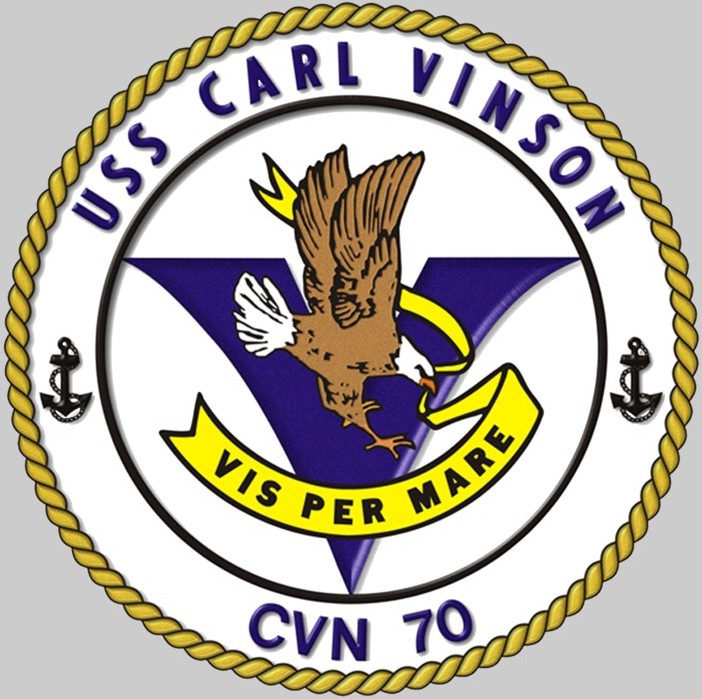 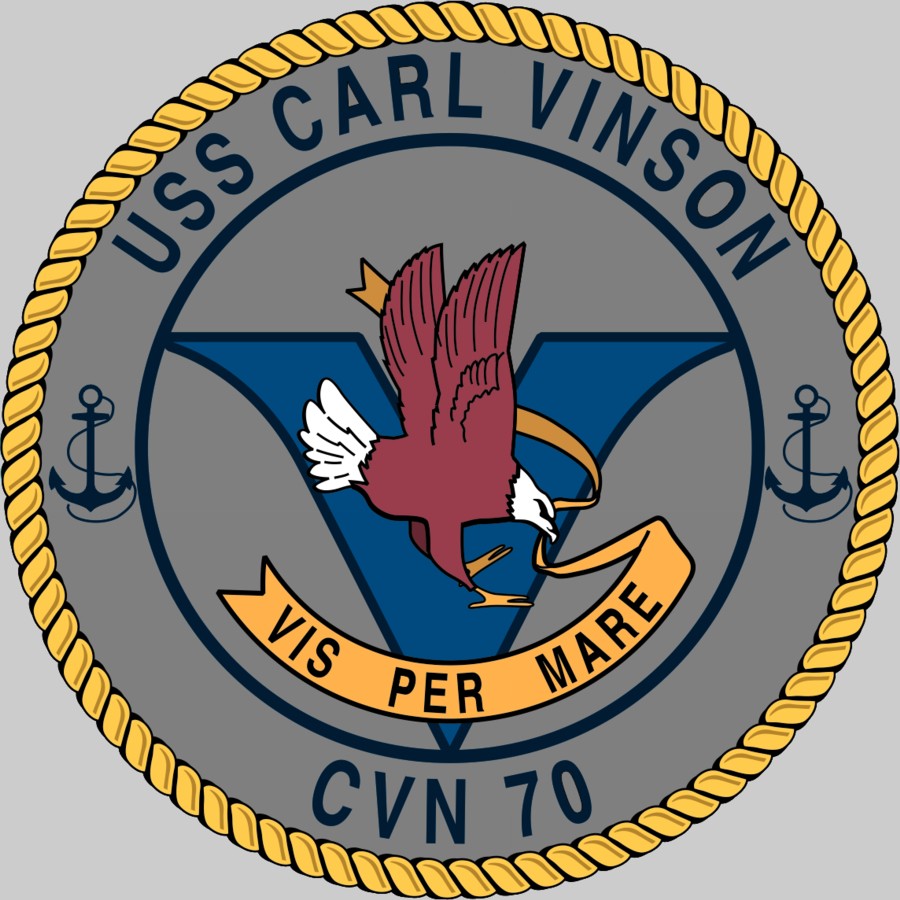 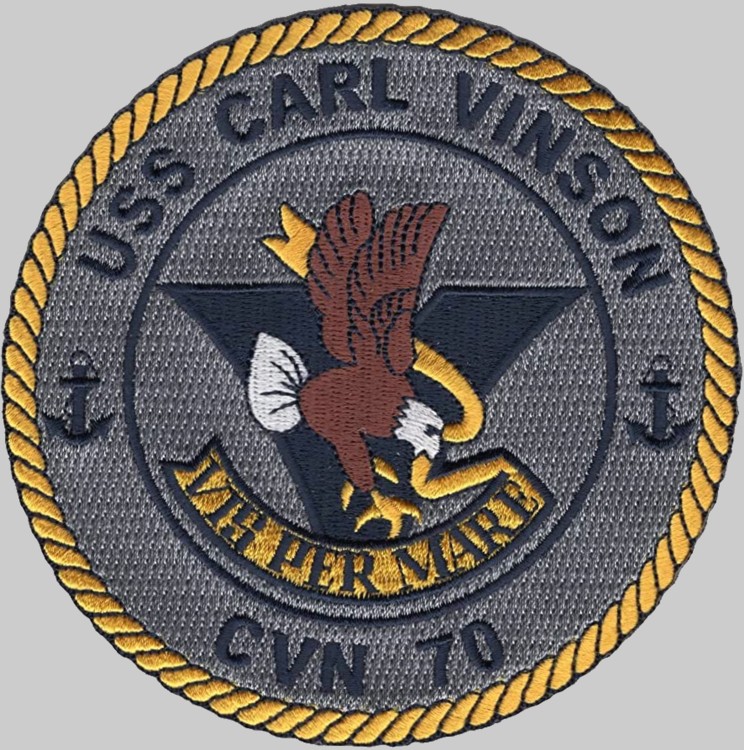 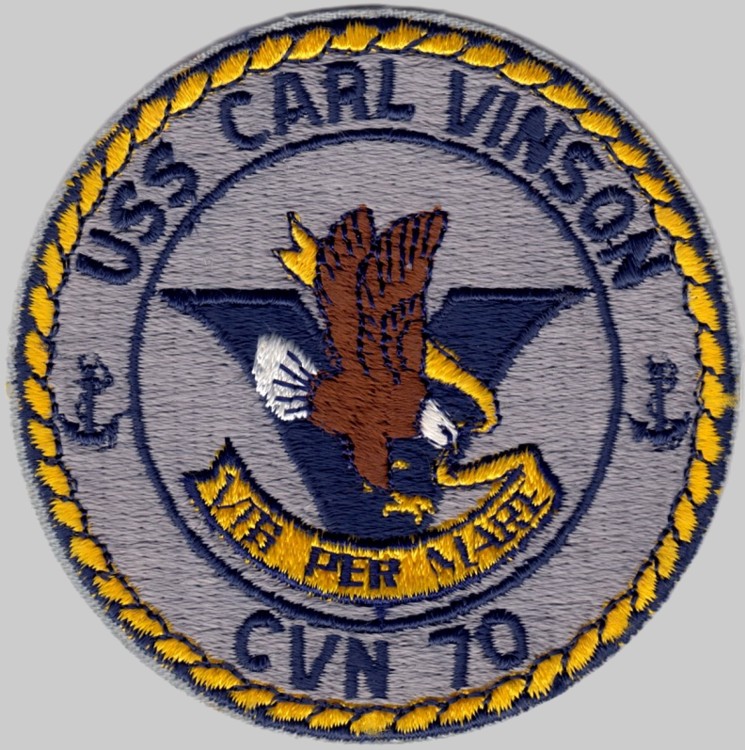 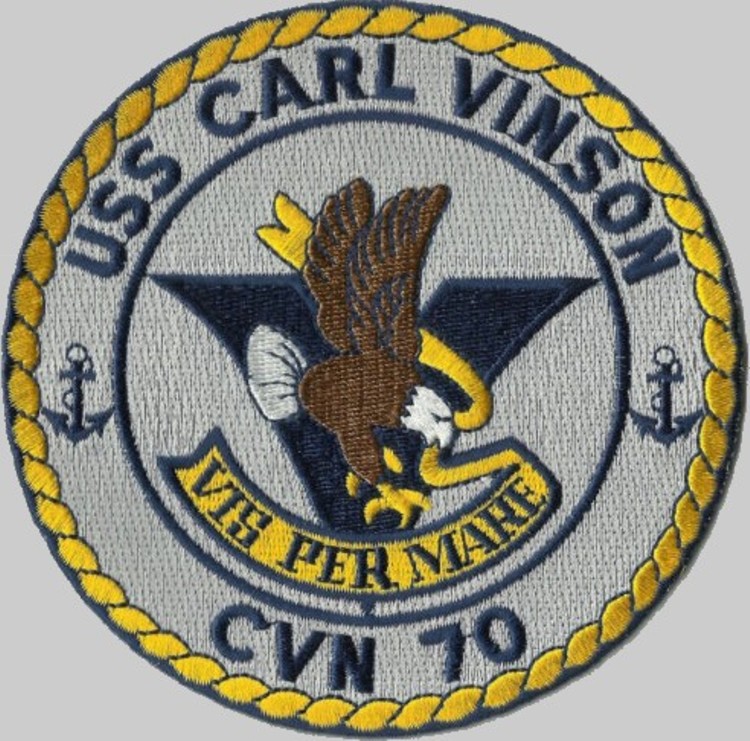 |
||
| | seaforces.org | USN ships start page | |
